- Stranger Things Season 5
- Deadpool and Wolverine
- The Batman 2
- Spider-Man 4
- Yellowstone Season 6
- Fallout Season 2
- The Last of Us Season 2
- Entertainment

The 10 best Star Trek: The Original Series episodes, ranked
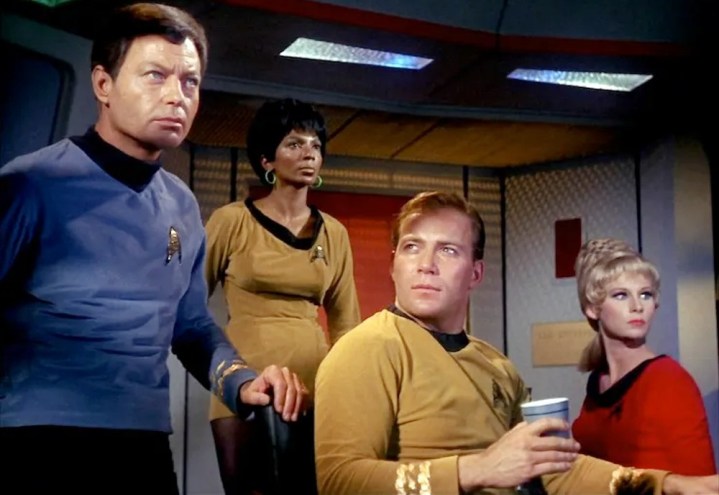
It’s hard to imagine today, but back in the late 1960s, the original Star Trek was not considered a hit. The ambitious science fiction series was constantly on the brink of cancellation and was cut short only three years into its planned five-season run.
10. Mirror, Mirror (season 2, episode 4)
9. a taste of armageddon (season 1, episode 24), 8. the menagerie, parts i and ii (season 1, episodes 12 and 13), 7. the doomsday machine (season 2, episode 6), 6. the corbomite maneuver (season 1, episode 11), 5. the devil in the dark (season 1, episode 26), 4. the trouble with tribbles (season 2, episode 15), 3. where no man has gone before (season 1, episode 4), 2. the city on the edge of forever (season 1, episode 29), 1. balance of terror (season 1, episode 15).
However, it’s important to put Trek ’s apparent failure into historical context as, given that most markets in the U.S. had only three television channels to choose from, even a low-rated show like Star Trek was being watched by about 20% of everyone watching television on a Thursday night, or roughly 10 million households. This year’s season of HBO’s Succession was viewed by roughly 8 million households a week , which makes it a hit by today’s standards. Star Trek ’s audience only grew once it went into reruns in the early 1970s, and by the time Star Trek: The Motion Picture hit theaters in 1979, it was a genuine cultural phenomenon. Today, the Star Trek franchise is considered one of the crown jewels of the Paramount library.
Though arguably outshined by its most prosperous spinoff, Star Trek: The Next Generation , Star Trek: The Original Series holds up remarkably well for a vision of our future imagined nearly 60 years in our past. It’s a space adventure series that tackles social or political issues from what was, at the time, a daring and progressive perspective informed by the contemporary civil rights movement, sexual revolution, and backlash against the Vietnam War. Conveying these values through fanciful science fiction didn’t only allow its writers to get away with a lot of subversive messages, it also delivered them in a way that remains fun to watch decades later — fun enough that fans are willing to forgive when its ideas, or its special effects, crumble under modern scrutiny.
- 7 best Star Trek villains, ranked
- 10 most underrated The X-Files episodes ever, ranked
- 10 best episodes of Star Trek: Enterprise, ranked
These 10 episodes, however, unquestionably stand the test of time, and thanks to the continuity-light nature of mid-20th century television, any one of them could be your first Star Trek episode. (Be aware, however, that the order in which classic Trek episodes are listed varies depending on the source. For our purposes, we’re using the numbering from streaming service Paramount+ .)
Even if you’ve never seen an episode of Star Trek , you’re bound to be at least a little familiar with Mirror, Mirror through cultural osmosis. In this 1967 classic, Captain Kirk (William Shatner), Dr. McCoy (DeForest Kelley), Lt. Commander Scott (James Doohan), and Lt. Uhura (Nichelle Nichols) are accidentally transported to an alternate universe, where they encounter dastardly evil versions of their beloved shipmates. Instead of the benevolent United Federation of Planets, this ship serves the fascist Terran Empire, which threatens to annihilate a peaceful planet for refusing to submit to itsrule. Our heroes are forced to pose as their evil counterparts while they search for a way home and try to avert the genocide they’ve been ordered to perform.
This all sounds heavier than it is — like much of classic Trek , Mirror Mirror is very camp, with brightly colored costumes, over-the-top performances, and a general sense of fun. The cast is clearly having a ball playing the wicked versions of their characters (or playing the good versions of their characters playing the wicked versions), and it’s no wonder why multiple future incarnations of Trek would return to the Mirror Universe, usually for wacky adventure episodes. (For a more grim and brutal take on this same concept, visit the back half of Star Trek: Discovery ’s first season.) However, Mirror, Mirror still comes complete with Trek ’s famous humanist optimism, as Kirk tries to convince this universe’s menacing, bearded Spock (Leonard Nimoy) that regimes ruled by fear are unsustainable and, therefore, illogical. Given enough time, peace and cooperation will always win out over hate and violence.
A Taste of Armageddon may not appear on many “Best Of” lists, but it’s 100% pure, uncut Star Trek . In this episode, Kirk and company visit Eminiar VII, a seemingly peaceful planet that is, in fact, embroiled in a centuries-long war with a neighboring world. Rather than fire actual bombs at each other, the combatants conduct simulated attacks, determine the hypothetical death toll, and then order the “dead” citizens to report to disintegration chambers. When Kirk and his landing party are recorded as casualties, they decide to put an end to Eminiar VII’s supposedly “civilized” method of warfare.
While Kirk arguably has no right to interfere with how this sovereign planet conducts its affairs, the point of A Taste of Armageddon is to reflect on America’s attempt to make constant military conflict more palatable, or even invisible to the average American. Or, in a larger sense, it’s a commentary on the ease with which a culture can become accustomed to death and violence, so long as it’s part of an established routine. Because these simulated bombings leave homes, industry, and even the military infrastructure itself totally unharmed, it’s easy to forget that Eminiar VII is even at war — that is, until it claims your life or the life of someone you love.
When even these losses are framed as necessary sacrifices to maintain normalcy, it minimizes the incentive to make peace. Kirk (and, by extension, writers Robert Hamner and Gene L. Coon) argues that war is revolting no matter how much you dress it up, and that it must be brutal, terrifying, and omnipresent for all involved, or else it will never stop. The past half-century of perpetual U.S. military intervention abroad has proven this thesis to be chillingly accurate.
If you’re watching Star Trek on Paramount+, you’ll notice that the episode it has listed as “season 1, episode 1,” The Cage , isn’t exactly the show you were expecting. Instead of the famous Captain James T. Kirk, the USS Enterprise is under the command of Captain Christopher Pike (Jeffrey Hunter), and apart from Mr. Spock — who smiles?! — the rest of the crew is also unfamiliar. That’s because The Cage is Star Trek ’s original pilot episode, which was rejected by NBC, leading to a second pilot being commissioned with a new cast and modified tone. The Cage wouldn’t air as its own episode until 1988, but during production of Star Trek ’s first season in 1966, a budget crunch led to writer/creator Gene Roddenberry repurposing footage from the already-completed pilot into a new script in the form of flashbacks.
This fiscally minded decision endowed Star Trek and its characters with a history, instantly making the universe a bigger and more interesting place. The two-part Menagerie sees Spock, the only remaining character from the original cast, commandeer the Enterprise for the sake of its previous captain, Christopher Pike. On the way to a forbidden planet, Spock uses mysterious footage from an adventure 13 years in the past to explain his rash actions.
If you’ve already watched The Cage , then The Menagerie will seem like a glorified clip show, in which Kirk and company spend half the runtime watching a previous episode. However, before the streaming era, The Cage was usually the last episode of The Original Series that a fan would see, rather than the first. In recent years, however, The Cage and The Menagerie have taken on a new role, as bookends to the adventures of Christopher Pike, as portrayed by Anson Mount on modern spinoff Star Trek: Strange New Worlds . Strange New Worlds (as well as the second season of Star Trek: Discovery ) take place after The Cage , but before The Menagerie , allowing us to get to know Kirk’s predecessor in his own context, as well as developing the bond between Pike and Spock that will eventually drive the Vulcan to mutiny. Even without any of this context, however, The Menagerie is an exciting two-hour event, an eras-spanning mystery that will make you wonder why NBC passed on the Star Trek pilot in the first place.
Due to the production constraints of 1960s television, the original Star Trek didn’t often aim for large-scale, awe-inspiring space action. The Doomsday Machine is the closest that classic Trek ever came to “epic,” and as compelling a story as it is, it’s also Exhibit A as to why such a thing was impractical with the resources available. Though its original effects required no small amount of ingenuity (they couldn’t afford to give their Enterprise model battle damage, so they bought one off the rack from a toy store and distressed it), the results look mighty corny on a modern high-definition television.
Still, the episode gained fame as boasting the largest-scale action of the series, as the Enterprise teams up with her badly damaged sister ship, the USS Constellation, to take on a huge planet-eating weapon. It also presages a theme that would become common in Star Trek feature films , as the Constellation’s grief-stricken Commodore Matt Decker (guest star William Windom) embarks on a foolhardy quest for revenge against the monster that bested him. (Trek would revisit Herman Melville’s Moby-Dick in Star Trek II: The Wrath of Khan and Star Trek: First Contact .)
The episode still works in a cheesy B-movie sort of way, which some fans would argue is the way it should still be enjoyed. However, when the series was remastered for high definition in the mid-2000s, the decision was made to recreate most of the special effects shots for the series using modern technology, since the originals were never expected to hold up to modern standards. Most of these recreations are very faithful, to the extent that uninitiated viewers might not even realize they’d been replaced. In the case of The Doomsday Machine , however, the producers and effects artists returned to the episode’s original script and attempted to realize writer Norman Spinrad’s initial vision for the space battle sequences. The team at CBS Digital doesn’t sacrifice the overall aesthetic of the series, but they do give us a peek at what The Doomsday Machine — and by extension, the entire Original Series — might have looked like with a feature film budget.
There may be no better introduction to the character of James T. Kirk than The Corbomite Maneuver . The first episode produced after the series was picked up (though it didn’t air until later in the season), The Corbomite Maneuver finds the Enterprise at the mercy of a massive alien vessel and accused of trespassing in its territory. Unable to outrun or outgun his mysterious adversary, Kirk does what he will later become famous for doing — he cheats. Or, rather, he changes the conditions of the contest from one of technological superiority to one of cunning and guile. In the process, we get to learn a bit about how each of the main characters handles the intense stress of a seemingly hopeless scenario, contrasted against the more relatable Everyman Lt. Bailey (guest star Anthony Call). Though the action rarely leaves the bridge of the Enterprise, it is, in its own way, one of the most thrilling episodes of the series.
Moreover, The Corbomite Maneuver sets the tone for Star Trek as a series. It’s an hour of adventure that is punctuated by moments of thoughtful introspection, warm friendship, and corny jokes. Its depiction of Starfleet and the Enterprise are clearly inspired by military tradition, but the message of the episode is one of compassion and patience rather than conquest. These are scientists, not soldiers, and while they experience fear and doubt, none of their human frailties are a match for their curiosity. If this is what the future of humanity looks like, we want to be a part of it.
When Star Trek is running on full thrusters, it is equal parts silly and profound. In The Devil in the Dark , the Enterprise is sent to the aid of a mining colony where workers are being hunted and killed by an unstoppable monster made of rock. We know that the monster is made of rock because the characters say so; It looks a lot more like it’s made of spray-painted Styrofoam and a shag rug. But as the tension rises and the mystery deepens, the goofiness of the rock monster becomes irrelevant, or even a boon to the story.
Though it begins as a hunt for a merciless alien creature, The Devil in the Dark becomes a story about prejudice and the universality of what we (in our limited earthly experience) would call “basic human rights.” This message is conveyed through cheesy 1960s TV production values and some very hammy acting, but the results are pure and unpretentious, the sort of storytelling that is equally impactful on a jaded adult and a wide-eyed child.
Here in the post-post-postmodern 2020s, we’re all total pros at deconstructing genre tropes. The practice of subverting the audience’s expectations as to what kind of story they’re watching or who the good guys and bad guys are wasn’t new in 1967, either, but in the sci-fi film and television of the era, the big scary monster is usually just a big scary monster. The Devil in the Dark exemplifies one of Star Trek ’s most enduring themes: that the unknown might seem terrifying, but if you take the time to understand it, it’s actually beautiful.
Star Trek is always science fiction, but its format offers a lot of flexibility in terms of how to interpret that genre. Even within the course of a single series or season, most Star Trek shows alternate between a variety of tones and secondary genres, from grim political drama to steamy romance, or in the case of this episode, kooky workplace comedy. The Trouble with Tribbles pits Captain Kirk and his gallant crew against their most stubborn foe yet — bureaucratic red tape. Assigned to look after a container of grain that Federation administrators insist is gravely important, the Enterprise becomes entangled in a very silly misadventure involving an invasive species of adorable, self-replicating furballs. For a captain accustomed to dealing with high-stakes diplomacy and galactic defense, this is his worst workweek ever.
As lousy a time as Kirk is having, The Trouble with Tribbles is tremendous fun. It is neither the first, nor the last broadly comedic episode of Star Trek , but it is the gold standard by which all Trek comedies are measured. Like any good Trek, it has stakes, a fun science fiction premise, and charming moments of character, but everything is set just a little bit askew, and the characters have noticed. It isn’t parody, it’s situation comedy, only a situation that you’re unlikely to find yourself in unless you’re the crew of a Federation starship. Almost every subsequent Trek series would chase that Trouble with Tribbles heat at least once ( Star Trek: Lower Decks is basically The Trouble with Tribbles: The Series ), with varying levels of success, but the original remains an untouchable classic.
After The Cage was rejected by NBC, Desilu Studios (under the leadership of comedy queen Lucille Ball herself) took a second swing at the series, with a new cast and a faster paced action-adventure story. This second pilot, Where No Man Has Gone Before , introduces William Shatner as Captain James T. Kirk, as well as George Takei as Lt. Sulu, James Doohan as Scotty, and Leonard Nimoy’s new, more stoic interpretation of science officer Spock.
The episode sees Kirk’s friend and mentee, helmsman Gary Mitchell (guest star Gary Lockwood), bombarded with cosmic radiation that grants him increasingly godlike powers. As Gary grows more dangerous and cruel, Kirk must weigh his love for his friend against his duty to his crew. The scenario immediately establishes the dynamic between Kirk and Spock (compassionate leader versus his coldly practical advisor), though Spock’s regular debate partner, the emotionally driven Dr. McCoy (DeForest Kelley), would not appear until Trek was ordered to series.
Where No Man Has Gone Before is a little less fun and colorful than the episodes that followed, with a tone more closely resembling heady 1950s sci-fi films like Forbidden Planet or The Day the Earth Stood Still . In a way, it’s the classic Trek episode that feels the most like Star Trek: The Next Generation ; It’s talky, deliberately paced, just a little bit sterile. In Where No Man Has Gone Before , the galaxy is not only wondrous, but also eerie and unsettling. Had this been the tone the series stuck with, it might not have become a global sensation, but as a single episode, it stands out as one of the very best.
To some Trekkies, ranking The City on the Edge of Forever anywhere but at No. 1 is unthinkable. This time travel tale – written by sci-fi author Harlan Ellison and then heavily revised by Trek story editor D.C. Fontana — won Star Trek its first Hugo Award, and is widely considered to be the finest hour in the history of the series, if not the franchise as a whole. The episode’s legendary status is well-deserved, but we don’t quite have the heart to declare it the ultimate Star Trek episode, on account of how little of it takes place in the 23rd century or aboard the Starship Enterprise. The City on the Edge of Forever is an outlier, and as such, naturally stands apart from the pack, giving it an edge in any conversation about Star Trek . Its placement here at No. 2 is sort of a counter to that advantage.
Make no mistake, however — despite mostly being set in New York in the year 1930, City on the Edge is Star Trek to its core. Sent back in time to correct an accidental alteration of Earth’s history, Kirk and Spock take up residence in a homeless shelter run by idealistic philanthropist Edith Keeler (guest star Joan Collins). Keeler turns out to be the key historical figure whose destiny must be fulfilled, but there’s a problem — Kirk has fallen in love with her. This romance complicates the mission, as Kirk and Spock are confronted with a grave moral dilemma with their entire reality hanging in the balance. Keeler is a visionary who believes in the beautiful future that Kirk calls home. But, in order for that future to exist, must something terrible be allowed to happen in her present? It’s an emotionally gripping tale that, if it had been told on a modern television show, would have changed its characters forever.
Star Trek is built on a central contradiction. It’s an adventure series about officers in a fleet that we are told, unconvincingly, is not a military organization, aboard a vessel that carries enough firepower to demolish a continent. It’s a show about peace in which things have a habit of blowing up. To reconcile this cognitive dissonance, one need only look to this key episode of The Original Series , Balance of Terror . In this early chapter, the Enterprise witnesses an Earth base being destroyed by an old enemy, the Romulan Empire. The Romulan ship has the ability to become invisible both to scanners and the naked eye, and attempts to escape to its own side of the neutral zone between their two territories before it can be apprehended.
The Enterprise is ordered to capture or destroy the Romulans before they make it home. Whether or not they succeed, there may be war. Kirk has his orders, and as we soon discover, so does the Romulan commander (guest star Mark Lenard), who is no happier about this turn of events than Kirk is. Throughout the episode, we cut back and forth between the action on the Enterprise and aboard the Romulan vessel, as two keen military strategists attempt to outmaneuver each other and stay alive, both locked in a struggle they’d rather had never begun.
Balance of Terror is a sci-fi twist on a submarine battle, but more than that, it’s a commentary on war, the rivalries between nations, and the wounds and prejudices they create. The Enterprise isn’t loaded with photon torpedoes because Starfleet is itching for a fight — it’s armed because sometimes it has to be, and when Kirk and his crew ride into battle, there’s nothing glorious about it. On the other side of any conflict is a person or people who have their own mission, their own values, and perhaps even their own reservations about fighting. It is not possible to avoid every fight, to preempt every war with diplomacy. But when blood is shed, there is no victory and there are no winners. There is tragedy, and there are survivors. And, finally, there’s the hope that the next time these two nations clash, they’ll be a little more willing to talk to one another.
Editors' Recommendations
- 10 best sci-fi TV shows of all time, ranked
- 7 best Star Trek parodies, ranked
- The 10 best episodes of The Sopranos, ranked
- 10 best Buffy the Vampire Slayer episodes, ranked
- 10 best sci-fi TV characters ever, ranked

It's been a long hiatus for Doctor Who fans, but the series is back with a new 60th anniversary special called Doctor Who: The Star Beast. This is the first of three specials that will feature the Tenth Doctor performer David Tennant appearing as a new Fourteenth Doctor. Tennant's Doctor is also joined by Catherine Tate's Donna Noble, his former companion from the fourth season.
The Doctor has had numerous companions for his time travel adventures over the last six decades. But when compiling this list of the seven best Doctor Who companions, we decided to stick with the companions from the modern revival series that started in 2005. There is only one exception to that rule, and that's because the character in question had the unique chance to play a major role in both classic Doctor Who and in the modern era. But if you want to know who landed the top spot, you'll have to keep on reading. 7. Captain Jack Harkness
In the Futurama episode Where No Fan Has Gone Before, the wisecracking robot Bender describes Star Trek as having “79 episodes — about 30 good ones.” And, if we're being honest, Bender's not wrong. Across the franchise, there are now roughly 900 canonical installments, and out of a field that large, there are naturally dozens, even hundreds of entries that you can simply disregard. Of course, like any fanbase, Trekkies contain multitudes, and we don’t all agree on which episodes deserve the scrap heap. One fan’s space junk is another fan’s latinum, and there’s no accounting for taste. We’ve selected ten episodes from across the history of the franchise that some fans might tell you to skip, but that we think deserve your attention. Is one of your dark horse faves on our list? Have we gone to bat for an episode you wish would be erased from the space-time continuum? Follow us to the salvage yard and find out…
10. The Time Trap (TAS season 1, episode 12)
This year marks the 30th anniversary of The X-Files, one of the most popular genre shows in the history of network TV. Over the course of nine seasons, from 1993 to 2002, series creator Chris Carter and his team of writers took viewers inside some of the strangest and the most horrifying cases of the paranormal that they could imagine. Anything from aliens to demons and monsters was in play, while the show developed its own mythology and an overarching story.
In honor of the show's 30th anniversary, we're looking back at the 10 best episodes of The X-Files and ranking them from worst to best. Unlike some of the previous best-of lists for this show, we're not focusing only on the standalone episodes or the monsters-of-the-week installments. It's become fashionable to bash the show's mythology episodes because Carter and Company couldn't bring the story to a satisfying resolution. But those episodes were a large part of the reason why this show was so fantastic in its prime, and it would be a disservice to the series itself if we didn't give those stories their due. 10. Requiem (Season 7, Episode 22)
The 20 Best Episodes of ‘Star Trek: The Original Series’
If you’re looking to get into the ‘Trek’ that started it all, start here.
In the more than 50 years since Star Trek made its debut on NBC, the franchise has seen more than a dozen feature films and successfully launched its sixth spinoff series last year with CBS All Access’ Star Trek: Discovery . For all the many amazing stories told in the decades to come, it’s hard to beat the original Star Trek . Running for just three seasons, the series has become synonymous with the science fiction genre and emerged a cultural touchstone that has entertained, educated and inspired dreamers all over the world.
Like any series, Star Trek has its ups and downs. The best episodes, though, rank among television’s very finest. We’ve assembled a list of Star Trek ’s 20 best original series episodes, each of which has withstood the test of time in delivering stories that, despite their spectacle and imagination, are ultimately about exploring the human condition. As such, many of the themes explored on Gene Roddenberry ’s show have only become more relevant and the show’s 23 rd century setting all the more important a future to which we might aspire.
20) The Menagerie - Parts One and Two
The only two-part episode of the original Star Trek , “The Menagerie” is, in a weird way, a kind of clip show. Before William Shatner was cast as Captain James T. Kirk, Star Trek had shot a pilot, “The Cage,” starring Jeffrey Hunter as Captain Christopher Pike. In fact, the only character to carry over from the unaired pilot was Leonard Nimoy’s Spock. Naturally, he’s front and center of “The Menagerie,” a Starfleet courtroom drama in which Enterprise logs are used as evidence, allowing the entirety of “The Cage” to be incorporated into a larger story set some years later.
Hunter did not reprise the Pike role, the episode finding the character having just suffered an accident that has left him a scarred shell of his former self. With a mysterious motivation that is revealed through the course of his trial, Spock abducts Pike and commandeers the Enterprise. With a course locked to a forbidden planet, Spock calmly turns himself over for his court martial, giving the narrative a fantastic ticking clock.
“The Menagerie” arrived midway through Star Trek’s first season and its expansion of Star Trek lore is, in part, why the franchise continues to this day. Bringing “The Cage” (released some years later on its own) into Star Trek continuity paved the way for future Captains of the Enterprise and reminded us that Star Trek’s timeline doesn’t necessarily need to proceed linearly.
Anyone familiar with Star Trek from the J.J. Abrams films also got to meet Captain Pike. Bruce Greenwood played the part in both 2009’s Star Trek and 2013’s Star Trek Into Darkness .
19) The Corbomite Maneuver
Although it aired out of sequence, “The Corbomite Maneuever” followed Star Trek ’s first two pilots with a story that sees the Enterprise coming into contact with a mysterious and powerful alien sphere in an unexplored area of space. Diplomacy soon fails and a strange looking creature, Balok, tells Kirk that his ship will be destroyed. That’s when Kirk comes up with an epic bluff, aiming to convince the alien that the Enterprise contains a made up element, corbomite, that promises mutually assured destruction.
The notion of bluffing is huge in Star Trek and “The Corbomite Manuever” is the most classic example. A bluff, after all, means applying fiction to create a better reality. In a nutshell, that’s exactly what Star Trek is all about. Over the course of the series, the crew of the Enterprise will use their unique perspective to defy the laws of alien civilizations, Starfleet’s own bureaucracy and even of physics themselves. It’s usually about knowing the right time to do the wrong thing and, of that, Captain Kirk is a proven master. He knows exactly when to bend the rules to achieve the greater good.
“The Corbomite Maneuver” also introduces a common theme that alien races aren’t necessarily as alien as they might appear with a final act that features a young Clint Howard .
18) A Piece of the Action
It may sound a bit silly, but the Enterprise’s visit to a planet ruled by 1920’s Chicago gangsters is a whole lot of fun. It even makes a bit more sense than it sounds: a hundred years before this episode takes place, another ship, the Horizon, wound up bringing a book about Chicago mobsters to the planet’s highly suggestible inhabitants, the Iotians. Treating it like a bible, the entire culture adapted to suit the book.
There’s a lot of costume play throughout Star Trek history and seeing Kirk and Spock in gangster outfits is a whole lot more fun than say, the time they have to dress up the Nazis in the second season episode “Patterns of Force”. “A Piece of the Action” would serve as a prototype for Star Trek: The Next Generation ’s holodeck episodes and open the idea that any planet anywhere in the universe could theoretically have a culture identical to any period on Earth.
An abandoned plotline for a 30 th anniversary episode of Star Trek: Deep Space Nine (later told in alternate form in a Star Trek comic) would have seen a return to the Iotian planet and the reveal that, following the events of “A Piece of the Action,” the planet wound up being so heavily influenced by the Enterprise’s visit that it had evolved to become, essentially, a planet of classic Star Trek fans.
17) The Squire of Gothos
Several episodes of the original Star Trek find the crew coming face to face with seemingly omnipotent foes, but few are as quite as memorable as William Campbell ’s performance as the ebullient mischief maker Trelane, self-professed “Squire of Gothos”. When the Enterprise discovers a planet in an area of space that should be abandoned, the crew is drawn to the world’s sole inhabitant, a godlike individual fascinated with 18 th century Earth history who views the crew as nothing more than his playthings.
From Loki of Greek mythology to DC Comics’ Mr. Mxyzptlk, the trickster god is a classic foe. Part of what makes it work so well in the world of Star Trek is because the crew of the Enterprise, to us, appears so advanced technologically. As was the case with foes like Thor or Superman, having an even more powerful foes forces the heroes to rely on their wits alone, ultimately proving that omnipotence is nothing without intelligence and compassion.
Trelane also helped pave the way for John DeLancie ’s Q on Star Trek: The Next Generation . Appearing in more than a dozen episodes of subsequent Star Trek series, Q shares Trelane’s paradoxical blend affability and obnoxiousness. While it’s never specified in the canon, stories told in Star Trek books and comics have connected the characters.
16) Day of the Dove
The Enterprise responds to a distress call only to find a deserted planet and Klingon forces nearby. When both ships somehow become disabled, tensions begin to mount to an unusual degree. Walter Koenig ’s Chekov is threatening to avenge the death of his brother at the Klingons’ hands. But then it’s revealed that he doesn’t even have a brother. Things get weirder and weirder as the planet itself seems to encourage conflict, supplying weapons and easy reasons to give into hatred.
It’s never revealed exactly what the force is that both crews encounter on planet Beta XII-A, but it seems to be a destructive energy that is, perhaps, a manifestation of destructive energy itself, depicted as a crackling red force. When Kirk realizes that he and Michael Ansara ’s Klingon commander Kang are being manipulated, “Day of the Dove” gives us one of William Shatner ’s great mini-monologues.
“All right. All right,” Kirk shouts at Kang. “In the heart. In the head. I won't stay dead. Next time I'll do the same to you. I'll kill you. And it goes on, the good old game of war, pawn against pawn! Stopping the bad guys. While somewhere, something sits back and laughs and starts it all over again.”
That’s a message that, sadly, is every bit as timely today as it was half a century ago.
15) The Galileo Seven
Things go bad during a routine science mission, forcing a shuttlecraft, the Galileo, to make an emergency landing on a dangerous planet, home to enormous apelike beasts. What’s more, a coming ion storm and trouble in another part of the galaxy mean that the Enterprise may need to give up the search.
While there’s some great Kirk moments as he squeezes every possible opportunity from the chain of command to keep looking for the Galileo, this episode is Spock’s show. We get to see him take command over a six-person crew and deal with having to give orders that put officers in mortal danger. Fear amongst the crew makes things all the more dangerous as Spock has to face officers who question his Vulcan logic and, ultimately, his own uncertainty in command to save the crew.
The plot for “The Galileo Seven” originated with Oliver Crawford , who co-wrote the episode’s script with S. Bar-David . He has said that “The Galileo Seven” was directly inspired by the 1939 big screen thriller Five Came Back , about a small airplane that crashed in a South American jungle.
14) A Private Little War
Star Trek was offering a direct allegorical take on the Vietnam War in 1968 with a story that finds Captain Kirk in a moral dilemma. A planet of immense natural resources, Neural, is home to a primitive race. Although Starfleet’s Prime Directive would normally preclude any interference, the Enterprise learns that conflict has broken out among the natives with one side being given advanced weaponry by the Klingon Empire.
While the Enterprise quite often finds itself in the position of having to balance moral imperatives, “A Private Little War” is the best example of the show taking on a contemporary political issue, even if the conclusion doesn’t offer any easy answers.
“A Private Little War” also introduces a memorable Star Trek alien that only appears in this one episode. The Mugato is a ferocious white ape with a spiked back and a poisonous bite. Ben Stiller , a big Star Trek fan, borrowed the name for Will Ferrell ’s character in his 2001 comedy Zoolander .
13) Journey to Babel
The Enterprise is journeying to the planet Babel for a diplomatic conference when one of the visiting ambassadors is murdered. The lineup of suspects includes a wide range of alien dignitaries and one chief suspect: Mark Lenard ’s Vulcan ambassador Sarek. Adding to the drama, Sarek just happens to be Spock’s estranged father.
Not only is “Journey to Babel” an interesting mystery with a grand assembly of interesting alien species, it reveals so much about Spock and his history with his father. It’s a relationship that continues to develop for decades after “Journey to Babel”. Lenard returns as Sarek throughout the franchise’s big screen run and beyond. He’s even set to be a featured character in Star Trek: Discovery with James Frain filling in for the late Lenard.
Before he played Sarek, Mark Lenard famously took on the role of another prominent Star Trek character. Look for details on that performance a bit further down this list.
12) Let That Be Your Last Battlefield
The Enterprise intercepts a stolen shuttlecraft containing Lou Antonio’s Lokai, a fugitive from a planet called Charon. Although he looks like a human being, Lokai is split down the middle, one side black and the other white. It’s not long before Frank Gorshin shows up as Bele, a fellow being from Charon who utterly despises Lokai. Although they may initially appear identical, it is revealed that Bele and Lokai are alternately colored. Bele is black on the left side and white on the right while Lokai is the reverse. Hence, in their culture, their hatred for one another.
With “Let That Be Your Last Battlefield,” Star Trek finds a way to tell a story that isn’t just about racism, but that makes racism itself the focal point for its sci-fi lens, imagining a brand new way to hate and making a powerful reminder that any reason for doing so based on any other physical attribute is just as unnatural.
11) The Doomsday Machine
The crew of the Enterprise faces one of its most awesome cosmic challenges when it comes up against a massive, world-eating device of extreme alien origin. In fact, the device is so alien that we never really learn what it is, although Kirk theorizes it to be an ancient doomsday device. The Enterprise isn’t the first Starfleet ship on the scene this time, either. By the time the Enterprise discovers the danger to the galaxy, the USS Constellation has already risked everything in an attempt to stop the planet killer. The Constellation is recovered by the Enterprise with only one crewmember still left alive, William Windom ’s Commodore Matt Decker.
Not only does “The Doomsday Machine” feature such a memorable monster, it features some great drama between Kirk and Decker. Having just lost his crew to the cosmic goliath, the Commodore is suffering from severe posttraumatic stress and not necessarily thinking with a clear head. Because he technically outranks Kirk, that poses a serious problem in dealing with the matter at hand.
“The Doomsday Machine” also sets up a nice bit of continuity with Star Trek: The Motion Picture . One of the main characters in the 1979 Robert Wise film is Stephen Collins ’ Captain Willard Decker, the son of Commodore Matt Decker.
10) The Devil in the Dark
Something is killing workers on distant a mining colony visited by the Enterprise. Deep in the caves of Janus VI, a rocklike creature is melting people alive with its molten abilities. Despite the attacks, though, there’s no trace of the creature and no understanding for how a carbon based life form could exist in such an environment.
“The Devil in the Dark” functions as both a sci-fi slasher and a moral tale. The end of the episode reveals that life sometimes manifests itself in forms that we may not have ever considered, brought to life visually when Spock performs a Vulcan mind-meld with the alien creature, a horta, and learns that its motivations are not malicious and that, instead, it is the miners who have unwittingly done a great wrong to it.
Although the horta marks another iconic Star Trek alien, “The Devil in the Dark” is their sole appearance of the species the franchise outside of very minor nods in later spinoffs.
9) By Any Other Name
The Enterprise encounters a pair of scouts from the Kelvan Empire, mighty beings from the Andromeda Galaxy who want to use the Starfleet vessel on a generational voyage to their homeworld. Armed with powerful belts that can, among other things, transform people into easily destroyed little polyhedrons of their basic genetic makeup, they easily take the ship. Only a few officers are left in their human form and it’s humanity that, as it often does, gives the Enterprise crew their edge. Because the Kelvans have taken human form for their journey, they’re not used to some of the finer points of being human.
“By Any Other Name” has James Doohan ’s Scotty teaching the male Kelvan about alcohol while Kirk teaches the female one about love. There’s a major degree to which Star Trek celebrates the clash of human and alien cultures and here we get to see the whole crew doing so to the best of their specific abilities.
The work of William Shakespeare is something referenced quite a bit throughout the Star Trek franchise. This episode references a line in Romeo and Juliet wherein Juliet argues that a rose is a rose because of the form it takes and not what it’s called. Star Trek expands that idea with the suggestion that anything in the form of mankind will, in doing so, become mankind.
8) A Taste of Armageddon
“A Taste of Armageddon” offers a brilliantly high concept sci-fi plot: the Enterprise visits a world that has evolved beyond destructive combat, but not beyond war itself. Instead of destroying one another with weapons that would threaten to also destroy their culture, the conflicting sides of Eminiar VII’s population have agreed to wage war through a highly accurate simulation. If a resident is in an area that the simulation has deemed destroyed, he or she is expected to immediately turn themselves in for disintegration. Unfortunately, a few Enterprise crewmembers are unwittingly present when a building is marked destroyed and their refusal to surrender their lives could mean that a more destructive form of war returns to the planet.
Most of the time, the crew of the Enterprise comes across planets whose values aren’t quite up to date with those held by the enlightened Starfleet. Here, though, the crew is forced to deal with a planet that actually makes a pretty good point and achieved what seems to be far less destructive form of combat. Kirk makes an interesting argument, however, suggesting that the people of Eminiar VII have, in attempting to mute the destructive effects of war, helped mute the horror of it as well. By the time the credits roll on “A Taste of Armageddon,” you won’t be wrong if you’re not exactly thinking of Starfleet as the good guys this time.
7) Space Seed
“Space Seed” introduced Star Tre k’s most famous antagonist, Ricardo Montalban ’s genetically enhanced 20 th century superman Khan Noonien Singh. The Enterprise comes across a long-lost vessel, the Botany Bay, that contains Khan and 84 of his crew. Soon, Khan is using his enhanced cunning to take control of the Enterprise.
One of the reasons Khan works so well as a foil for Kirk is because he’s both physically and mentally superior to the Starfleet Captain, but also shares Kirk’s charisma. He’s an easy bad guy to root for and his backstory raises some interesting questions about what Earth’s Eugenics Wars were like in the 1990s.
While “Space Seed” is Khan’s sole appearance in the series, Montalban would famously reprise the role for Nicholas Meyer ’s Star Trek II: The Wrath of Khan in 1982. Benedict Cumberbatch would then play an alternate reality version of the character in Star Trek Into Darkness .
The Enterprise comes into territorial conflict with the Gorn, a race of reptilian creatures with whom Starfleet has never dealt. When conflict threatens to breaks out with the Gorn ship, both vessels are disabled an incredibly powerful race called the Metrons. To settle the issue, the Metrons will have Captain Kirk face off against the Gorn captain on a rocky desert planet. Even though the Gorn easily outmatches the Starfleet Captain physically, Kirk has a few tricks up his sleeve.
As with “A Taste of Armageddon,” “Arena” focuses on a transference of a larger conflict into a smaller one. While the former dealt a bit more with the ethics in doing so, “Arena” places more like a sporting event. On the bridge of the Enterprise, the crew is helpless to do anything but watch as Kirk and the Gorn captain battle to the death.
“Arena” has become one Star Trek’s most famous episodes primarily due to its incredible Gorn costume. While it has a degree of 60s sci-fi cheese, it still looks quite a bit better than attempts to later bring back the Gorn species with CGI on Star Trek: Enterprise .
5) The Trouble with Tribbles
One of Star Trek’s most famous episodes brings the Enterprise to Space Station K-7 where there is some fear that visiting Klingons might disrupt the delivery of much a needed grain to an Earth colony. Meanwhile, Nichelle Nichols ’ Uhura goes shopping and purchases a Tribble, a small purring creature that looks like a ball of hair. Unfortunately, it turns out that Tribbles are born pregnant and they begin to multiply exponentially.
“The Trouble with Tribbles” is a fairly light-hearted adventure that also feels like a day in the life for the crew of the Enterprise. Kirk’s attempts to deal with Federation politics wind up taking a back seat to the tribble problem as a memorable Star Trek species is born.
For the franchise’s 30 th anniversary, Star Trek: Deep Space Nine would return to “The Trouble with Tribbles” with an episode called “Trials and Tribble-ations”. In it, the crew travels back in time to prevent a plot to assassinate Captain Kirk during the events of “The Trouble with Tribbles,” digitally inserting actors into the background of the original episode with an adventure that makes use of impressive visual effects to tell a concurrent narrative.
4) Mirror, Mirror
Quite arguably the definitive pop culture example of parallel realities, “Mirror, Mirror” finds Kirk, McCoy, Scotty and Uhura in a transporter accident that swaps them with their counterparts from an alternate timeline. While the Enterprise is negotiating for dilithium on behalf of the United Federation of Planets in the regular timeline, the alternate history sees an aggressive Enterprise take the valuable resources by force in the name of the Terran Empire.
“Mirror, Mirror” is particularly famous for having a goateed Spock in the mirror universe. The “evil” goatee has become iconic in pop culture to represent all kinds of evil twins and alternate reality doppelgangers.
Although there were several novels and comic books that made use of the Mirror Universe, it would be nearly three decades before the timeline would return in the official Star Trek canon. The second season Star Trek: Deep Space Nine episode “Crossover” would make visits to the parallel timeline a nearly annual event for the spinoff series.
3) Balance of Terror
When the Enterprise encounters a Romulan vessel, the two ships come into combat and soon leave one another disabled and floating in space. Each races to make repairs before the other to claim victory in an encounter that reveals surprising new details about an old Starfleet foe.
In the Star Trek timeline, Earth experienced a brief but intense war with the Romulan Star Empire about a century earlier. Because the combat occurred in space, Earth never learned what Romulans look like. Here, it’s revealed that they’re a warlike offshoot of the Vulcan species, leading to some immediate tension between Spock and one of his crewmates.
A throwback to submarine thrillers like The Enemy Below and Run Silent, Run Deep , “Balance of Terror” is elevated by Mark Lenard’s pre-Sarek appearance as the commander of the Romulan vessel. As the viewpoint shifts from the Enterprise to the Romulan vessel, we find that he and Kirk are not so different in their adherence to their duty.
2) Amok Time
The first episode of Star Trek ’s second season reveals a Vulcan secret. Every seven years, the species goes through a mating cycle in which they must return to Vulcan and take a mate. Unfortunately, Spock’s would be mate demands the koon-ut-kal-if-fee, a battle to death between her suitor and a champion of her choosing. When she chooses Captain Kirk, both officers must fight in a Vulcan ceremony that will not end until one of them is dead.
Not only does “Amok Time” deliver on its promise of an epic Kirk vs. Spock fight to the death, but it’s a great example of Spock growing to trust and appreciate his crewmates. It’s an intensely personal story for Spock and it culminates with a fantastic line from the character.
“After a time,” Spock tells a Vulcan woman who has rejected him in favor of another suitor, “You may find that having is not so pleasing a thing after all as wanting. It is not logical, but it is often true.”
For that line alone, “Amok Time” deserves its honored place in Star Trek history.
1) The City on the Edge of Forever
It’s pretty much universally understood that the penultimate episode of Star Trek ’s first season is the franchise’s very finest story. Having accidentally injected himself with a drug that drives him crazy, DeForest Kelley ’s Dr. McCoy beams down to an alien planet where an ancient gateway, the Guardian of Forever, allows passage through time and space itself. A crazed McCoy travels back to Earth in the 1930s and does something that stops Starfleet from having ever existed. With no other choice, Kirk and Spock travel back themselves in the hopes of restoring the timeline.
It’s in the 1930s that Kirk and Spock meet Joan Collins ’ Edith Keeler a thoroughly lovely young woman who has dedicated herself to helping the less fortunate in a New York Mission. As they search for McCoy, Kirk begins to develop a relationship with Edith. And then the bad news hits: in order to fix the timeline, Edith Keeler must die.
The need for Edith Keeler to die is made all the more tragic by the fact that she’s not in any way a bad person. Spock explains that her success at organizing a pacifist movement in the United States will lead to the United States delaying its entrance into World War II. It is peace that she’s fighting for and in the name of peace that she must be sacrificed.
“The City on the Edge of Forever” is, simply, the epitome of what science fiction has to offer, bolstered by an original script by legendary author Harlan Ellison and a perfect romance between William Shatner and Joan Collins.
“Let me help,” smiles Kirk to Keeler as they a New York street together, he comments on her choice of words. “A hundred years or so from now, a famous novelist will write a classic using that theme. He'll recommend those three words, even over 'I love you’.”
For all the franchise’s many adventure across space and time, none come quite close to the simple, tragic elegance of “The City on the Edge of Forever”.
The 10 best Star Trek: The Original Series episodes of all time
Boldly go where no binge-watcher has gone before.
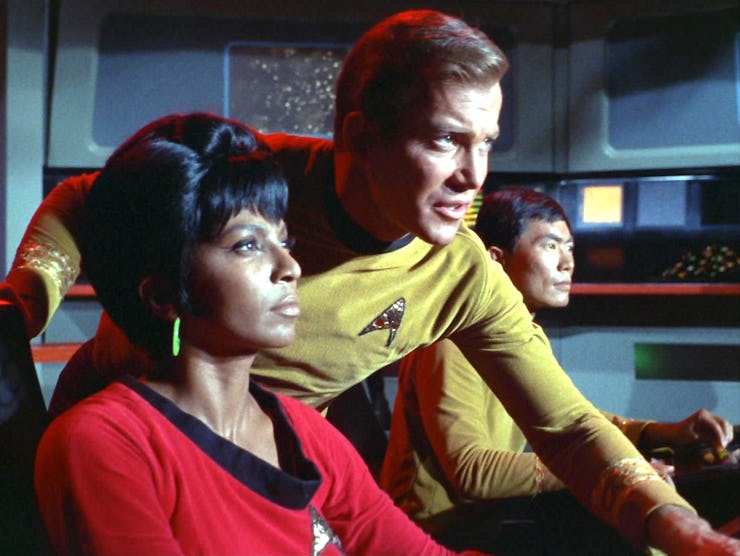
Star Trek took televised sci-fi mainstream.
That isn’t hyperbole. It’s historical fact. While shows like The Outer Limits, The Twilight Zone and Lost in Space preceded Star Trek , none of those shows broke through and created a fandom as widespread and enduring as the original adventures of the starship Enterprise .
Since 2011, Netflix has made Star Trek: The Original Series available for streaming in the US. But that era will end on September 30, 2021.
If you’re a sci-fi fan, or even a Star Trek fan who has never really delved into The Original Series , this is your last chance to watch the show on Netflix. Out of the 79 installments in TOS , which episodes should you actually binge?
To get a good sense of what The Original Series is actually like, here are 10 essential episodes. These might not be everyone’s “best” episodes of TOS , but if you watch these ones in this exact order, it’s the fastest hack to get at what all the Trekkie fuss is about. Only mild spoilers ahead for Star Trek: The Original Series .
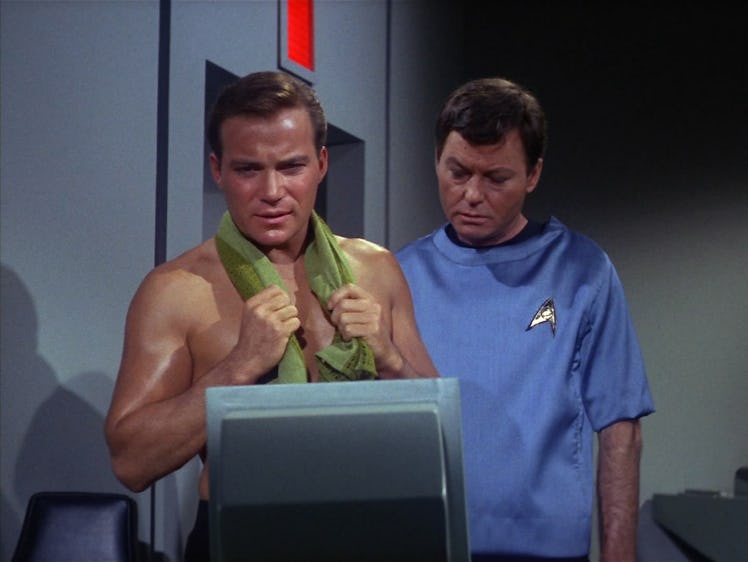
Kirk and Bones get ready to boldly go.
“The Corbomite Maneuver”
On Netflix: Season 1, Episode 11
Netflix wants you to start watching TOS with “The Cage.” Resist! This is not a great way to start the series.
“The Cage” was an unaired pilot for Star Trek , later retconned into a flashback within the episode “The Menagerie.” While some fans may argue you’ll want to watch “The Cage” to get the backstory of the series, starting with “The Cage” will just confuse you as to why people like this show. Tonally, it’s nothing like the rest of TOS . And the cast, other than Leonard Nimoy as Spock, is totally different.
For this reason, start with “The Corbomite Maneuver.” Why? Well, even though it was the 10th episode ever aired, this episode was the first regular episode ever filmed. Unlike the two pilot episodes (“The Cage” and “Where No Man Has Gone Before”) the actors in this episode are, for the most part, in the roles we know and love them for. The episode begins with Spock saying something is “fascinating” and then, after the title credits, Kirk is walking around without his shirt. The vibe of this episode is amazing, the tension is excellently handled, and the final twist is utterly absurd. This is what classic Trek feels like.
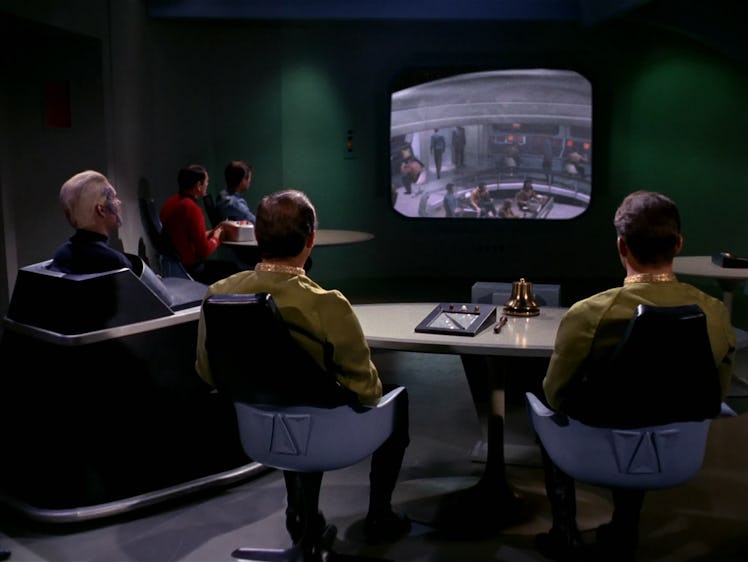
The earliest instance of people on Star Trek watching Star Trek.
“The Menagerie Parts 1 and 2”
On Netflix: Season Episodes 12 and 13.
Here’s where you can get your dose of “The Cage” and fully understand Spock’s relationship to his captain before Kirk: Captain Christopher Pike. Although this is a two-part episode, the time pretty much flies by.
Because Strange New Worlds comes out in 2022, this story is essential to understanding where Spock was before TOS , not to mention who the hell Number One is. The way this episode frames “The Cage” in the context of the regular series is also super-smart; basically, the regular characters watch parts of another episode of Star Trek.
Also, across the franchise, any Star Trek episode that involves a courtroom drama of some kind is usually a winner. Weirdly, combined with “Amok Time,” this episode might lead you to believe that Spock tries to hijack the Enterprise all the time. He doesn’t. But it sure seems that way.

Spock being awesome in the phaser control room.
“Balance of Terror”
On Netflix: Season 1, Episode 15
Everyone loves to talk about the Klingons in Star Trek , but before the Klingons were ever introduced, the first and best big Trek baddies were the Romulans. As episodes of TOS go, “Balance of Terror” is tightly plotted and emotionally affecting.
Because long-time fans take this episode for granted, we tend to forget about the innovative reveal of the Romulans in general. If you don’t know why the reveal about the Romulans is huge, I won’t spoil it here. Let’s just say it was very gutsy for TOS to create an evil empire that had very close ties to one of its greatest heroes. Also, the slow-burn spaceship battles absolutely slap.
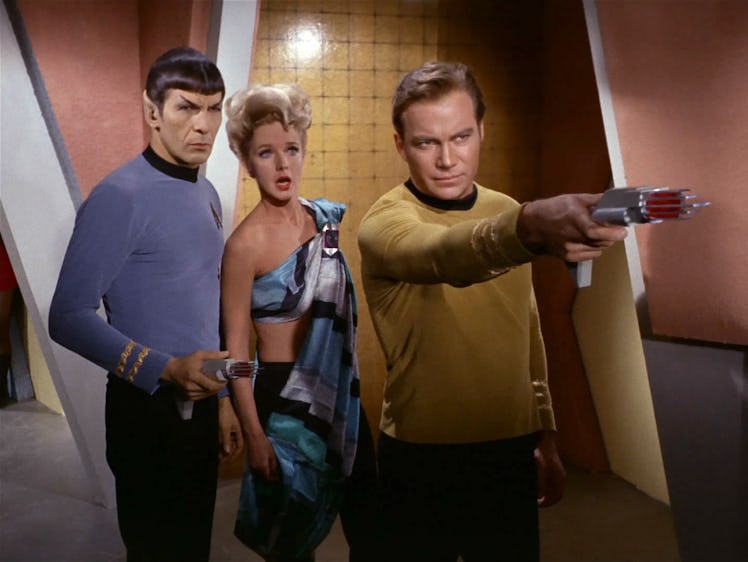
Don’t mess with Kirk.
“A Taste of Armageddon”
On Netflix: Season 1, Episode 24
This is a bit of a sleeper episode of TOS , and it’s massively underrated. Almost every good thing about classic Star Trek happens in this episode. Revealing the premise is a bit of a cheat, but let’s just say the plot involved Kirk and Spock fighting against a culture totally reliant on algorithms and automation.
The twist in this episode is all about what things this particular culture has automated. And when Kirk and Spock figure the culture’s secret, the space sh*t hits the fan big time.
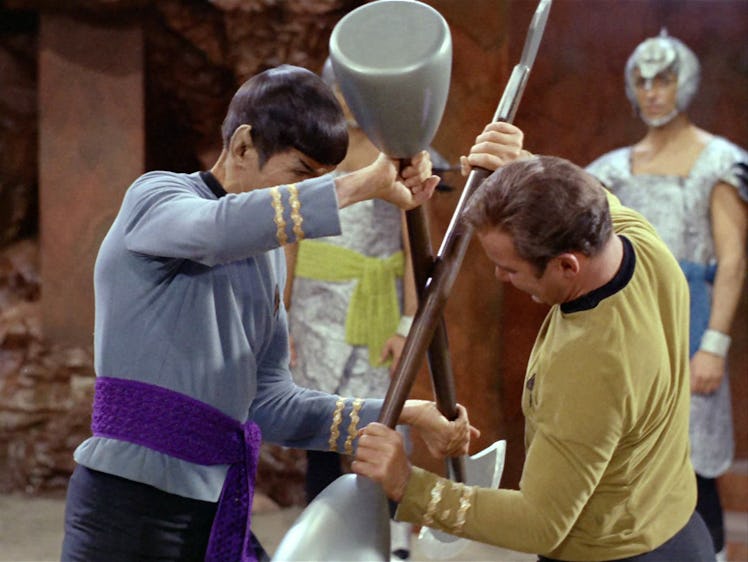
Kirk and Spock don’t always fight to the death, but when they do, they do it in style.
“Amok Time”
On Netflix: Season 2, Episode 1
A classic. You already probably know that Spock and Kirk are supposed to fight to the death in this one. But if you don't know why, exactly, this episode will blow you away. This is the first time we get “live long and prosper,” and a ton of background on the planet Vulcan. From Discovery to the reboot movies , a ton of Trek flows from this single episode.
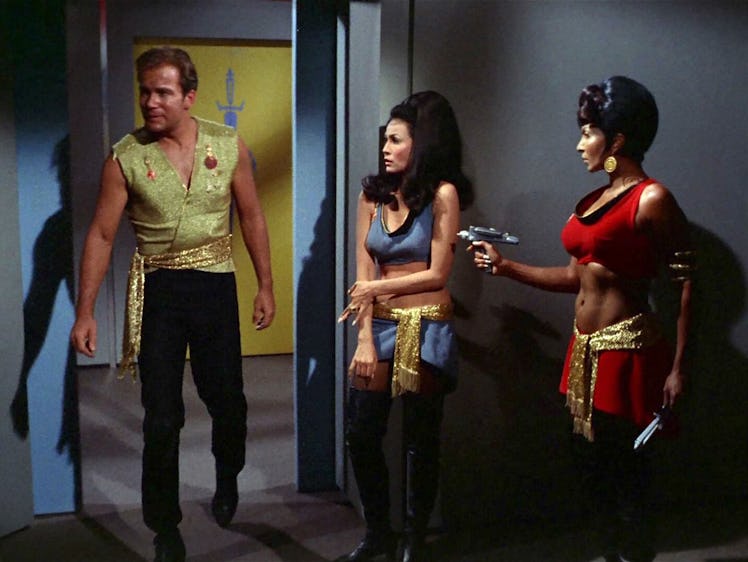
There’s a lot of ass-kicking in this episode. You’ve been warned! It may be too awesome to handle!
“Mirror, Mirror”
On Netflix: Season 2, Episode 4
In The Original Series , this one episode was the only visit to the evil universe in which Starfleet is basically a conquering force, and Spock has a little goatee. The Mirror Universe returned big time in both Deep Space Nine and Discovery , and all the rules of that hyperbolic dimension were established here. This episode is over-the-top and full of heart, two elements that made TOS the memorable and charmingly upbeat franchise launcher it was. But seriously, this episode is very over the top. Be ready.
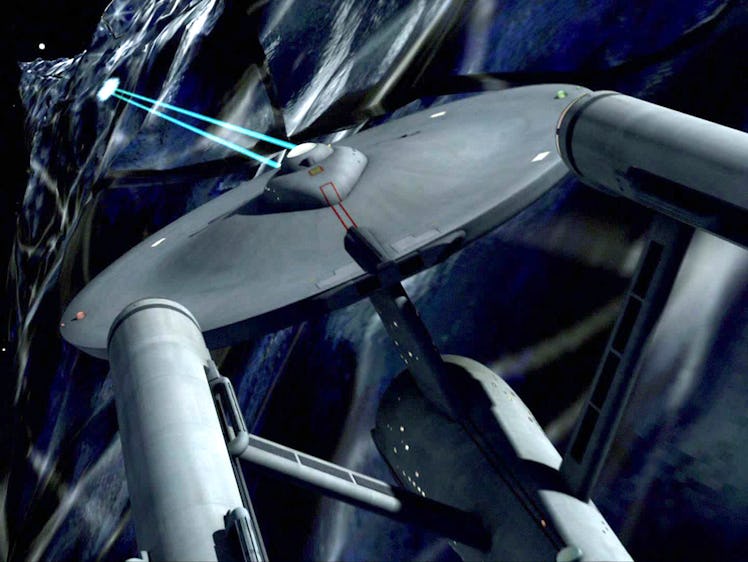
The Enterprise versus the Star Trek version of the Death Star.
“The Doomsday Machine”
On Netflix: Season 2, Episode 6
As the title suggests, the Enterprise faces off against a giant automated weapon even more powerful than the Death Star! When this episode first aired in 1967, the titular “Doomsday Machine” didn’t look very cool.
However, the remastered version of this episode (which is the Netflix version) looks fantastic. Plus, in this episode, you get another Federation starship, the USS Constellation ! Finally, although The Wrath of Khan calcified the franchise’s obsession with Moby Dick , that tradition started right here.

Uhura meets the first tribble. Watch out!
“The Trouble With Tribbles”
On Netflix: Season 2, Episode 15
You’ve heard of this one. There are these fuzzy little balls called tribbles, and they’re all over the place. Although the kitsch in this episode is cranked all the way up to eleven, the episode totally holds up. Come for the tribbles, but stay for Kirk’s awesome cutdowns throughout the entire episode. A lighthearted romp that is a classic Trek outing for a reason. Also, the Klingons are silly AF in this one.
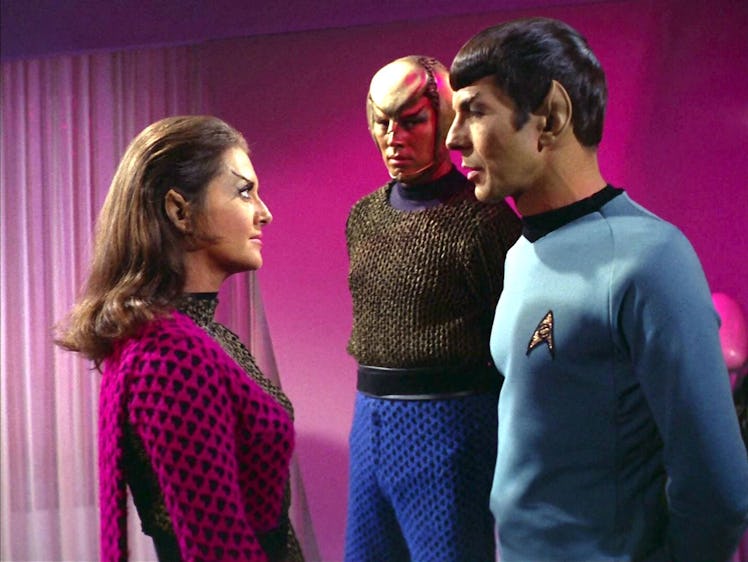
Spock and the Romulans.
“The Enterprise Incident”
On Netflix: Season 3, Episode 2
Season 3 of TOS is often derided by hardcore fans, and sometimes for very good reasons. Overall, the batting average of TOS Season 3 is fairly low compared to the previous two seasons.
However, the excellent espionage episode “The Enterprise Incident” is not only super-fun but also a semi-direct sequel to “Balance of Terror.” This list is biased in favor of the Romulans over the Klingons, and this is one Romulan episode that delivers.
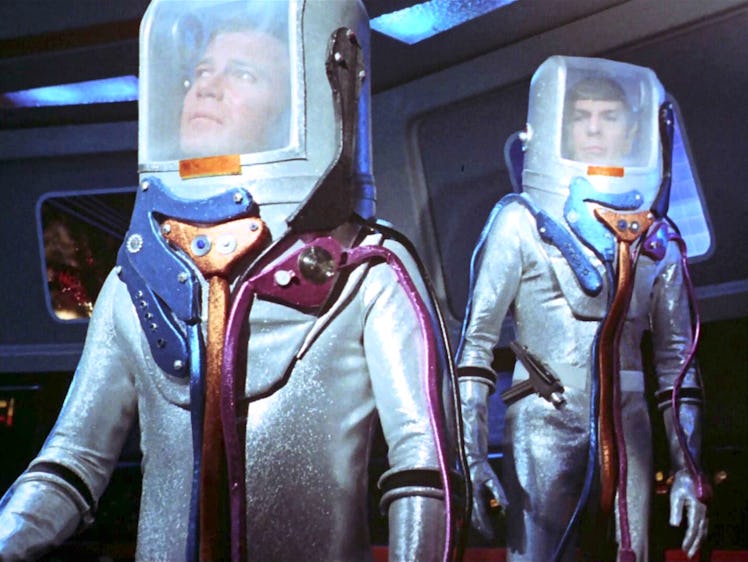
Kirk and Spock rock the best spacesuits in all of Star Trek.
“The Tholian Web”
On Netflix: Season 3, Episode 9
Perhaps not the most tightly written episode of TOS , “The Tholian Web” is beautiful from a visual standpoint. From the zany all-silver spacesuits to the concept of tiny ships weaving an energy web around the Enterprise , to a certain character haunting the crew members as a space ghost, this episode has it all.
Don’t think about the plot too much. Just embrace the gonzo visual sci-fi aesthetic of classic Trek, and you’ll have a great time. As a bonus, “The Tholian Web” later became a backdoor canon Rosetta Stone for two episodes of Enterprise and nearly half of Discovery Season 1.
There’s obviously a lot more TOS to love and enjoy, so if you are curious about other great episodes after you binge these ten, think about hitting up: “The Devil in the Dark,” “The City on the Edge of Forever,” “The Naked Time,” “Shore Leave,” “Arena,” “Journey to Babel,” “A Piece of the Action,” “A Private Little War,” “The Galileo Seven,” “For the World Is Hollow and I Have Touched the Sky,” and “ All Our Yesterdays.”
Star Trek: The Original Series is streaming now on Netflix and leaves on September 30, 2021. It also streams on Paramount+ from now until presumably the heat death of the known universe.
This article was originally published on Sep. 18, 2021
- Science Fiction
The Top 57 Episodes of ‘Star Trek,’ Ranked From Great to Perfect

First, let’s be clear: Ranking the best “Star Trek” episodes is a silly thing to do. To date, the longest-running American TV franchise has aired a gargantuan 890 episodes and counting, starting with the original series in 1966. Since then, at least one “Star Trek” TV show has aired (or streamed) every decade, totaling 11 so far (with more on the way ). Choosing the best episodes within such a boundless, occasionally contradictory storytelling galaxy seems about as wise as cheating when playing poker with a Klingon.
On the other hand, there may be no more time-honored tradition among “Star Trek” fans than a vigorous debate over what constitutes the best of the franchise. (Best series ? Best captains ? Best starships ? Best aliens ? Best uniforms ? They’ve all been ranked multiple times !)
In that spirit — and to commemorate the 57th anniversary of “Star Trek” on Sept. 8 — Variety ’s resident “Trek” geeks have ranked the top 57 episodes of all time, across the franchise.
Creating our list required some deep-dish nerdiness in its own right: We compiled a long list of episodes from each series that we felt deserved to be on the final ranking. Then we created our own individual rankings — and promptly realized our taste was quite divergent. To reconcile our lists, we adopted the approach of the great movie ranking podcast, Screen Drafts : We took alternating turns placing a pick from 57 to 1, and we each had two opportunities to veto the other’s pick (which in every case was to ensure it was placed higher on the list).
Other than the short-lived “Star Trek: The Animated Series” (1973-1974), this list reflects every other iteration of “Trek” on TV: “Star Trek: The Original Series” (1966-1969); “Star Trek: The Next Generation” (1987-1994); “Star Trek: Deep Space Nine” (1993-1999); “Star Trek: Voyager” (1995-2001); “Star Trek: Enterprise” (2001-2005); “Star Trek: Discovery” (2017-2024); “Star Trek: Picard” (2020-2023); “Star Trek: Prodigy” (2021-2022); and the ongoing “Star Trek: Lower Decks” (2020-present) and “Star Trek: Strange New Worlds” (2022-present).
The Way to Eden

“The Original Series” — Season 3, Episode 20
Look, this episode gets a lot of hate. But the fact is “TOS” is known (by today’s standards) for being very campy, and there is no episode campier than this one. A group of space hippies board the Enterprise on their journey to a mythical planet called Eden, where they can live happily forever. The episode memorably features Charles Napier (who would go on to a long career playing tough guys, villains, cops and the like) breaking out into song a bunch of times, including a jam session with Spock (Leonard Nimoy). —Joe Otterson Original airdate: Feb. 21, 1969
Terra Prime

“Enterprise” — Season 4, Episode 21 More than any other episode of “Enterprise,” “Terra Prime” made the most of the show’s mission to dramatize the beginnings of Starfleet, 100 years before the events of “TOS.” Just as a newfound coalition of planets begins to form on Earth (a precursor to the Federation), Captain Archer (Scott Bakula) and his crew must stop a xenophobic terrorist (played to the hilt by future “Star Trek Into Darkness” villain Peter Weller) bent on forcing all aliens to leave Earth. Subtle, it ain’t, but the story feels more relevant today than it did 20 years ago, and everyone in the cast gets a moment to shine. Alas, it came too late: “Enterprise” had been canceled before this episode even went into production. —Adam B. Vary Original airdate: May 13, 2005

“Prodigy” — Season 1, Episode 6
The animated “Prodigy” was the first “Star Trek” series geared toward kids, but that doesn’t mean there weren’t things for older “Trek” fans to enjoy. In particular, “Kobayashi” perfectly embodies what makes this show a worthy entry in “Trek” canon. Dal (Brett Gray) and Jankom Pog (Jason Mantzoukas) discover the holodeck aboard the Protostar, where they decide to go through the Kobayashi Maru, a.k.a. the “no-win scenario” that Capt. Kirk successfully beat during his time at the Academy. He gets help along the way from legendary characters like Spock, Dr. Crusher (Gates McFadden) and Odo (René Auberjonois). —J.O.
Original airdate: Jan. 6, 2022
Stormy Weather

“Discovery” — Season 4, Episode 6
On a mission to discover the origins of a cataclysmic gravitational anomaly, the U.S.S. Discovery enters a subspace rift and finds itself trapped inside a lethal black void that threatens to collapse in on the ship. The result is a classic race-against-time thriller (directed by “Trek” mainstay Jonathan Frakes), but what makes “Stormy Weather” stand out amid the heavily serialized episodes of “Discovery” is its emotionally resonant use of the ship’s sentient A.I. computer, Zora (Annabelle Wallis), who has to learn how to calm her mind from overwhelming stimuli in order to guide the ship out of danger. —A.B.V.
Original airdate: Dec. 23, 2021
Seventeen Seconds

“Picard” — Season 3, Episode 3
“Picard” didn’t find itself until Season 3, which reunited the core cast of “The Next Generation” — and it was really Episode 3 that sealed the deal. Riker (Frakes) is forced to take command of the Titan as Vadic (Amanda Plummer) and the Shrike hunt them. Picard (Patrick Stewart) and Dr. Crusher get an all-time great scene together as she reveals why she never told him about their son, Jack (Ed Speleers). Worf (Michael Dorn) makes his big return. We learn the Changelings are still intent on attacking the Federation. Riker and Picard end up at odds in a way we’ve never seen before. In short, epic. —J.O.
Original airdate: March 2, 2023
The Enemy Within

“The Original Series” — Season 1, Episode 5
The transporter — the cause of, and solution to, so many “Star Trek” problems — accidentally splits Capt. Kirk (William Shatner) into two people: Good Kirk, who is wracked with indecision, and evil Kirk, who is a histrionic asshole. Come for a meditation on the darkness that lies tucked inside everyone’s psyche, stay for some of William Shatner’s most deliciously hammy acting — and this was just the fifth episode of the series! —A.B.V.
Original airdate: Oct. 6, 1966
Family Business

“Deep Space Nine” — Season 3, Episode 23
The Ferengi episodes of “DS9” are always great comic relief, with this episode giving fans their first view of the home planet of Ferenginar and Ferengi culture in general. Quark (Armin Shimerman) and Rom (Max Grodénchik) must return home when their mother, Ishka (Andrea Martin), is accused of acquiring profit (gasp!), something Ferengi females are forbidden to do. Shimerman and Martin shine as they play out Quark and Ishka’s relationship, while Grodénchik really gets to put his comedic chops on display. This episode is also notable as the first appearance of Brunt (Jeffrey Combs) from the Ferengi Commerce Authority, as well as Kasidy Yates (Penny Johnson Jerald), frequent love interest of Cmdr. Sisko (Avery Brooks). —J.O.
Original airdate: May 15, 1995
Blink of an Eye

“Voyager” — Season 6, Episode 12
The Voyager gets stuck in orbit around a planet where time passes far more rapidly than in the rest of space, as the episode alternates between the bemused curiosity of Capt. Janeway (Kate Mulgrew) and her crew and the awestruck preoccupation of the expeditiously progressing populace on the planet below, for whom Voyager is a sparkling, fixed constant in the night sky. At one point, the Doctor (Robert Picard) beams down to the planet to investigate, and a delay of only a few minutes on Voyager means he spends three years on its surface. He even adopts a son! One of the great, wild what if? episodes of “Star Trek.” —A.B.V.
Original airdate: Jan. 19, 2000

“The Next Generation” — Season 3, Episode 23
Mark Lenard absolutely crushed the role of Spock’s father, Sarek, in multiple episodes across multiple “Star Trek” series and movies, but this episode is perhaps his finest performance as the character. Sarek comes to the Enterprise-D on what is meant to be his final mission, only for the crew to learn he is suffering from Bendii Syndrome. The condition leaves him prone to uncharacteristic emotional outbursts while also causing him to telepathically influence the emotions of those around him. Picard saves the day by mind melding with Sarek, allowing him to finish his mission with dignity — and provide Stewart with the chance for some powerhouse acting as he channels Sarek’s volcanic emotions. —J.O.
Original airdate: May 14, 1990

“Enterprise” — Season 3, Episode 10
“Trek” loves a moral dilemma, and this one’s a doozy: After Cmdr. Tucker (Connor Trinneer) is critically injured while the Enterprise is on a deep space mission, Dr. Phlox (John Billingsley) suggests growing a “mimetic symbiote” of Trip — effectively, a clone with a built-in two-week lifespan — in order to create the brain tissue needed to save Trip’s life. But that means the Enterprise crew must endure watching Trip’s clone rapidly age from a precocious kid to an adult man (played by Trinneer with eerie self-possession), who then pleads for his own right to live. Creepy and heartbreaking in equal measure. —A.B.V.
Original airdate: Nov. 19, 2003
Trials and Tribble-ations

“Deep Space Nine” — Season 5, Episode 6
This episode is a love letter to the original series, with the Defiant’s crew transported back in time to the events of “The Trouble With Tribbles.” A Klingon agent is planning to use a booby-trapped tribble to assassinate James T. Kirk. Thanks to digital editing, the crew is able to interact with the original Enterprise crew and keep the timeline intact. —J.O.
Original airdate: Nov. 4, 1996

“Deep Space Nine” — Season 2, Episode 23
Mirror universe episodes of “Star Trek” are (almost) always fun, if ultimately a little silly. But this one — in which Kira (Nana Visitor) and Dr. Bashir (Alexander Siddig) find themselves in an alternate reality in which Bajor, Cardassians and Klingons subjugate humans as slaves — comes closest to matching the spark of discovery in the original “TOS” episode. It’s especially fun to watch Visitor devour the role of Kira’s deliciously wicked mirror counterpart, the Intendant. —A.B.V.
Original airdate: May 16, 1994
Memento Mori

“Strange New Worlds” — Season 1, Episode 4
This episode proved “Strange New Worlds” — the newest “Star Trek” series — could be as action-packed as the very best of “Star Trek.” The Enterprise crew find themselves on the run from the Gorn, a savage enemy (first introduced on “TOS” and largely ignored in “Trek” canon) about which they know virtually nothing. They are forced to use every resource at their disposal to outwit and outrun the Gorn, including tapping into the subconscious of La’an (Christina Chong), the only crew member who has encountered the aliens and survived. —J.O.
Original airdate: May 26, 2022
Counterpoint

“Voyager” — Season 5, Episode 10
The main story is a tense, WWII allegory: Capt. Janeway and her crew hide telepathic refugees while passing through the space of the Devore, who have outlawed telepaths. But the real story is the relationship Janeway forms with the lead Devore inspector, Kashyk (Mark Harelik), who suddenly shows up alone and announces he’s defecting. As Kashyk aids Janeway in finding safe harbor for the refugees, she realizes how much he’s her intellectual equal, and she finds herself drawn to him — in spite of (or perhaps spurred on by) her continued suspicion of his motives. A great, subtle performance by Mulgrew captures both Janeway’s steely wits and her private yearning. —A.B.V.
Original airdate: Dec. 16, 1998
The Drumhead

“The Next Generation” — Season 4, Episode 21
“Star Trek” has done a number of courtroom episodes, and this is one of the best. Rear admiral Norah Satie (Jean Simmons) is sent to investigate suspected sabotage aboard the Enterprise. The investigation quickly spirals into paranoia and accusations of treachery against a crew member who is revealed to have Romulan lineage. It is an excellent reminder of what can happen when persecution is dressed up as an attempt at greater security, with Picard using Satie’s father’s teachings to bring about her downfall. —J.O.
Original airdate: April 29, 1991

“The Next Generation” — Season 7, Episode 8
More thwarted romance! The seasons-long will-they/won’t-they between Picard and Dr. Crusher (Gates McFadden) gets its best showcase, when the pair are captured by isolationist aliens and given implants that allow them to read each other’s thoughts. You get the feeling Stewart and especially McFadden had been dying to play out this dynamic on the show, so they both bring years of sublimated longing to the episode. —A.B.V.
Original airdate: Nov. 8, 1993
In the Hands of the Prophets

“Deep Space Nine” — Season 1, Episode 20
Louise Fletcher’s performance as Vedek Winn (later Kai Winn) ranks among the best “Star Trek” villains of all time. Deeply religious to the point of fanaticism, Winn protests Keiko O’Brien (Rosalind Chao) teaching children on Deep Space Nine that the wormhole aliens are not deities, as many Bajorans believe. Winn’s words whip Bajorans on the station into a frenzy; Keiko’s school is bombed. But what Winn really desires is power, to the point she tries to get one of her followers to kill a fellow Vedek she sees as a threat. The episode sets up Winn’s role as a major antagonist throughout the series to great effect. —J.O.
Original airdate: June 21, 1993
The Trouble With Tribbles

“The Original Series” — Season 2, Episode 15
If you’ve seen any episode of “TOS,” chances are it’s this one. While on shore leave at a space station, the Enterprise comes upon an adorably furry alien creature called a tribble, which are born pregnant, multiply exponentially, consume enormous quantities of food and react with alarm when in the presence of a Klingon. Fizzy and funny and, to this day, one of the best-known episodes of “Trek” ever. —A.B.V.
Original airdate: Dec. 29, 1967
Balance of Terror

“The Original Series” — Season 1, Episode 14
Introducing the Romulans alone makes this episode worthy of being on the list. But it’s also an epic cat-and-mouse game between Kirk and a Romulan commander played by none other than Mark Lenard, who would go on to play Sarek starting in Season 2. Kirk successfully lures the Romulan ship into a trap, leading to Lenard delivering the iconic line, “You and I are of a kind. In a different reality, I could have called you friend.” —J.O.
Original airdate: Dec. 15, 1966

“The Next Generation” — Season 4, Episode 20
John de Lancie never disappoints when he plays Q, but this episode offered a wonderful twist on his usual appearances. Following the events of “Deja Q,” Q returns to the Enterprise saying he owes Picard a debt. Picard repeatedly tells Q he wants nothing from him, but Q notices Picard has eyes for Vash (Jennifer Hetrick), the mercenary archeologist Picard first met on Risa. Being Q, he naturally transports Picard, Vash, and the bridge crew to a Robin Hood fantasy in which Picard must rescue Vash from the evil Sir Guy of Gisbourne (Clive Frevill). Added bonus: Worf, in scarlet tights, exclaiming in protest, “I am not a merry man!” —J.O.
Original airdate: April 22, 1991

“The Original Series” — Season 1, Episode 18
The classic “trial by combat” episode that pitted Kirk against a Gorn captain on a barren, rocky planet (i.e. the storied filming location Vasquez Rocks ). Few images from “Star Trek” have become more iconic than the original Gorn costume, which was essentially an actor dressed as a large lizard. The ending is also an all-timer, with Kirk choosing to spare the Gorn, proving to the all-powerful Metrons that set up the trial by combat that humans are capable of more than just random violence. —J.O.
Original airdate: Jan. 19, 1967
A Mathematically Perfect Redemption

“Lower Decks” — Season 3, Episode 7
“Star Trek’s” first pure comedy (and second animated series) often plays as a twisted love letter to the entire “Trek” franchise — like when Peanut Hamper (Kether Donohue), one of the sentient Exocomp robots first introduced on “The Next Generation,” abandons the crew of the U.S.S. Cerritos in a time of need. This episode tracks Peanut Hamper’s journey to redemption afterwards, which involves her encountering a seemingly primitive species called the Areore. To say anything more would spoil the fun; suffice it to say, “Trek” has rarely provoked gasps of deep laughter like this episode does. —A.B.V.
Original airdate: Oct. 6, 2022
Bar Association

“Deep Space Nine” — Season 4, Episode 15
What better episode of “Star Trek” to talk about after Hollywood’s hot labor summer? Fed up with the unfair conditions at Quark’s bar, Rom talks the other workers into forming a union and going on strike. Max Grodénchik truly shines in this episode as the would-be union leader. Once Rom successfully gets Quark to agree to all the workers’ demands, he outright quits and goes to work as a repair technician for the station, setting up some of Rom’s best moments in the episodes to come. —J.O.
Original airdate: Feb. 19, 1996

“Voyager” — Season 5, Episode 26 & Season 6, Episode 1
The Voyager swoops to the rescue of the Equinox, another Federation starship stranded in the Gamma Quadrant — only this one, led by Capt. Ransom (John Savage), is a smaller ship not meant for deep space travel. With their crew whittled down to just 12 people, Ransom has resorted to murdering alien creatures to use their bio-matter to boost the Equinox’s engines — a horrific violation of everything Starfleet stands for. The discovery pushes Janeway to her own limits, as she obsessively pursues the Equinox despite the cost to her own crew and her morality. The two-parter is one of the darkest episodes of “Star Trek,” a chilling reminder of how easily good people can find themselves slipping into disgrace. —A.B.V.
Original airdates: May 26, 1999 & Sept. 22, 1999
Who Mourns for Morn?

“Deep Space Nine” — Season 6, Episode 12
Morn (Mark Allen Shepherd) was a “Deep Space Nine” fixture, always at Quark’s bar, but never actually speaking onscreen. But in this episode, with Morn apparently dead in an accident, everyone reveals the offscreen times they spent with him, including the revelation that he “never shuts up.” Quark inherits all of Morn’s property, which Odo relishes revealing is ultimately nothing. But as it turns out, Morn had a much more adventurous life before his time on “DS9” than anyone knew, leading his former comrades to seek him out to get a hold of the money they believed he still possessed. —J.O.
Original airdate: Feb. 4, 1998
Species Ten-C

“Discovery” — Season 4, Episode 12
Other than the Gorn, almost all of the aliens on “Star Trek” are, essentially, humans with slightly different forehead ridges. But in its most recent season, “Discovery” embraced “Trek’s” prime directive (seeking out new life, bolding going where no one’s gone, etc.) by crafting a species that is truly alien: the Ten-C. Throughout the season, the Ten-C are presented as both a total mystery and an existential threat; when Capt. Burnham (Sonequa Martin-Green) and the crew of the Discovery finally reach them — outside the barrier of the Milky Way galaxy — they are unlike anything the show has ever encountered. Rarely has “Trek” applied more intellectual and emotional rigor to what it might actually be like to attempt first contact with extra-terrestrials, and rarely has it been this compelling. —A.B.V.
Original airdate: March 10, 2022
A Man Alone

“Deep Space Nine” — Season 1, Episode 4
Odo is one of the best characters in “DS9” — and in the “Star Trek” universe — in general, and this is the first episode to really establish him as a standout . A known criminal returns to the station only to die shortly after, and Odo is accused of his murder. Odo’s status as an outsider, but ultimately someone to be respected, is made crystal clear in this episode, with even his archenemy Quark acknowledging that Odo is not the type to murder someone in cold blood. —J.O.
Original airdate: Jan. 17, 1993
Mirror, Mirror

“The Original Series” — Season 2, Episode 4
The transporter strikes again, this time accidentally zapping Kirk, Uhura (Nichelle Nichols), Scotty (James Doohan) and Bones (DeForest Kelley) from their reality into a parallel universe in which the benevolent Federation has been replaced by the bloodthirsty Terran Empire, governed by brute force and fascistic exploitation — and Spock has a goatee! More silly than serious (and no less fun for it), the episode effectively spawned an entire sub-genre of parallel universe episodes of TV (from “Supernatural” to “Friends”) and gave generations of actors a chance to play wildly against type. —A.B.V.
Original airdate: Oct. 6, 1967

“The Next Generation” — Season 4, Episode 2
People rave about “The Best of Both Worlds” and Picard’s assimilation by the Borg, but fewer remember this incredible follow-up episode. Picard returns to his family vineyard to put the Borg incident behind him, even briefly thinking that he will leave Starfleet. Jeremy Kemp crushes it as Picard’s brother Robert, with the two sharing a memorable (and muddy) scene in which Picard breaks down and admits how much his assimilation has shaken him. The episode is also memorable for the appearance of Worf’s adoptive parents, who come to the Enterprise to be with him following his discommendation. —J.O.
Original airdate: Oct. 1, 1990
Living Witness

“Voyager” — Season 4, Episode 23
For several minutes, “Living Witness” seems like a mirror universe episode, as a ruthless Janeway, captain of the “warship” Voyager, agrees to aid the Vaskans against the insurgent Kyrians by unleashing a biological weapon upon millions and executing the Kyrian leader. But then we realize that we’ve just witnessed a recreation at a Kyrian museum 700 years in the future, at which point a copy of the Doctor enters the story and learns, to his horror, how much the Kyrians have gotten wrong. What could have been a Rashomon-style caper instead becomes fascinating meditation on how the telling of history can be weaponized, even inadvertently, to maintain old wounds rather than heal them. —A.B.V.
Original airdate: April 29, 1998
Unification

“The Next Generation” — Season 5, Episode 7 & 8
Spock appeared on “The Next Generation” a month before the release of 1991’s “Star Trek VI: The Undiscovered Country” — but this time, at least, crass cross-promotion prompted some sublimely entertaining TV, as Picard and Data (Brent Spiner) aid Spock in his effort to reunify the Romulan and Vulcan peoples. [Stefon voice]: This two-parter has everything : Klingon warbirds, rude Ferengis, Tasha’s evil Romulan daughter Sela (Denise Crosby), Data and Spock philosophizing on their twin pursuits of logic and emotion, the death of Sarek, Worf singing Klingon opera with a four-armed bar pianist, and Picard and Spock mind-melding! —A.B.V.
Original airdates: Nov. 4 & 11, 1991

“Deep Space Nine” — Season 7, Episode 9
Gul Dukat is the best villain in “Star Trek.” Yes, you read that right. The writers and actor Marc Alaimo created an incredibly nuanced character that goes through a remarkable arc over the course of the series. This episode, near the end of “DS9’s” run, reminds fans that Dukat sees himself as a savior, but is ultimately a force for evil. He establishes a cult dedicated to the Pah wraiths on Empok Nor, luring a number of Bajorans to his side. But of course, he also sleeps with his female followers and tries to trick them into a mass suicide. Amazing stuff. —J.O.
Original airdate: Nov. 23, 1998
The Last Generation

“Picard” — Season 3, Episode 10
The cast of “TNG” infamously never got their swan song, after 2002’s “Star Trek: Nemesis” bombed in theaters, so this series finale serves as a gift both to them and to “TNG” fans. Every character gets their spotlight, including the resurrected Enterprise-D, as Picard, Riker, Dr. Crusher, Data, Worf, LaForge (LeVar Burton) and Troi (Marina Sirtis) all help to take down the Borg once and for all. The final scene — everyone sitting around a poker table, laughing and reminiscing — is as pure and satisfying an expression of fan service as anything “Trek” has ever done. —A.B.V.
Original airdate: April 20, 2023

“The Next Generation” — Season 3, Episode 13
Until this episode, Q was an enjoyably malevolent force within “TNG,” an omnipotent being who’d gleefully pop up now and again to play with the lives of the Enterprise-D crew. But here, when Q suddenly appears on the bridge, he’s been stripped of all his powers (and all of his clothes) and begs Picard for safe harbor. At first, no one believes him — even after Guinan (Whoopi Goldberg) stabs him with a fork — which only fuels John de Lancie’s sparkling performance, as Q confronts life as ( shudder ) a mortal human. —A.B.V.
Original airdate: Feb. 3, 1990
An Embarrassment of Dooplers

“Lower Decks” — Season 2, Episode 5
The title refers to an alien called a Doopler, who duplicate themselves whenever they get embarrassed — which, naturally, becomes an issue the moment one steps foot on the Cerritos. But really, this episode is one of those deeply enjoyable “Trek” episodes that is less about story than it is about the vibes , as the characters spend their downtime winningly contending with the central premise of the show: The bittersweet contentment of life at the bottom of the ladder. —A.B.V.
Original airdate: Sept. 9, 2021

“Deep Space Nine” — Season 2, Episode 19
The lives of the past hosts of the Dax symbiont are a recurring plot device on “DS9,” and no episode does it better than this one. A group of Klingons who knew Curzon Dax arrive at the station and enlist Jadzia’s (Terry Ferrell) help in killing their sworn enemy, a criminal known as The Albino who killed the three Klingons’ first-born sons. Jadzia ultimately honors the blood oath, as the episode explores the meaning of honor and solidarity. —J.O.
Original airdate: March 28, 1994
Where No Man Has Gone Before

“The Original Series” — Season 1, Episode 3
The famed second pilot episode of “Star Trek” (which introduced William Shatner as Capt. Kirk) is a strange artifact today: Bones and Uhura aren’t aboard yet, Sulu (George Takei) isn’t at the helm, the Enterprise has a psychiatrist (played by Sally Kellerman), and the uniforms and sets look a bit off. But the central story — Kirk’s best friend, Gary Mitchell (Gary Lockwood), is zapped by an energy blast at the edge of the galaxy, and begins to exhibit extraordinary psychokinetic powers — is vintage “Trek”: Brainy, brawny, and just the right side of uncanny. And it’s fascinating now to see how well-established Kirk and Spock’s dynamic of emotion vs. logic was from the very start. —A.B.V.
Original airdate: Sept. 22, 1966
The Measure of a Man

“The Next Generation” — Season 2, Episode 9
Data’s quest for humanity is at the very core of “TNG,” and this stirring episode literally puts that quest on trial — and establishes the show’s voice for the rest of its run. A Starfleet scientist wants to dismantle Data in order to create more androids, but Data refuses, setting up an intense courtroom drama — is Data merely a machine and the property of Starfleet? — with Picard representing Data while Riker is forced to represent the scientist. —J.O.
Original airdate: Feb. 13, 1989

“The Next Generation” — Season 4, Episode 26 & Season 5, Episode 1
The Klingons started on “Trek” as a not-that-thinly-veiled metaphor for the Soviet Union at the height of the Cold War, but over the decades, they’ve developed their own richly detailed mythology. This two-parter (which aired just before the fall of the USSR) depicts a civil war within the Klingon Empire that leads to Worf’s decision to leave the Enterprise and join the fight. For a series that was episodic by design, this is the closest “TNG” ever got to serialized storytelling, incorporating events from several previous episodes — including the shocking introduction of Tasha’s Romulan daughter, Sela. —A.B.V.
Original airdates: June 17, 1991 & Sept. 23, 1991

“Deep Space Nine” — Season 1, Episode 11
It is endlessly entertaining to see Quark get what he wants as he then learns that it’s way more trouble than he realized. This episode sums that idea up nicely, while also featuring the first of many wonderful appearances by Wallace Shawn as Ferengi leader Grand Nagus Zek. Zek unexpectedly names Quark his successor, only for Zek to die shortly after. Quark is thrilled at first, before he realizes being the Nagus puts a massive target on his back. This episode also helps build the friendship between Nog (Aron Eisenbeg) and Jake (Cirroc Lofton), with Jake secretly teaching Nog how to read. —J.O.
Original airdate: March 22, 1993
Tinker, Tenor, Doctor, Spy

“Voyager” — Season 6, Episode 4
Yearning to grow past his programming, the Doctor allows himself the ability to daydream, in one of the flat-out funniest episodes of “Trek” ever. It opens with Robert Picardo singing opera as Tuvok (Tim Russ) undergoes pon farr (i.e. the madness to mate that consumes Vulcan males) and just gets wilder from there, up to the moment when the Doctor, who’d fantasized about taking over command of Voyager in an emergency, does it for real. —A.B.V.
Original airdate: Oct. 13, 1999

“The Original Series” — Season 2, Episode 1
Speaking of pon farr, this is the “TOS” episode that first establishes it — as well as the planet Vulcan, several Vulcan customs and traditions, and the now legendary Vulcan salute (honorable mention: Spock actually smiles!). Wracked with pon farr, Spock asks for leave back on his home planet, and eventually reveals that he must meet his betrothed, T’Pring (Arlene Martel). Naturally, Kirk and Spock end up in a fight to the death in one of the most iconic battles in “Star Trek” history. —J.O.
Original airdate: Sept. 15, 1967
Year of Hell

“Voyager” — Season 4, Episode 8 & 9
The most lasting criticism of “Voyager” is that every week, no matter what happened in the previous episode, the ship and crew emerged unscathed and ready for a new adventure. As if in response, this two-parter tracks a year in which the Voyager is ravaged to the point of near ruin by repeated encounters with an aggressive alien species called the Krenim. Unbeknownst to the crew, they’re actually the victims of a Krenim scientist, Annorax (Kurtwood Smith), who developed a technology to alter the fabric of time by erasing entire species from ever existing. This is as harrowing and merciless as “Trek’s” ever been, but it’s not quite the best episode of “Voyager” due to the irony of its ending: Janeway crashes the husk of the Voyager into Annorax’s timeship — which resets the timeline completely, as if nothing that we’d seen had ever happened. —A.B.V.
Original airdates: Nov. 5 & 12, 1997

“Deep Space Nine” — Season 3, Episodes 11 & 12
“Star Trek” often addresses timely societal issues, but this episode put them firmly in a 21st century context. Sisko, Bashir, and Dax accidentally wind up in San Francisco circa 2024, where poverty and oppression of the disadvantaged are running rampant (crazy how that remains timely, huh?). When a man meant to serve an important purpose in an historic riot is accidentally killed too soon, Sisko is forced to take his place. —J.O.
Original airdate: Jan. 2, 1995 & Jan. 9, 1995
Those Old Scientists

“Strange New Worlds” — Season 2, Episode 7
In one of the rare “Trek” crossover episodes, Ens. Boimler (Jack Quaid) and Ens. Mariner (Tawny Newsome) from “Lower Decks” find themselves zapped back to the era when Capt. Pike (Anson Mount) captained the Enterprise. Marshalled by Jonathan Frakes’ steady hand as a director , the disparate tones of “Lower Decks” and “Strange New World” somehow mesh perfectly, and hilariously, together. Packed with guffaw-worthy laughs, “Those Old Scientists” also becomes a deeply poignant expression of the impact “Trek” has had on generations of fans. Maybe it’s controversial to place one of the most recent “Trek” episodes so high on this list, but this one more than earns its spot. —A.B.V.
Original airdate: July 22, 2023
The Best of Both Worlds

“The Next Generation” — Season 3, Episode 26 & Season 4, Episode 1
This two-parter is frequently cited as the best “Next Generation” storyline of all time, mostly because it features one of the most iconic cliffhangers in all of television. The Borg attack the Federation, leading to a showdown with the Enterprise. Picard is captured and assimilated, revealing himself to his crew as Locutus of Borg. If we’re splitting Borg nano-probes, the second half doesn’t quite live up to the first, which is why, for us, it doesn’t quite rank into the Top 10. Special shoutout to this episode for setting up the incredible “Star Trek” film “First Contact.” —J.O.
Original airdate: June 18, 1990 & Sept. 24, 1990

“Deep Space Nine” — Season 1, Episode 19
When a Cardassian named Marritza (Harris Yulin) arrives on Deep Space Nine, Kira realizes he must have worked at one of the most notorious labor camps during Cardassia’s occupation of Bajor, and she arrests him as a war criminal. What follows is effectively a two-hander, as Kira’s interrogation of Marritza leads to a series of revelations that unmoor her hard-won fury at the atrocities inflicted upon her people. The conventional wisdom is that “DS9” didn’t get cooking until the Dominion War, but this early episode proves that this show was providing great, searing drama from the start. —A.B.V.
Original airdate: June 14, 1993

“The Original Series” — Season 1, Episode 22
Ricardo Montalbán makes his debut as Khan Noonien Singh, a genetically superior dictator from Earth’s Eugenics Wars. Khan and his people have been in suspended animation for 200 years and are looking to dominate humanity once again. Naturally, Kirk is able to beat Khan in a riveting confrontation, but rather than send him and his people to a penal colony, he agrees to let them settle on the wild planet, Ceti Alpha V. The episode proved to be so good, it led to the 1982 film “Star Trek II: Wrath of Khan,” arguably the best “Trek” movie of all time. —J.O.
Original airdate: Feb. 16, 1967

“Voyager” — Season 5, Episode 6
There’s something about time travel — and the twisty narrative paradoxes it can cause — that has engendered some of the best episodes of “Trek” ever made. That certainly includes this stunning “Voyager” episode, which opens with Harry Kim (Garrett Wang) and Chakotay (Robert Beltran), 15 years in the future, discovering the frozen husk of the Voyager buried inside a glacier on a barren ice planet. It turns out Kim made a critical mistake that caused the catastrophic accident, from which only he and Chakotay survived. Their unyielding fixation to right that wrong — and erase the previous 15 years from history — makes for a gripping nail-biter about regret and devotion. Not only did LeVar Burton direct, but he cameos as Capt. Geordi La Forge! —A.B.V.
Original airdate: Nov. 18, 1998
The Defector

“The Next Generation” — Season 3, Episode 10
Did a Romulan admiral really defect to the Federation, or are the Romulans perpetrating an elaborate hoax on Picard and the Enterprise crew? This wonderful episode sees the admiral in question (played by James Sloyan) claiming the Romulans are building a secret base within the Neutral Zone, forcing Picard to consider whether or not he should investigate and thus risk starting a war. It also features the excellent opening in which Picard tries to teach Data about humanity by having him act out scenes from Shakespeare’s “Henry V.” —J.O.
Original airdate: Jan. 1, 1990
Chain of Command

“The Next Generation” — Season 6, Episode 10 & 11
Lured into Cardassian territory under false pretenses, Picard is captured and systematically tortured by a ruthless interrogator, Gul Madred, in a chilling performance by David Warner. Their disturbing tête-à-tête — Picard is stripped naked and nearly broken by the end — would be enough for one of the all-time best “Trek” episodes. But this two-parter also boasts Ronny Cox as Capt. Jellico, Picard’s replacement on the Enterprise, whose prickly and demanding leadership style creates all kinds of thrilling friction among the crew. —A.B.V.
Original airdates: Dec. 14 & 21, 1992
In the Pale Moonlight

“Deep Space Nine” — Season 6, Episode 19
In this fantastic episode, Sisko grapples with the ethics of doing whatever it takes to get the Romulans to join the Dominion War on the Federation-Klingon side. This includes falsifying evidence and freeing a known criminal from Klingon prison with the help of master spy Garak (played by the always wonderful Andrew Robinson). Sisko (while recording a personal log) delivers a series of powerful monologues direct to camera about why he did what he did, ultimately deciding it was worth it in the end. —J.O.
Original airdate: April 13, 1998
The City on the Edge of Forever

“The Original Series” — Season 1, Episode 28
Accidentally hopped up on stimulants, a crazed Bones leaps through a time portal on an alien planet and winds up changing history so drastically that the Enterprise disappears. Kirk and Spock travel back to stop him, and land in New York City during the Great Depression, where they learn that Bones saved the life of Sister Edith Keeler (Joan Collins), a pacifist whose message resonates so strongly that the U.S. stays out of WWII, allowing the Nazis to conquer Europe. Alas, Kirk falls deeply in love with Keeler, establishing a classic “Trek” moral dilemma: How does one suppress their most profound personal feelings for the greater good? An all-timer that still resonates today. —A.B.V.
Original airdate: April 6, 1967
Far Beyond the Stars

“Deep Space Nine” — Season 6, Episode 13
In this Avery Brooks-directed episode, Sisko envisions himself as a Black science fiction writer in 1950s New York named Benny Russell. Russell dreams up a story about the crew of a space station led by a Black captain, but his publisher refuses to run it. This episode is memorable for many reasons, the biggest of which being its handling of racism, but it also allows the show’s main cast gets to appear without any prosthetics or makeup, as completely different characters, to great effect. —J.O.
Original airdate: Feb. 9, 1998
Yesterday’s Enterprise

“The Next Generation” — Season 3, Episode 15
The Enterprise-C, believed to have been destroyed over 20 years earlier, emerges from a temporal anomaly and resets history into a decades-long war between the Federation and the Klingon Empire. Tasha — killed off in Season 1 (after Denise Crosby wanted to leave the show) — is brought back to life, and falls for the Enterprise-C’s helmsman (Christopher McDonald), while Guinan implores Picard that something is desperately wrong with history and he must send the Enterprise-C back to certain doom. Somehow, this episode crams a movie’s worth of story into a nimble and rousing 44 minutes. Not a second is wasted. Outrageously great. —A.B.V.
Original airdate: Feb. 19, 1990
The Inner Light

“The Next Generation” — Season 5, Episode 25
When the Enterprise comes upon a mysterious probe, Picard is suddenly hit with a signal that plunges him into a different man’s life on a dying planet. There, Picard experiences half a lifetime, with a wife, children and grandchildren, all in the space of 25 minutes. When Picard realizes this was all meant as a time capsule — a way to preserve the stories of the people of the planet, which was destroyed 1,000 years earlier by an exploding star — the revelation that he lived the life he’d long forsaken as a Starfleet captain, only to have it ripped away, is almost more than he can bear. But hoo boy, does it make for stunning, deeply moving television. In fact, almost no episode of “Trek” is better. Almost. —A.B.V.
Original airdate: June 1, 1992
The Visitor

“Deep Space Nine” — Season 4, Episode 2
Don’t watch this one without tissues handy. This emotionally devastating episode gets right to the heart of what made “DS9” so special — the relationship between Sisko and his son, Jake. Told in flashbacks by an elderly Jake (Tony Todd), the episode recounts how Sisko became unstuck in time, briefly revisiting Jake over the course of his life, and how Jake is determined to bring him back. In brief, fleeting moments, Sisko tells Jake not to worry about him and to live his life to the fullest. But Jake cannot bear the thought of losing his father forever, ultimately sacrificing his own life to restore the normal flow of time. —J.O.
Original airdate: Oct. 9, 1995
More From Our Brands
Randy travis lost most of his speech in 2013. how is he releasing a new song, this $14.5 million bay area estate features a tennis court and rose gardens, penn stock tumbles in first full quarter with espn bet data, be tough on dirt but gentle on your body with the best soaps for sensitive skin, the resident tops nielsen’s overall streaming ranking chart, verify it's you, please log in.
The Definitive Voice of Entertainment News
Subscribe for full access to The Hollywood Reporter
site categories
‘star trek’: 20 greatest episodes from the original series.
Whether you’re a long-time fan or looking for a starting point, let this top 20 episodes list from the original series of ‘Star Trek’ be your guide to the stars.
By Aaron Couch , Graeme McMillan September 20, 2016 6:00am
- Share this article on Facebook
- Share this article on Twitter
- Share this article on Flipboard
- Share this article on Email
- Show additional share options
- Share this article on Reddit
- Share this article on Comment
- Share this article on Whatsapp
- Share this article on Pinit
- Share this article on Linkedin
- Share this article on Print
- Share this article on Tumblr

In honor of Star Trek 's 50th anniversary this month, The Hollywood Reporter counted down the top 100 episodes of Star Trek — ranking them across all six TV series with help from the stars and writers who made them so beloved.
Now we're going to break it down even further — this time organizing the episodes by era. Every day through Friday, we'll be releasing a new list specific to each series, with the order is based on our original list of 100.
Here, we look at the best of the original series, which ran from 1966-69 saw Gene Roddenberry's vision brought to life by actors William Shatner (Spock), Leonard Nimoy (Spock), DeForest Kelley (Bones), Nichelle Nichols ( Uhura ), Walter Koenig ( Chekov ), George Takei ( Sulu ), and James Doohan (Scotty).
Below you'll find Shatner and Koenig reveal their favorite episodes, as well as hear from Star Trek Beyond director Justin Lin, two iconic Trek writers and many more.
Related Stories
'star trek': 100 greatest episodes, "spectre of the gun".
"We had bee spending too much money by the network's reckoning, so we had less to spend on this particular episode," recalls Walter Koenig of the hour, which saw an away team forced to battle in an Old West-style gunfight. "It gave my character some interesting work. He got the girl, he died and came back to life. I loved the whole concept."
'Star Trek': Walter Koenig on Lean Years After Cancellation and How Writing Ultimately Saved Him
"the galileo seven".
Not only does this episode give us the first appearance of a shuttlecraft in Trek lore, it introduces a version of the concept that would become key to the franchise decades later — that there is a push and pull between the needs of the many and the needs of the few. The Enterprise is on a mission to deliver relief supplies to a colony. Meanwhile, seven crewmembers — including Spock and Bones — crash land on a hostile planet, and Kirk must grapple with holding out hope for them and delivering the relief supplies.
"A Taste of Armageddon"
"This was the first Original Series episode I ever saw and it still blows my mind," says Jordan Hoffman, U.S. Film Critic for The Guardian and host of ENGAGE: The Official Star Trek Podcast . "Kirk is escorting a diplomat to a system of planets that have been in conflict for centuries. However, to protect their society’s infrastructure and maintain their culture, they don’t fight with weapons. Computers determine where phantom missiles hit and if your number comes up, you are ordered into a disintegration chamber. It is up to the Enterprise to intervene (which they totally aren’t supposed to do) and stop this insanity. It’s a rich concept with thrills, action, great speeches and even some humor. (Indeed, Spock takes the time to make a solid joke before sending someone crumpled to the floor with his Vulcan nerve pinch.)"
"The Doomsday Machine"
If Star Trek had shown Starfleet at its best until now, audiences got to see the flipside in this episode, in which Commodore Matt Decker (William Windom ) turns into an outer space Ahab chasing the cosmic Moby Dick of the episode's title: a "planet killer" that had nearly destroyed his own ship and killed everyone on board except for him. For an episode with such stakes, it's a surprisingly subtle story: While we should be worried about whether the planet killer can be stopped, the real tension comes from watching Decker struggle to deal with his trauma.
"The Corbomite Maneuver"
The first episode to be filmed after the two different pilots for the series, " Corbomite " manages to sum up everything that makes the original series so special, with a tense yet optimistic take on the idea of first contact between the Enterprise and an alien race that shows how fearless, compassionate and sneaky Captain James T. Kirk can be when pressed, and a Twilight Zone -esque last-second twist. As if that wasn't enough to make this episode worthwhile, it features the first times that DeForest Kelley and Nichelle Nichols played McCoy and Uhura — although by the time the episode aired, they were well-established characters to the loyal audience.
"Journey to Babel"
"I've always loved 'Journey to Babel,' by Dorothy Fontana," says writer David Gerrold when asked about his favorite Star Trek episode. "Because it reveals so much about Spock, and his past, and his parents." That's putting it mildly; before this episode, it's unlikely that anyone would have given much thought about the parents of any of the crew, but the introduction of Spock's estranged parents — one of whom was human, the other suspected of murdering a fellow diplomat on board the Enterprise — changed the way audiences looked at the characters forever: suddenly, they were more than just their jobs, and had inner lives and struggles that everyone could relate to. And all because the most alien of all of the crew had proven himself to be just as human as the rest of us.
"All Our Yesterdays"
While the final episode of the original series — "Turnabout Intruder" — is generally considered to be a low point for the show, the second last episode throws Spock, McCoy and Kirk back in time and puts them all out of their comfort zones as a result, with McCoy having to be the practical one, Spock becoming overwhelmed by emotions and Kirk on his own against the authorities. Yes, the title sounds like a soap opera (It's actually from Shakespeare, specifically Macbeth ), but this is a particularly strong Star Trek episode through and through.
"The Enterprise Incident"
Justin Lin, who directed this summer's Star Trek Beyond , picks this tale of intrigue as his favorite.
"A good old-fashioned spy thriller set in the Neutral Zone. What’s not to love?" Lin asks. "We get to see my favorite version of Kirk: the tactician. His ruse is brilliant and daring, but it’s Spock who steals the show in his interaction with the female Romulan commander. We see him in rare form, opening up his human and—dare I say—sexual side. Of course, Kirk’s ploy succeeds and the cloaking device is stolen, but Spock derides the fleeting nature of such military victories and says to the female commander something emblematic of everything great about Star Trek : 'I hope that you and I have exchanged something more permanent.' "
The episode was loosely inspired by a real-life incident where the USS Pueblo was attacked by North Korean forces after being accused of sailing into its territory in January 1968.
"The Menagerie"
Mr. Spock commits mutiny on the Enterprise in order to get Christopher Pike, his former commander, back to the forbiden planet Talos IV. We eventually learn that years earlier, Pike and Spock visited the planet, where Pike was horribly mutated — and Spock is trying to get his former commander there to be healed.
"It is a story of Spock’s loyalty to his former commander as well as to Captain Kirk and of Spock’s bravery as he risks his own career and reputation," recalls Adam Nimoy , son of Leonard Nimoy ad director of For The Love of Spock , which hits theaters Sept. 9. "Although he refuses to admit to it, Spock sets aside logic to do the right thing, and I just loved it."
How Nearly Refusing 'Star Trek III' Reinvigorated Leonard Nimoy's Career
"amok time".
For fans who'd spent the show's first year swooning over Leonard Nimoy's pointy-eared alter-ego, second season opener "Amok Time" was everything they could've hoped for and more: Not only did they get to go back to Spock's home planet, they also got to see two things they'd dreamt of but never expected: Spock in the throes of passion — apparently, Vulcans are very like dogs in heat every seven years — and Spock fighting Kirk to the death … or, at least, that's what it seemed like at the time. Written by noted sci-fi author Theodore Sturgeon, this episode showed that Trek 's second year would be, if anything, even bolder than its first.
"The Devil In The Dark"
"The Horta has a funny story," says original series story editor D.C. Fontana of the episode's alien. " Stuntman , actor, creature creator Janos Prohaska did creature work for us. [Writer] Gene Coon, Gene Roddenberry and I were in the office and Janos came in and said, 'Come outside, I want to show you guys something.' So we went outside, and here's this a lump of what looked like foamy bubbles. He said, 'Just watch,' and laid a rubber chicken out on the street, and crawls into this rubber bubble suit and crawls towards the rubber chicken and the chicken disappears and a trail of bones comes out the back. Roddenberry , Coon and I were laughing our heads off, and Gene Coon said, 'I've got to do something with that.' "
That something turned out to be the Horta , an alien threat who isn't so sinister after all.
"You think it's a monster killing the miners, and you find out it's a mother protecting its young!" says Fontana. "That was the first time we did the Vulcan mind meld, and that turned out well, but we also found that this alien isn't what you think it is. There's a human aspect that we can understand and begin to work with this thing."
"The Naked Time"
[youtube https://www.youtube.com/watch?v=M58aP5DtNqY]
A swashbuckling (and shirtless) Sulu is perhaps the single most enduring image from the original series, with the officer infected with a virus provoking him to act out his inner most desires. George Takei had just three weeks of "frantic fencing lessons" to prepare for his scenes, he recalled in his 1994 autobiography, To The Stars . Days before shooting, director Marc Daniels dropped another surprise: he would be performing the scenes shirtless. "Straightaway, I got down horizontally on the floor, put my feet on the couch, and began pumping out push-ups to build up a photogenic chest," Takei recalled in his book.
"Where No Man Has Gone Before"
[youtube https://www.youtube.com/watch?v=QT4fm0f2lZY]
After the first Star Trek pilot failed to catch fire, Roddenberry enlisted Gary Lockwood, who was about to shoot 2001: A Space Odyssey and had worked with the Star Trek creator on The Lieutenant. Trek producers believed Lockwood's involvement could help seal the deal — and they also brought on a new captain (Kirk) as well as Mr. Scott and Sulu . In the story, Kirk must grapple with the value of human life after an old friend and shipmate Gary Mitchell (Lockwood) gains dangerous (and growing) power from the edge of the galaxy.
"The pilot sells, and 20 years later Roddenberry said to me that Gary Mitchell was the character that got Star Trek on television," says Lockwood.
[youtube https://www.youtube.com/watch?v=4SK0cUNMnMM]
On the surface, it's an episode about Kirk fighting a giant lizard man, but it's about so much more. Namely: humanity, ingenuity and ultimately, mercy. After being forced to fight to the death, Kirk spares the life of the Gorn . Those impressive Gorn sounds were courtesy of Ted Cassidy, best known as Lurch on another ' 60s classic, The Addams Family . The image of Kirk fighting the Gorn is so indelible that even if you don't know the alien's species, you know his green skin.
"The Trouble With Tribbles"
[youtube https://www.youtube.com/watch?v=B2T1QX7BEyg]
Writer David Gerrold credits his interest in ecology with the origins of this classic episode. "I'd heard about rabbits getting out of control in Australia," he remembers, " and I thought, this is a very weird, very funny effect of introducing an invasive species into an environment without an appropriate predator. So, I was thinking for Star Trek , not all the aliens we meet are going to be scary or ugly — some of them are going to be cute and friendly and we're not going to recognize what kind of danger they are until it's too late." The teleplay was Gerrold's first professional credit, and he worked hard to make it the best that he could. "I had studied the Star Trek structure very carefully and put every scene on a 3 by 5 card until each scene demanded that the next scene followed," he says. "As funny as the script turned out, I was proudest of the structure of the episode. You could take all the jokes out, and it would still work as an adventure."
"Let That Be Your Last Battlefield"
[youtube https://www.youtube.com/watch?v=STQNi7ArRl8]
It's understandably challenging for William Shatner to pin down a favorite episode among all the greats, but when pressed, he chooses this one. The hour sees guest star Frank Gorshin play an alien, whose face is half black and half white and who hates those of his species with the colors reversed.
"That beautiful concept, without shaking a finger, illustrated the ridiculousness of race hatred, and it was very entertaining as well. The magnificence of the idea is obvious," says Shatner . The actor says part of the brilliance of Trek is its ability to entertain without preaching.
"We use to say, 'You send a message by telegram. Make [your show] entertaining," says Shatner . "But when you can combine both, like that idea, it becomes both dramatic and obvious. And you become aware. Those were the best of the Star Trek episodes."
"Mirror, Mirror"
[youtube https://www.youtube.com/watch?v=_oOqQ38XLv8]If Star Trek gave anything to the world, it's the idea that evil versions of characters have goatees, an idea ironically put forward by the Spock of the Mirror Universe — who isn't actually evil , per se. That's a good thing, because if he had been, it's possible that Kirk, Bones, Scotty and Uhura might have been trapped in the morally-flipped alternate timeline for good, having to deal with the stomach-bearing outfits for women, the workplace harassment nightmare that is the Agonizer and George Takei's wonderfully over-the-top Evil Sulu for the rest of their fictional lives. A fun look at the roads not taken (including a more military-focused Starfleet), this episode would go on to inspire sequels in both Deep Space Nine and Enterprise .
"Space Seed"
[youtube https://www.youtube.com/watch?v=B_c1Odol9xw]
No Star Trek episode has paid off quite like this one. Ricardo Montaban's single appearance on the original series as the 1990s warlord Khan Noonien Singh set the stage for the undisputed greatest Star Trek film ever, The Wrath of Khan , set 15 years after Kirk and the Enterprise stumbled upon the Botany Bay. "Space Seed" sees Kirk fight his intellectual and physical superior — and win despite the long odds. Nothing is more Kirk than that.
"Balance of Terror"
[youtube https://www.youtube.com/watch?v=JGn948_PXTU]
The acclaimed episode was inspired by submarine warfare and introduces the Romulans , with whom the Enterprise engages in a claustrophobic game of cat and mouse. The episode tackles themes such as the futility of war and xenophobia, with Mr. Spock facing discrimination from his own crew when it is revealed that Romulans and Vulcans not only look similar, but also share a common heritage.
"City on the Edge of Forever"
[youtube https://www.youtube.com/watch?v=KFqD7s-A6VU]
Never mind the behind-the-scenes controversy. Credited writer Harlan Ellison was heavily rewritten by Roddenberry , D.C. Fontana and others before the episode was shot, and decades later sued CBS for a share of profits from the episode. Just enjoy one of the true classic hours of science fiction TV as a dazed and confused McCoy travels back in time and accidentally rewrites history, forcing Kirk and Spock to follow and learn firsthand how hard it is to do the right thing for the greater good.
"I knew this episode was going to be special, not because I’m prescient, but because a couple of months earlier, I had interviewed series creator Gene Roddenberry for the Daily Sundial , the campus newspaper at San Fernando Valley State College," recalls journalist Fred Bronson, who would go on to form a friendship Roddenberry . "Aside from telling me that the purpose of television was to sell toothpaste, Roddenberry talked about an episode that had been recently filmed that he said was good enough to be a motion picture — and long enough as well, as they had to delete a lot of footage in order to make it fit the hour-long slot."
For fans of unexpected celebrity appearances, the love interest in this episode? None other than Joan Collins
"The best episodes of Star Trek (or any series) were always the ones where you absolutely believed everything that was happening was real and that you were not being manipulated by the writer," says Bronson. " 'The City on the Edge of Forever' felt authentic from the opening scene on the bridge of the Enterprise to the heartbreaking ending, when Capt . Kirk must allow the love of his life, social worker Edith Keeler , to die in a traffic accident. For years, I couldn’t watch reruns of that final scene without bursting into tears. From Spock’s declaration that trying to create a mnemonic circuit in the America of the 1930s was working with 'equipment…hardly very far ahead of stone knives and bear claws' to Kirk’s explanation to a police officer that Spock’s ears were the result of a childhood accident involving a 'mechanical rice-picker,' the dialogue of this classic episode is etched in my brain as the story that will live forever as Star Trek ’s finest hour."
'Star Trek' Oral History: When Captain Kirk Fought Jesus
Thr newsletters.
Sign up for THR news straight to your inbox every day
More from The Hollywood Reporter
‘bluey’ episode “dad baby” now streaming on youtube after not being available on disney+, cbs sets fall (and spring) schedule, ‘fire country’ spinoff a go at cbs — for 2025-26, how ‘the jinx’ landed robert durst pal nick chavin for ‘part two’, kevin spacey slams channel 4 doc ‘spacey unmasked’: “i will not sit back and be attacked”, how ‘tattooist of auschwitz’ leads sparked onscreen chemistry for holocaust love story.
The 21 Best Star Trek Original Series Episodes, Ranked
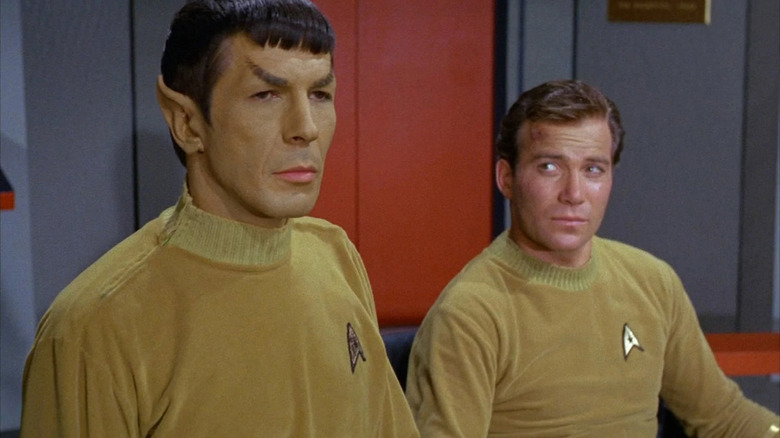
"You know. 1966? 79 episodes, about 30 good ones," said Philip J. Fry of "Futurama" to the jarred, floating head of Leonard Nimoy. This is his animated opinion, of course, but a better question isn't how many are good, but how many of the original "Star Trek" episodes are great. Would you believe 21?
Determining greatness is subjective of course. Popularity isn't a fair indicator of quality, and some fan favorites are guilty pleasures, while others are fun but defective in ways that knock them down from great to merely good. Any episode's overall quality depends on multiple factors: the uniqueness of the premise, the quality of the writing, the story beats, the characterization, guest stars, action, music, production values, and even visual effects.
Speaking of visual effects, we're not talking about the 15-year-old "remastered" CGI, which already look dated and cartoonish. We're going O.G. all the way. The criteria here is ranking these as the total package rather than the sum of their parts. With that in mind, here's a perhaps controversial list of the 21 greatest "Star Trek: The Original Series" episodes.
21. A Piece of the Action (Season 2, Episode 17)
Although humorous moments abound throughout the original "Star Trek," there aren't many outright comedy episodes. In fact, there are only three: "I Mudd," "A Piece of the Action," and "The Trouble with Tribbles." Most fans I know vote the straight "Tribbles" ticket, but that episode is merely cute-funny, whereas the over-the-top "A Piece of the Action," is actually genuinely funny. The script by Gene L. Coon is more absurd than "Tribbles" and features more comic business. The cherry on top was its helmer, James Komac, who was a gifted comedy writer and director of hundreds of episodes of shows including "Welcome Back, Kotter" and "Chico and the Man" (which he created).
This episode is almost a meta-commentary and spoof on the "Star Trek" schtick of "strange new worlds" which end up being monocultures thinly based on Earth's history. Here we see why the Prime Directive exists: an entire civilization has modeled itself on the popular mythos of Roaring '20s Chicago mobs. It's literally Planet Cosplay, and an unintentional spoof of fandoms then and now. Two things keep it at this end of the list: it's shamelessly riffing on "Robin and the 7 Hoods" (1964), and it's almost irredeemably dumb. Fortunately, it's dumb fun, and fun enough to be among the best. "Right?" "Riiiiight."
20. Space Seed (Season 1, Episode 22)
You might be surprised that this comes in so low in a list of greats, but that it merits inclusion at all relies solely on the sheer screen presence and magnetism of its guest star. Khan Noonien Singh is an arrogant egotist and tyrant, but Ricardo Montalbán's confident performance makes him watchable. Minus him, the story defects would relegate this episode to merely "good." Many put this in their top 10, but I suspect that's because it basks in the reflected glow of its cinematic follow-up "The Wrath of Khan."
The script is serviceable but unmemorable and commits the sin of making our heroes foolish instead of making Khan's intelligence and cunning the real danger. Kirk hands this unknown and suspicious character unfettered access to the ship's technical library on a silver platter, and historian Marla McGivers is a pushover who betrays all her shipmates because she's a fangirl of brutish dictators.
Weak story aside, the episode does have strengths. All the performances are good, and the story moves along at a brisk pace. There's memorable dialog, and McCoy really shines when he isn't cowed by Khan holding a scalpel to his neck. There's also some of the best miniature effects work on the show, going to the expense of a custom-made model of the Botany Bay . Montalbán is what makes it a best episode at all, but he alone can't elevate it.
19. The Conscience of the King (Season 1, Episode 13)
This least "Star Trek"-y of "Treks" scores points for being just that. The series premise allows it to be a semi-anthology, able to shift genres without breaking format, so one week it's a psychological drama about the duality of human nature, another time it's about cold war proxies, or planet-killing doomsday machines by way of "Moby Dick," or — as in this case — a Shakespearean tragedy about mercy and revenge. Just As Hamlet must determine whether or not his uncle Claudius murdered his father, so must Captain Kirk determine if actor Anton Karidian is the man once known as Kodos the Executioner.
Writer Barry Trivers cleverly frames his story within the play that informs it, a bit of dramaturgical license that permits a more theatrical approach. Take, for example, this bit of dialogue from Lenore Karidian: "There's a stain of cruelty on your shining armor, Captain. You could have spared him, and me. You talked of using tools. I was a tool, wasn't l? A tool to use against my father."
This episode exemplifies a shadowy aspect of Kirk's affairs rarely discussed in how he weaponizes romance to get what he wants. The ultimate irony is that he plays Karidian's daughter Lenore in order to get close to her father only to learn that she's been playing him. That it's so different is a double-edged blade that simultaneously makes it a best episode, but nowhere near the top. It was a great stretch for the show.
18. The Immunity Syndrome (Season 2, Episode 18)
This one barely edges out the not-dissimilar and more popular "The Doomsday Machine." Both feature the crew of a sister ship annihilated by a huge alien thing endangering life throughout the galaxy. But where "Doomsday" is a straightforward adventure story driven by an Ahab-like guest star, "Immunity" is more personal, as it features some great and properly motivated Spock and McCoy conflict.
Too often Bones would goad Spock for no reason, but here their back and forth is professional: two scientists vying for an opportunity to study this alien organism, each feels himself the most qualified to take on what promises to be a suicide mission, and each, perhaps, choosing to make the sacrifice rather than let the other die. But it's Kirk who has to make the final, heartbreaking choice of which of his friends to send. That's classic "Trek."
Given its budget and the visual effects tech of the time, "Star Trek" was rarely able to get across truly alien life forms, but this is a notable exception, and the conceit that the Enterprise must enter the alien entity as a virus infects a cell is a nice twist. The visual effects of the space amoeba thing are fabulous and weird, something the 2007 remastered CGI does not improve on.
17. Day of the Dove (Season 3, Episode 7)
The third season has no classic episodes, but a few come close. "Day of the Dove" is the best of the bunch. The simple premise of exploiting bigotry between our heroes and their cold-war counterparts, the Klingons, works better than it ought. If you want to look for a message, the alien entity that fuels the very hatred and violence it feeds upon can be read as a stand-in for the military-industrial complex, which fans the flames of conflict in order to sell weapons in a perpetual feedback loop. Alternatively, you can just take it for a MacGuffin.
The nefarious influence of the alien entity memorably amplifies the slightest biases of the Enterprise crew, and it's uncomfortable to hear blatant racism coming of out our noble heroes' mouths, especially Scotty's attack on Spock. Michael Ansara plays Kang as no mere mustache-twirling bad guy, but as a shrewd enemy starship commander, an honorable warrior, and a fine opposite to Kirk. By turns personable, calculating, and violent, he's a model Original Series Klingon. Frankly, I'd rather watch him than Khan; your mileage may vary. It's got action. It's got character conflict for days. It's the best the third season has to offer, but it's not as great as the first and second-season entries coming up.
16. Tomorrow Is Yesterday (Season 1, Episode 19)
The original "Star Trek" didn't play with time travel much, and when it did the results were either very good or they were horrid, with the backdoor pilot "Assignment: Earth" being the low point. "Tomorrow Is Yesterday" features the most offbeat teaser of the series, following an Air Force F-104 interceptor, with the visual punchline that the bogie it's after is the USS Enterprise.
What follows is illogical as all get out, but the gimmick of the Enterprise being tracked as a UFO and having to undo the temporal damage it's done by being photographed and accidentally crushing that Air Force interceptor is great and the story milks it for all it's worth. No real depth here, but the fun is all in the plot events and reactions of the crew.
There's some great in-character stuff in the episode, including Spock's statement that he too doesn't believe in "little green men," and his one-star ranking of the Air Force film of the Enterprise as "bad photography." Kirk's playfully resigned responses to his Air Force interrogator are great, too. And, hey, Sulu even gets to get off the bridge. The main weakness is the "how does that work?" ending gimmick of beaming people back into their own bodies. Great, but not a classic.
15. Balance of Terror (Season 1, Episode 14)
A fan favorite for good reason, the episode depicts the loneliness of command as Kirk tries to seek and destroy a marauding alien vessel without triggering an outright war. Seeing some of the "lower decks" types makes the Enterprise feel more real and lived in and sells that Kirk's every decision has repercussions beyond the bridge. But it's Mark Lenard's perfectly pitched turn as the unnamed Romulan commander that's most memorable here. Torn over the ramifications of the performance of his duty, he's Kirk's equal in every way, and you can believe that he loses this battle not by dint of any personal failings but merely because his ship is outmatched by the much quicker and faster-firing Enterprise.
For 1966 the effects are great and largely still hold up. The Romulan ship is simple and distinctive, and the music is spot on. The main thing keeping it out of the top 10 is that it so baldly swipes elements of the films "Run Silent Run Deep" and "The Enemy Below," slapping pointed ears on the German Kriegsmarine story from the latter film, borrowing its war-weary commander and a subordinate fanatically loyal to their political leader. In "Arena," the show paid for the rights of the story it was cribbed from and credited the author. No such screen credit graces this obvious lift.
14. The Ultimate Computer (Season 2, Episode 24)
Kirk's infamous for offing overzealous computers (see: Landru in "Return of the Archons," Nomad in "The Changeling," and the androids of "I Mudd"), but his personal best computer kill is in "The Ultimate Computer." Here he doesn't merely meltdown the M5 Multitronic unit by confronting its flawed logic regarding its purpose; he aims a precise surgical strike at the chink he spots in its programming armor: appealing to the morality inherent in the memory engrams its all too human creator imprinted it with, causing it to reason it must die to pay for the sin of murder.
This episode is character-driven, with Kirk confronting his own redundancy and possible irrelevancy even as Spock and McCoy make their loyalty and friendship clear. Guest star William Marshall's turn as the deranged Dr. Daystrom is a standout, ranking among the best of the show.
All this drama is supported by some fine action, as M5 reduces a redshirt to a puff of smoke, photon torpedoes a robot ship, and then nearly destroys four sister ships of the Enterprise, actually killing the entire crew of one. Even the light ending — which often play as callous given the events which precede them in many episodes — is acceptable here because it's about Spock and McCoy, not Kirk. But it's still Kirk vs. the Computer, and those are never "Star Trek" at the very top of their game.
13. The Cage (Original Pilot)
Forget "The Menagerie" with its paper-thin envelope around the first pilot, repetitive courtroom scenes, and forced cliffhangers, all of which render it a solid but not great installment. But on its own "The Cage" is not just a great launchpad for what "Star Trek" is and would become, but an imaginative and well-executed story in its own right. Gene Roddenberry's script is smart, with the atrophied Talosian aliens a satirical stand-in for TV audiences who might rather live other people's fantasies than experience adventures of their own. While it's a bit talky and static in places, when they're in action it's great stuff — notably the laser cannon scene and Pike's illusory fight on Rigel VII.
Visually it's terrific. This was the most expensive episode ever made , and it shows. The sets, costumes, makeups, and many special effects are top-notch for a show of the era particularly the matte shot of the Rigel VII fortress. The pacing's a bit loose, the characters don't pop due to the largely meh casting, and "THE WOMEN!" Number One and Yeoman Colt secretly wanting to bone the Captain is cringeworthy. However, guest star Susan Oliver's performance is the standout here, followed by Leonard Nimoy as Spock. Ultimately, it's just as well that the far more energetic William Shatner stepped in to replace Jeffrey Hunter's less-than-charismatic version of Captain Pike .
12. Arena (Season 1, Episode 18)
If any episode of "Star Trek" is truly iconic, this is it. The action set piece on Cestus III is the biggest of any in the series, with running and jumping and explosions galore, a redshirt vaporization, a detonating tricorder, and a photon torpedo-sque mortar. Once back on the Enterprise, Kirk's dogged determination to overtake and destroy the enemy ship demonstrates the obsessive nature of his character, but communication with his alien foe plants a seed of doubt which ultimately empowers him to practice what he preached in "A Taste of Armageddon: " We're human beings with the blood of a million savage years on our hands, but we can stop it. We can admit that we're killers, but we're not going to kill today. That's all it takes. Knowing that we won't kill today."
Kirk doesn't kill, and it saves the day. It lands here amongst the best because the story ends with the overused first-season gimmick of the godlike entity — the others being Gary Mitchell, Charlie-X Evans and his Thasian truant officers, Trelane the god-child, and the Organians — but the Metrons are more a plot device than anything. The Gorn is a great and worthy adversary, even as its slow-motion gestures are laughable. Spock hanging a lantern on Kirk's cannon-building is a bit much, but hey, he's the costar and has to do something.
11. Where No Man Has Gone Before (Season 1, Episode 3)
This might be a surprise but despite the second pilot weirdness of different uniforms, series crew regulars appearing not at all (McCoy, Uhura) or in different jobs (Sulu is an astrophysicist), and Spock's not-quite-there characterization and more severe makeup, the core "Star Trek"-ness is there in spades. Kirk makes a risky decision in the first act and must deal with the building consequences for the balance of the show, finally shouldering personal responsibility for his decision in the worst way possible: in order to save his ship and crew, he's forced to kill a subordinate shipmate and friend.
The episode looks great (being far more expensive than any regular production episode), repurposes the planet set built for the even more expensive first pilot, and features more optical effects than would be the norm for a production episode. Most importantly, William Shatner's Kirk projects leading-man charisma of the sort that's arguably what sold the show. It also delivers on Gene Roddenberry's original high-concept pitch of a "Wagon Train to the stars" where stories would focus on strong guest stars interacting with the recurring cast. The script is not without its flaws, and had Gary Mitchell been a tad more likable the drama would have played even better. Still, two thumbs way up.
10. A Taste of Armageddon (Season 1, Episode 23)
"New civilizations" planet stories rarely yielded great episodes, often setting up straw man civilizations for Kirk to knock down, but this one bucks the trend with a story smart enough to rank among the best. Kirk vs. the Computer legendarily has Kirk talk the machine to death, but now and again he goes for the direct approach. Here the computers coldly run simulations and select innocents to die, and Kirk has zero compunction about blasting them, finally forcing the two civilizations to finally attempt to negotiate peace after 500 years of a "war" where death has been made so neat and tidy they see it as a necessary evil rather than something to stop.
Goodies include Scotty's head-butting with Ambassador Fox, Kirk's arguments about war with Anan 7, and Kirk threatening to have the Enterprise rain destruction down on a planet that's not faced a real attack in centuries. The moral? Any war held at arm's length is mere statistics, something the American people had grown accustomed to until television thrust the reality of Vietnam into their living rooms each evening. That's a lesson we must learn over and over again in conflicts where we increasingly use long-range and smart weapons to strike people we never even see. It's a message as relevant today as when it was first aired.
9. The Corbomite Maneuver (Season 1, Episode 10)
Effectively the "third pilot" of "Star Trek," this was the first regular production episode to go before the cameras and it had the luxury of a rehearsal day, a solid director, and a fine script. It even ends with a quintessential "Trek" twist: our implacable foe ends up being an erstwhile friend. By rights, this should've been the first episode to air as it sets up the whole show, but it was nowhere near ready at the premiere , in part due to the sheer number of optical effects in post-production. Dr. McCoy is wonderful from his first appearance, and his camaraderie and professional conflict with Kirk set the stage for their entire relationship.
The weird flagship Fesarius is pure alien goodness, and the Balok puppet is iconic. Memorable business includes Sulu's countdown, Spock's logic and resulting lack of imagination, Scotty's comment about Spock's parents, and McCoy and Kirk's conflict over Bailey. A highlight is the briefing room scene, with its lived-in atmosphere with piles of tapes and empty cups of coffee showing instead of telling us how hard the crew has been working on their predicament. Likewise, the Enterprise feels like a real lived-in ship, with corridors bustling with the crew, something the show would lose as fixed costs increased and studio budgets didn't grow to match . It's one of the 10 best, held back only because it drags in some spots.
8. The Galileo Seven (Season 1, Episode 16)
Albeit loosely inspired by the survivor drama "Five Came Back" (1939), this episode charts its own course as Spock tries and fails to resolve a potentially lethal situation with logic alone. It's rare that adventure shows of the time would depict a lead character failing, but that's just what "The Galileo Seven" does.
As in "The Corbomite Maneuver," we are again shown that Spock's logic can serve as blinders that prevent him from seeing all the possibilities even as he tells Scott "there are always alternatives." As such, he expects the giant natives to react rationally to a show of force and brings them right down on the party. He's likewise ill-equipped to deal with the emotional frailties of the crew under his command, especially the insolent and insubordinate Lt. Boma, memorably played by Don Marshall, later of "Land of the Giants."
The B-story with Kirk desperately trying to locate the lost shuttle against a ticking clock demonstrates the sorts of no-win scenarios a ship captain must face. The production scores visually for the full-size shuttlecraft, as well as the visual effects depicting it and its sister crafts' departure and return to the Enterprise hangar deck.
7. The Naked Time (Season 1, Episode 4)
The fourth episode aired, "The Naked Time" is the foundational character-building segment of the series, peeling away the surface of Kirk and Spock and revealing a bit of what makes them tick. It's also entertaining as hell, with a slow burn as the crew is at first blissfully ignorant of the inhibition-inhibiting compound brought aboard and then having to deal with the resulting chaos. Sulu's descent into madness is charming, and George Takei was always at his most charismatic when he got to play unhinged. Sadly, neither Uhura nor Rand's secret selves get explored, and poor Chapel's reduced to pining for Spock as her primary character trait for most of the series.
The only weak spot here is that the "science" part of science fiction went out of the airlock. A collapsing planet is as preposterous an idea as the notion that the Enterprise is forced to constantly alter its orbit to study it. But guest crewman Kevin Riley is fun and Scotty gets two great lines here, the first being "I can't change the laws of physics," and the second an example of technobabble that's simple and audience-friendly: "You can't mix matter and antimatter cold!"
6. The Devil in the Dark (Season 1, Episode 25)
The episode is unique for being the only one to open with no sign of the Enterprise or her crew. Effectively a redo of series opener "The Man Trap," this episode succeeds where its predecessor fails not merely because the crew act more rationally but because a narrative twist turns the titular "Devil" into a sympathetic character. The Kirk-Spock dynamic is on fine display here as Spock first wishes to capture the creature alive and Kirk wants it dead, but Spock's feelings for his captain override his desire for scientific knowledge the instant he believes Kirk is in danger.
Spock urges his captain to "Kill it!" even as Kirk susses out that the creature may be more than a monster. This is the first instance of Spock mind-melding with a wholly alien life form, a gimmick which would be taken to preposterous extremes in "Star Trek: The Motion Picture." Leonard Nimoy's "pain!" emoting is a bit over the top even for the time and keeps the episode out of the top five. Otherwise, he and William Shatner display the chemistry that made the show work even when the scripts let them down. This script does not let them down.
5. Journey to Babel (Season 2, Episode 10)
This world-building episode fires on all cylinders and never misses a beat. If writers then or now needed a model for how to write "Star Trek," this is it, and it's hands down the best episode penned by Dorothy "D.C." Fontana. There's a story conflict as the Enterprise ferries quarrelsome ambassadors and their aides to the titular "Babel" conference over a matter of Federation business. There's an interpersonal conflict between not just Spock and his parents but also between Spock and Kirk and Bones over relinquishing command.
There's physical conflict as ambassadors brawl, one is murdered, and Kirk is ambushed and wounded. We meet lots of aliens, see a bit of galactic politics, and get a nail-biter of a finish as McCoy tries to perform delicate surgery while Kirk struggles to keep it together amidst attacks by a seemingly unstoppable, unknown ship.
Mark Lenard returns not as a Romulan but as Spock's Vulcan father, Ambassador Sarek, who picks up on Leonard Nimoy's Vulcan portrayal and crafts one uniquely his own. Memorable too is Reggie Nalder, whose burn-scarred face and Austrian accent accentuate his alienness in the role of the blue-skinned Andorian delegate Thelev, and established Andorians as Federation members , who would not be explored on TV for decades. Spock's family drama is a bit conventional for an alien culture, and just a dash more of the Vulcan alienness we got in Ted Sturgeon's "Amok Time" would have made this perfect.
4. The Enemy Within (Season 1, episode 5)
With a script that takes a pinch of "Strange Case of Dr. Jekyll and Mr. Hyde" and adds a dash of "All About Eve," "The Enemy Within" really delivers on the "Star Trek" promise to be an "adult" show by exploring the uncomfortable idea that even the noblest have a dark side, and that our shadow selves are necessary parts of being human. The scenes with Kirk, Spock, and McCoy crackle with intellectual and emotional tension, and Spock finding Kirk's condition so "fascinating" neatly propels the drama while hinting at his own duality. William Shatner's twin performances as the understated compassionate Kirk and the scenery-chewing "imposter" demonstrate his range.
A few missteps are the weird editing, where events happen out of order, such as when Spock states they have an intruder aboard long after they've established the transporter duplicated the dog-thing; Rand being expected to stand up for herself in front of her alleged attacker, Kirk; and the silliness of Spock reporting that the malfunctioning transporter duplicated the thermal heaters beamed down and not thinking to beam down blankets or other insulation to help keep the stranded Sulu and company from becoming human popsicles. Additionally, Spock's closing crack at Rand about the imposter's qualities was and remains cringeworthy.
3. Mirror Mirror (Season 2, Episode 4)
This is the poster child for episodes that manage to become classics despite the premise being as dumb as a box of rocks. Absolutely nothing about the scenario makes a lick of sense. There's a parallel universe where all the same people end up on the same ship despite having vastly different histories and a culture of assassination. The starships in both universes happen to be on the same planet and beaming the same four people at the exact same time, and our parallel-universe leaping characters and their barbaric counterparts somehow switch wardrobes — and presumably underwear — mid-transporter beam.
What saves it is the sheer entertainment value of this gaudier imperial Starfleet and the skewed versions of familiar regulars inhabiting it. Evil Sulu's a sweaty seducer, mirror Chekov is a back-stabbing opportunist, and bearded Spock was a meme before we knew we had memes. The best Uhura performance can be found here, and Nichelle Nichols should be remembered for this over that overrated and involuntary interracial kiss. The only thing that could have made it better was had Yeoman Rand been brought back as "the Captain's Woman." The big speech to mirror Spock about the illogic of waste is Kirk at his Kirkiest, and that's the perfect capper on a perfectly entertaining classic that ranks right near the top.
2. Amok Time (Season 2, Episode 1)
The Vulcan episode to rule them all is one of those rare world-building episodes of the original series, except here the strange new world is Spock's home planet. Vulcan civilization is memorably introduced in a most unexpected way by demonstrating that the cooly logical Spock is anything but when it's time to swim upstream and spawn, whereas his mate-to-be, T'Pring , employs the logic Spock adores in order to escape her obligations to him and make her own choices.
Everything about the scenes on Vulcan works splendidly, from matriarch T'Pau's officiating and T'Pring's challenge to the big Kirk-Spock battle. Okay, and the wonderful and memorable OTT music is the icing on the cake. The first half on the Enterprise has some nice comic moments as well as some solid Kirk-Spock-McCoy interaction, but, as with many episodes where a mystery is involved, the tension of the first half doesn't play quite as well on repeat viewings.
Fortunately, the drama and conflict on Vulcan are top-notch and hold up. The punchline in sickbay is a classic, because the bigger the dramatic tension, the bigger the comic release, and, given all the action on the planet, the funny tag feels totally earned for a change.
1. The City on the Edge of Forever (Season 1, Episode 28)
No surprise here, as it tops a great many lists, but "City" excels not only because the core drama is compelling but because of the care with which it was put together. The most expensive regular production episode of the series , all the money is up there on the screen, from the period costumes to the backlot shooting, new sets, stock footage, and the flashing Guardian time donut. William Shatner, Leonard Nimoy, and DeForest Kelley are all in fine form here. Guest star Joan Collins isn't great but she's fine.
Story-wise, the fish-out-of-water situation, the incredibly high stakes, and the crushing inevitable tragedy make this the exemplary segment. Even gutted by ham-fisted staff rewrites by the "Trek" staff (in my opinion), Harlan Ellison's core story premise remains moving in spite of the on-the-nose sermon by Edith, the racist joke at Spock's expense, and the complete absence of the tragic Trooper character on whom the irony of who amongst us "matters" hinged. Kirk's episode-closing "Let's get the hell out of here" was not any kind of TV first, but it was the perfect minimalist button that the story needed. What more was there to say?
- Search Please fill out this field.
- Newsletters
- Sweepstakes
The 10 standout episodes of Star Trek: The Original Series
Ready to explore (or revisit) strange new worlds and smart sci-fi adventure? Launch into the Final Frontier with our list of 10 essential episodes of the original Star Trek.
A five-year mission that's now headed into its seventh decade, the Star Trek franchise is still boldly going where no one has gone before. More installments of the franchise are on air then ever, with something to offer almost every Trekkie in its rapidly expanding universe. However, Star Trek: The Original Series is the big bang that started it all. Gene Roddenberry's optimistic vision of the future — produced by Lucille Ball , no less — debuted in September of 1966 and ran for three seasons on NBC before finding new life in syndication.
While the series' Prime Directive seemed to be shredding Capt. Kirk's shirt as often as possible, our mission is to represent a variety of agreed upon classics from the U.S.S. Enterprise's maiden voyage that would delight both the original and next generation of fans.
So fire up your favorite snacks in the replicator, silence your tricorder, and beam on down our list of the 10 must-watch episodes of Star Trek: The Original Series , all of which are available to stream in remastered form on Paramount + .
"Where No Man Has Gone Before" (Season 1, episode 3)
After the Enterprise goes through an energy rift at the edge of the galaxy, Captain Kirk's ( William Shatner ) friend and shipmate, Lt. Commander Gary Mitchell (Gary Lockwood), begins to develop terrifying ESP abilities that grow stronger by the minute. As he makes the transition from man to "god," he becomes increasingly more dangerous and detached from humanity. Ship psychiatrist Dr. Elizabeth Dehner ( Sally Kellerman ) believes his mutation can help mankind evolve, but Spock ( Leonard Nimoy ) is adamant he must be killed before he destroys them all. Will Kirk choose his best friend over the best interests of his crew — and the universe?
"Where No Man Has Gone Before" is most famous for being the second pilot filmed for the series, and introducing viewers to Captain James T. Kirk, Chief Engineer Scotty (James Doohan), and Lieutenant Sulu ( George Takei ). It's also just a great hour of sci-fi storytelling. This superior first episode seamlessly mixes action, high stakes emotions, and tough ethical questions, setting the blueprint for the franchise.
"The City on the Edge of Forever" (Season 1, episode 28)
When a time disruption from a nearby planet rocks the Enterprise, Dr. McCoy ( DeForest Kelley ) — aka Bones — accidentally injects himself with an overdose of a dangerous drug. Driven mad, he flees to the planet below and goes through the time warp, changing history and erasing the Federation of Planets from existence. Kirk and Spock follow him to set things right, and find themselves in 1930s Depression-era New York.
As they search for Bones, Kirk meets and falls in love with a social worker named Edith Wheeler ( Joan Collins ) whose fate, it turns out, will determine the course of humanity. Once again, Kirk must choose between someone he loves and the greater good. One of Trek 's most emotionally charged hours, "The City on the Edge of Forever" — scripted by Harlan Ellison — is considered by many to be the greatest episode of all-time.
"Space Seed" (Season 1, episode 22)
The Enterprise team stumbles upon the marooned S.S. Botany Bay in deep space and awakens the crew from suspended animation. They soon discover these lost spacefarers were exiled from Earth during the infamous Eugenics Wars of the 1990s, and our heroes have unwittingly unleashed a genetically enhanced super-tyrant named Khan Noonien Singh ( Ricardo Montalban ) in the 23rd century.
Montalban's magnetic, calculating would-be-ruler serves as a perfect foil for Shatner's compassionate, tactical Kirk, leading to a great one-on-one showdown between the two for control of the ship. This season one episode is the introduction of the series' most infamous villain, who 15 years later will headline Star Trek II: The Wrath of Khan , widely regarded as the best film in the franchise.
"Amok Time" (Season 2, episode 1)
Kirk vs. Spock! Kirk's shirt ripped open (again)! Spock in heat! This episode has everything a fan of the duo that launched a thousand slash fics could want. Every seven years, a Vulcan must return home for an ancient mating ceremony called "pon farr." When Kirk and Bones accompany him, they find themselves dealing with (farr) more than they bargained for when the Captain is forced to battle Spock in a ritual fight to the death.
In addition to the showdown between the leads, "Amok Time" has several other firsts: the first use of the Vulcan Salute, the first appearance of Ensign Pavel Chekov (Walter Koenig), and the first glimpse of the planet Vulcan itself. This perennial favorite is also heavily referenced in Star Trek: Strange New Worlds ' fifth episode — titled " Spock Amok " — on Paramount +.
"Mirror, Mirror" (Season 2, episode 4)
An away team consisting of Kirk, Bones, Uhura ( Nichelle Nichols ), and Scotty are sent to an alternate dimension when they are caught in an ion storm mid-transport. This "mirror" dimension is populated by violent doppelgangers of the Enterprise crew who serve the Terran Empire instead of the Federation of Planets. The foursome must navigate the cutthroat nature of this universe and find a way back before their secret is exposed — all while surviving a mutiny to overthrow this reality's Kirk. Hip daggers, bare midriffs, and Spock's goatee are just a few of the signs that things in this universe are askew.
Although Evil Bearded Spock is certainly fun to see, George Takei gives the standout performance as a delightfully evil Sulu, complete with a badass facial scar. This episode is a highlight of the original series and forms the foundation for several stories in future Trek franchises like Deep Space Nine , Enterprise , and Discovery .
"The Trouble with Tribbles" (Season 2, episode 15)
A fan favorite episode, "The Trouble with Tribbles" is a comedic left turn that shouldn't work, but absolutely does. Starring adorable little furballs who are "born pregnant" and multiply at a rapid pace, this zany hour allows the heady sci-fi questions of morality to take a back seat in favor of punchlines and hijinks.
The actual plot of the episode revolves around Kirk protecting a supply of space grain essential to Starfleet's sovereignty over a contested planet. The fun begins, however, when Uhura picks up one of the tiny tribbles while on shore leave at Space Station K-7 and unleashes an infestation on every corner of the Enterprise — including Kirk's lunch. The Captain's exasperated responses to the growing tribble crisis are comedy gold, especially as he seems to be the only one immune to their cooing charms. "Tribbles" also features a fantastic slapstick bar fight between Scotty, Chekov, and a handful of Klingon officers for the honor of the Enterprise. This episode is a fun detour into the lighter side of the crew's five-year mission.
"Balance of Terror" (Season 1, episode 14)
Kirk and company find themselves in an action-packed showdown with the Romulans when they investigate a mysterious loss of communication with Federation outposts near the Neutral Zone. Despite a history of war with Earth, no one has ever laid eyes on an actual member of their species — until now.
As the Romulans are believed to be the violent cousins of the Vulcans, Spock becomes the subject of suspicion and xenophobia from some of the crew — particularly Lt. Stiles (guest star Paul Comi) — whose ancestors were killed in the Earth-Romulan War. The story's point-of-view shifts between the two vessels, allowing the viewer to see that the warring foes are more alike than they realize.
This season one classic features the first appearance of the Romulans — who will go on to be recurring antagonists for the heroes of the franchise. Also, keep an eye out for actor Mark Lenard as the Romulan Commander. He'll return to the series in a recurring role as Spock's father.
"The Corbomite Maneuver" (Season 1, episode 10)
While exploring an uncharted area of space, the Enterprise is pursued by a mysterious cube emitting harmful radiation. To protect themselves, they lay waste to it, and incur the wrath of Balok, commander of a technologically superior alien race. He takes control of the Enterprise's systems and declares the ship, and everyone onboard, will be destroyed in 10 minutes. A tense hour with a really wild twist ending, this installment showcases Kirk's ingenuity and characteristic refusal to lose — one of the many times the Captain will boldy bluff where no man has bluffed before.
"The Corbomite Maneuver" is also the first time DeForest Kelley (McCoy) and Nichelle Nichols (Uhura) played their iconic characters, although they appear earlier in the series due to NBC originally airing episodes out of production order.

"The Doomsday Machine" (Season 2, episode 6)
Our intrepid explorers receive a distress signal from fellow Starfleet ship the U.S.S. Constellation and rush to its aid. Upon arrival, they find Commodore Matthew Decker (William Windom) — the ship's commander and sole survivor — wracked with guilt and suffering from PTSD. Decker's entire crew was annihilated by a massive energy weapon of unknown origin that destroyed the entire star system.
Pulling rank, he takes command of his rescuer's ship, and puts the crew of the Enterprise in the crosshairs of the unstoppable world-killing device. Kirk, marooned on Decker's derelict starship, must figure out a way to rescue the Enterprise from both the machine and an out-of-control superior officer. Introducing a planet-ending energy weapon 10 years before Star Wars , this episode features a real nail-biter of an ending.
Fun fact for the continuity-conscious : Decker's son, Willard Decker ( Stephen Collins ), will play a prominent role in 1979's Star Trek: The Motion Picture .
"Arena" (Season 1, episode 18)
Captain Kirk, Spock, Bones, and an unfortunate " Redshirt " arrive at the Cestus III Outpost for a diplomatic mission and find it annihilated by an alien race called the Gorn. Seeking revenge, Kirk pushes the Enterprise to pursue the Gorn starship and destroy it. The chase leads into an unmapped sector of space ruled by a powerful force calling themselves the Metrons. Outraged by the brutality of both ships, the Metrons force the two captains to settle their dispute in a fight to the death on a desert planet. The winner will leave the sector unharmed, while the loser, and their crew, will die.
The bulk of this episode involves William Shatner being chased by an actor in a giant rubber lizard suit — and honestly, it rules. Yes, the suit looks goofy, but the showdown is fun as hell and the message of the story is classic Star Trek : sometimes there is more going on beneath the surface than we realize. Very few Star Trek villains are ever just one-dimensional bad guys, and the Gorn are no exception.
Fun fact : Ted Cassidy, who provides the voice for the Gorn captain, also provided the voice of Balok in "The Corbomite Maneuver."
Related content:
- Nichelle Nichols' life in photos
- Stars across the galaxy mourn 'trailblazing, incomparable' Nichelle Nichols: 'My heart is heavy'
- William Shatner, George Takei, and fans celebrate #StarTrekDay for sci-fi series anniversary
Related Articles
Best Star Trek: The Original Series episodes
These are the best Star Trek: The Original Series episodes to watch to understand the show's enduring legacy throughout the franchise.
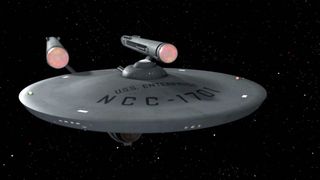
The first thing you need to know about Star Trek: The Original Series is that it only lasted for three seasons. The second thing you need to know is that there’s a pretty good reason for that. Its catalog of episodes is wildly uneven, with stories that range from the cringeworthy to the simply dull, but the good ones are oh, so very good.
In fact, the impact of the best Star Trek: The Original Series episodes is still being felt by the franchise to this very day. Some introduced characters that would later become legendary, others set a standard for storytelling that any show would be proud to match. Others laid a foundation for concepts, plotlines, or themes that would become part of the immutable essence of what “Star Trek” is.
It’s also worth mentioning that even when Star Trek whiffed, it was because the writers were swinging for the fences. Airing during an unprecedented era of U.S. social history, Star Trek genuinely wanted to give audiences a new way of looking at issues like racism, politics, war, and violence. Sometimes it succeeded, sometimes it didn’t, but there was true nobility in the attempt. And hey, it also made things like “phaser” and “transporter” everyday language, which is also pretty cool.
Even hardcore fans typically agree that revisiting the entire run of Star Trek: TOS isn’t the best use of your time, so here are the ten best Star Trek episodes to watch in order to fully soak up the vibe.
If you're on the other side of the of the Kirk vs Picard debate, then you should check out our guide to the best Star Trek: The Next Generation episodes too.
10. The Tholian Web

- Season 3, Episode 9
- Original airdate: November 15, 1968
The heart of TOS was always the unlikely trio of Kirk, Spock, and McCoy, whose relationship is a tumultuous mix of camaraderie, respect, affection, and frustration. Kirk disappears while the Enterprise is investigating the cause behind the loss of all hands aboard The Defiant, leaving Spock and McCoy to argue about what to do next.
The ship is in jeopardy, but Kirk might still be alive — Spock’s cool logic is naturally at odds with McCoy’s passionate response. Kirk was always the buffer between those two strong personalities, and watching them interact without his calming presence is, as Spock would say, fascinating.
9. The Doomsday Machine
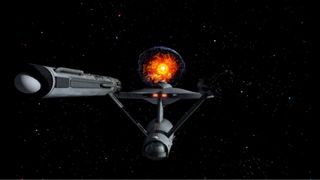
- Season 2, Episode 6
- Original airdate: October 20, 1967
Beneath its sheen of bravado and machismo, Star Trek was ultimately about self-sacrifice for the greater good. Kirk was never hesitant to put himself at risk to protect his crew, a character trait he inherited from his father if the 2009 Kelvin timeline movie is to be believed. The Enterprise discovers The Constellation after its disastrous run-in with a planet killer: a miles-long machine that destroys planets and devours the rubble as fuel. Phasers have no effect on the behemoth, so Kirk devises a plan to fly the Constellation straight down its maw and explode it from within.
Fortunately, Spock and Scotty manage a small alteration to the plan and beam Kirk back to the Enterprise before he meets his maker. The Enterprise has a habit of going toe-to-toe with enormous threats, and the Doomsday Machine is one of the biggest.
8. The Squire of Gothos

- Season 1, Episode 17
- Original airdate: January 12, 1967
The Squire of Gothos walked so that Q could run. A being calling himself General Trelane (retired) starts messing with Kirk and crew for his own amusement. He snatches them from their ship, changes their clothes, even forces them to stand trial — sound familiar?
It’s impossible to watch The Squire of Gothos and not see a direct throughline to John DeLancie’s portrayal of the all-powerful imp who delights in Picard’s frustration. Interestingly, the end of the episode appears to reveal Trelane to be a child (or at least childlike), despite his appearance.
7. Space Seed
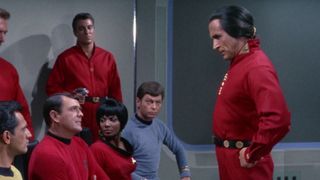
- Season 1, Episode 22
- Original airdate: February 16, 1967
If you read our list of Star Trek movies ranked worst to best , you already know why this episode makes the list. Space Seed introduces the one and only Khan Noonien Singh and sets up the action that will later take place in the film The Wrath of Khan.
The Enterprise comes across Khan and his followers in stasis. Upon their revival, they attempt to take over the Enterprise. Their plan is foiled and Kirk exiles them to Ceti Alpha V…and we all know what happens next. Even if it didn’t precede such a phenomenal film, Space Seed would make this list as an example of how fast and loose Kirk often plays with others’ lives.
6. Amok Time
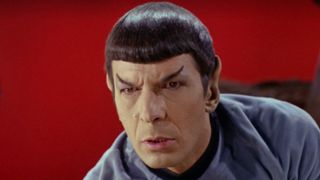
- Season 2, Episode 1
- Original airdate: September 15, 1967
First appearance of Pavel Chekov and the very first glimpse of Vulcan? Even if neither of those happened, Amok Time would still make this list for being one of many examples of Kirk being willing to to defy Starfleet in order to save his crew, and Spock in particular.
Kirk requests permission to take the Enterprise to Vulcan because Spock is in the grips of pon farr, the “mate or die” condition unique to Vulcans. On Vulcan, Spock’s intended demands that he fight a champion of her choosing in order to prove he deserves her — and then she selects Kirk. Ever seen Cable Guy? Yep, this is what that’s parodying .
5. The Menagerie Pts 1 & 2
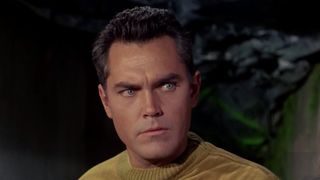
- Season 1, Episodes 11 & 12
- Original airdate: November 17 & 24, 1966
Star Trek’s beginning was a little messy. Its first pilot (yes, there was more than one) featured Captain Pike, not Kirk, in an episode called The Cage. The Menagerie cleverly repackages that episode as Spock recalling events that took place when he served under Captain Pike — a relationship recreated first in Star Trek Discovery and more recently in Strange New Worlds.
Majel Barrett, who would go on to not just be the voice of the Enterprise computer but also Counselor Troi’s mum, stars as Pike’s first officer, Number One. Few episodes of TOS passed on as many different kinds of legacy as The Menagerie.
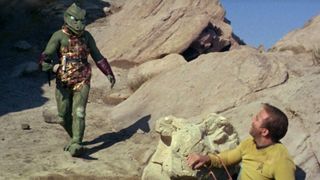
- Season 1, Episode 18
- Original airdate: January 19, 1967
Arena features one of Star Trek’s most frequently visited recurring themes: humanity’s propensity for violence. An unknown vessel fires upon the Enterprise, which gives chase. Both ships venture into the territory of the Metrons, which decide to settle the matter by pitting Kirk and the other vessel’s captain against each other in one-on-one combat. The winner’s ship gets to go free, the loser, not so much.
The other captain is the reptilian Gorn who Kirk fells after cobbling together a bazooka out of bamboo and rocks; if you were ever wondering where the “rudimentary lathe” joke from Galaxy Quest came from, now you know. When Kirk spares the Gorn’s life, the Metrons decide maybe there’s hope for humanity after all (another constant Star Trek refrain) and allow both ships to go free.
3. The Trouble With Tribbles
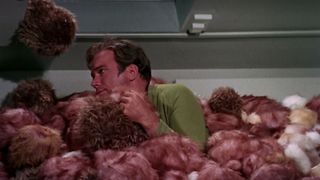
- Season 2, Episode 15
- Original airdate: Dec 29, 1967
Star Trek: TOS tackled plenty of serious social issues across its three seasons, but it wasn’t afraid to be funny, too. The Trouble With Tribbles is pure sitcom as the crew of the Enterprise discovers, adores, and then is slowly overtaken by the furry, purring creatures of the title.
Kirk alternately sits on one that’s found its way to the Captain’s chair, then finds himself buried in them after opening an overhead compartment. It’s a low-stakes, iconic romp that would later be revisited in the Deep Space Nine episode Trials and Tribble-ations.
2. Mirror, Mirror
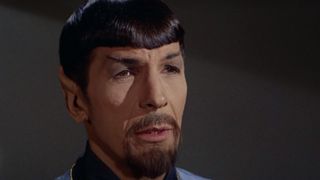
- Season 2, Episode 4
- Original airdate: October 6, 1967
A transporter malfunction swaps Kirk, McCoy, Scotty, and Uhura with their “evil” selves from the mirror universe, a totalitarian hellscape that would be revisited thematically, if not actually, in virtually every iteration of Trek to follow.
The crew of the ISS Enterprise and that of the USS Enterprise both work to discover why their crewmates aren’t quite themselves and then, upon sussing the answer, send them home. It’s a fun episode in and of itself, but a must-have on the list given the impact it would end up having.
1. The City on the Edge of Forever
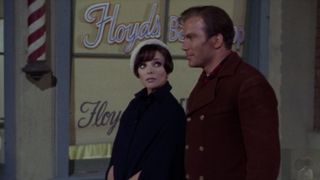
- Season 1, Episode 28
- Original airdate: April 6, 1967
This may be the best-known episode of TOS. Harlan Ellison pitched the idea and wrote the first version of the story, but the rewrites from Gene Roddenberry (among others) made him hate the eventual script so much he asked to have his name struck from it. Ellison would continue to loudly complain about on City of the Edge of Forever for the rest of his career, but the episode is still an all-time great.
McCoy, drugged out of his mind, stumbles through a time portal and winds up changing the timeline. The Guardian of Forever allows Kirk and Spock to go through the portal after him in an attempt to clean things up. While visiting Earth’s past, Kirk falls in love with Edith Keeler, unforgettably played by Joan Collins. Too late, he discovers the event that changes the future: McCoy saving Edith’s life.
Kirk being forced to let her die in order to preserve the future is a personal tragedy that underscores that beneath the phasers, transporters, subspace anomalies, and cranial ridges, Star Trek is about exploring what it means to be human.
Join our Space Forums to keep talking space on the latest missions, night sky and more! And if you have a news tip, correction or comment, let us know at: [email protected].
Get the Space.com Newsletter
Breaking space news, the latest updates on rocket launches, skywatching events and more!
Susan Arendt is a freelance writer, editor, and consultant living in Burleson, TX. She's a huge sci-fi TV and movie buff, and will talk your Vulcan ears off about Star Trek. You can find more of her work at Wired, IGN, Polygon, or look for her on Twitter: @SusanArendt. Be prepared to see too many pictures of her dogs.
'Star Trek: Discovery' season 5 episode 6 goes old school and benefits because of it
Best sci-fi movies with 90%+ on Rotten Tomatoes
Curious asteroid Selam, spotted by NASA's Lucy spacecraft, is a cosmic toddler
Most Popular
- 2 Astronauts on the moon could stay fit by running in a Wheel of Death
- 3 Watch live: China launching Chang'e 6 mission to far side of the moon early May 3 (video)
- 4 Watch ULA assemble Atlas V rocket ahead of Boeing Starliner astronaut test flight (video)
- 5 NASA's Hubble Telescope is back in action — but its TESS exoplanet hunter may now be in trouble
- Copy from this list
- Report this list
10 Best Star Trek (The Original Series) Episodes
- Movies or TV
- IMDb Rating
- In Theaters
- Release Year
1. Star Trek (1966–1969) Episode: The City on the Edge of Forever (1967)
TV-PG | 50 min | Action, Adventure, Sci-Fi
When a temporarily insane Dr. McCoy accidentally changes history and destroys his time, Kirk and Spock follow him to prevent the disaster, but the price to do so is high.
Director: Joseph Pevney | Stars: William Shatner , Leonard Nimoy , Joan Collins , DeForest Kelley
Votes: 6,582
2. Star Trek (1966–1969) Episode: Mirror, Mirror (1967)
A transporter accident places Captain Kirk's landing party in an alternate universe, where the Enterprise is in the service of a barbarically brutal empire.
Director: Marc Daniels | Stars: William Shatner , Leonard Nimoy , DeForest Kelley , BarBara Luna
Votes: 5,146
3. Star Trek (1966–1969) Episode: The Menagerie: Part I (1966)
Spock kidnaps the disabled Capt. Pike, hijacks the Enterprise, and then surrenders for court martial.
Directors: Marc Daniels , Robert Butler | Stars: William Shatner , Leonard Nimoy , Jeffrey Hunter , Susan Oliver
Votes: 4,864
The Menagerie, Pt. 1 & Pt. 2
4. Star Trek (1966–1969) Episode: Space Seed (1967)
While on patrol in deep space, Captain Kirk and his crew find and revive a genetically-engineered world conqueror and his compatriots from Earth's Twentieth Century.
Director: Marc Daniels | Stars: William Shatner , Leonard Nimoy , Ricardo Montalban , Madlyn Rhue
Votes: 5,414
5. Star Trek (1966–1969) Episode: All Our Yesterdays (1969)
When Kirk, Spock and McCoy investigate the disappearance of a doomed planet's population, they find themselves trapped in different periods of that world's past.
Director: Marvin J. Chomsky | Stars: William Shatner , Leonard Nimoy , DeForest Kelley , Mariette Hartley
Votes: 3,397
6. Star Trek (1966–1969) Episode: A Taste of Armageddon (1967)
Kirk and Spock must save their ship's crew when they are all declared killed in action in a bizarre computer simulated war where the actual deaths must nevertheless occur.
Director: Joseph Pevney | Stars: William Shatner , Leonard Nimoy , David Opatoshu , Gene Lyons
Votes: 4,196
7. Star Trek (1966–1969) Episode: The Doomsday Machine (1967)
The USS Enterprise encounters the wrecked USS Constellation and its distraught commodore who's determined to stop the giant planet-destroying robot ship that killed his crew.
Director: Marc Daniels | Stars: William Shatner , Leonard Nimoy , DeForest Kelley , William Windom
Votes: 4,506
8. Star Trek (1966–1969) Episode: Journey to Babel (1967)
The Enterprise hosts a number of quarrelling diplomats, including Spock's father, but someone on board has murder in mind.
Director: Joseph Pevney | Stars: William Shatner , Leonard Nimoy , DeForest Kelley , Jane Wyatt
Votes: 4,032
9. Star Trek (1966–1969) Episode: Balance of Terror (1966)
The Enterprise must decide on its response when a Romulan ship makes a destructively hostile armed probe of Federation territory.
Director: Vincent McEveety | Stars: William Shatner , Leonard Nimoy , Mark Lenard , Paul Comi
Votes: 5,701
10. Star Trek (1966–1969) Episode: The Trouble with Tribbles (1967)
To protect a space station with a vital grain shipment, Kirk must deal with Federation bureaucrats, a Klingon battle cruiser and a peddler who sells furry, purring, hungry little creatures as pets.
Director: Joseph Pevney | Stars: William Shatner , Leonard Nimoy , DeForest Kelley , William Schallert
Votes: 4,935
List Activity
Tell your friends, other lists by winterravyn.

Recently Viewed
Star Trek: The Best Episodes of The Original Series, Ranked
The first Star Trek series featured many of the greatest moments not only in the franchise, but in television itself.
The Star Trek franchise has gone through many iterations over the years. Star Trek, Star Trek: The Animated Series, Star Trek: The Next Generation, Star Trek: Deep Space Nine, Star Trek: Voyager, Star Trek: Enterprise, Star Trek: Discovery, Star Trek: Picard, Star Trek: Lower Decks, Star Trek: Prodigy, and Star Trek: Strange New Worlds have all delivered exceptional science fiction action and timely social commentary that has made the franchise one of the most beloved of all time.
As great as the extended franchise is, the original Star Trek often gets lost in nostalgia for the '90s era of the franchise with Picard, Sisko, and Janeway. The first Star Trek featured many of the greatest moments not only in the franchise, but in television itself. It showed that television not only could do exquisite science fiction, but that it could actually elevate the genre to new heights. Here are the greatest episodes of Star Trek, ranked!
20 "Arena"
The episode "Arena" may seem dated by today's standards due to the slow speed of the fight scene and the obviously rubber mask, but there's no denying that it serves as one of the most important episodes in the franchise's history. The concept of the Captain trapped on a hostile world with a dangerous enemy has been redone several times with episodes like "Darmok" in Star Trek: The Next Generation and "Waltz" in Star Trek: Deep Space Nine.
Not only that but Star Trek: Strange New Worlds has redesigned the Gorn into something terrifying by modern standards. "Arena" may be the most made fun of episode of the series, but Kirk's use of brain over brawn that defeated the Gorn is a shining example of how Kirk will always find a way to win.
Related: Gorn, Explained: A History of the Star Trek Aliens
19 "Operation Earth"
"Operation Earth" may just be the strangest episode of the entire series. That largely has to do with the fact that it was a back door pilot for a series that would focus on the mysterious time traveler Gary Seven and his unfortunately named cat, Isis. Kirk, Spock, and the crew are in the backseat of this episode as Seven outmaneuvers them at every turn.
It's truly an incredible thrilling adventure. The Earth is on the verge of nuclear armageddon and the crew of the Enterprise can do little to stop it. Watching Kirk and Spock powerless as the countdown continues towards the end of the future as they know it is one of the most chilling moments in the entire series. Gary Seven definitely needs more time in the spotlight.
18 "The Enterprise Incident"
One of the great things about the Star Trek series is how versatile it can be. The franchise has been a war epic, a detective story, a morality tale, and everything in between. "The Enterprise Incident" shows that the franchise can also work as a spy thriller. In this season three classic, Kirk and Spock infiltrate a Romulan vessel and dupe a clever Romulan Captain.
While the franchise didn't lean quite as hard on the spycraft after "The Enterprise Incident", there is one convention that the series has returned to again and again that began in this episode. That would be the act of putting one of the characters in alien makeup. Pretty much every Star Trek series has followed-up Kirk's brief time dressed as a Romulan.
17 "A Piece of the Action"
While the first Star Trek is widely beloved because of its political commentary, it should also be praised for the amount of humor it introduced into the franchise. Perhaps the funniest episode of the series came when Kirk and Spock dressed up as gangsters when an alien culture modeled their entire society off of Chicago gangster culture of the early 1900s. Seeing the crew do their best gangster impersonations, Kirk lie about a card game he just made up, and Spock insult the Captain for his reckless driving made for one of the most entertaining adventures in the franchise.
Many of the adventures of Kirk and Spock influenced space battles and political themes the franchise would draw on for decades to come, but "A Piece of the Action" inspired every holodeck episode, fantasy adventure, and silly dress-up comedy that Star Trek would do in every iteration of the franchise. Dixon Hill, Captain Proton, and Vic Fontaine all owe their existence to this one episode.
16 "Where No Man Has Gone Before"
The second attempt at a pilot proved to be the one that stuck. "Where No Man Has Gone Before" shows Captain Kirk having to face off against his best friend, Gary Mitchell, after he becomes a god-like Esper. Every convention that Star Trek would lean on for decades to come was birthed in this episode. Kirk has to outsmart a superior enemy while also confronting the very nature of godhood and his own mortality.
What does make this episode strange on a rewatch is how Gary Mitchell screws up Kirk's middle name when he makes his headstone. His name is James Tiberius Kirk, but the headstone reads "James R. Kirk". A psychic really should be able to get those details right.
15 "The Menagerie"
Star Trek made the best out of its failed first pilot when it framed the entire episode, "The Cage" , inside a new episode. "The Menagerie" focused on a court-martial and the horribly injured Captain Christopher Pike, the previous Captain of the Enterprise. "The Cage" is then used as evidence as we see Pike's legendary showdown with the Talosians that nearly began the series.
Not only is "The Menagerie" a fantastic episode, but it frames the entire arc of the new Christopher Pike played by Anson Mount. He learned in Star Trek: Discovery what his fate from "The Menagerie" would be , and it informs everything he does in Strange New Worlds. We'll see if the new Captain Pike will ever avoid his fate.
14 "A Private Little War"
Star Trek is perhaps the most famous science fiction series to ever handle serious social issues like The Vietnam War. "A Private Little War" brilliantly reconstructs the issues behind the war going on at that time by having the Federation and the Klingon Empire essentially funding two different sides of a conflict on an alien world.
This episode showed just how easily the scifi setting could be used to comment on modern day issues. The show would only become more brazen in this pursuit as it continued on.
13 "The Doomsday Machine"
Most of the monsters in Star Trek are alien creatures that stalk one of the various planets that the ship visits. Then there's "The Doomsday Machine" which features a huge alien device that obliterates everything in its path. It truly is one of the most frightening enemies that the ship comes up against.
What really sets this episode apart is its shocking ending. Kirk must pilot another Starfleet vessel into the Planet Killer after Commodore Matt Decker lost his life doing the same with a shuttlecraft, revealing its weakness. Kirk very nearly gives his life in service to defeating this foe before he is beamed away at the last second.
12 "Errand of Mercy"
Captain Kirk faces many enemies in Star Trek, but one of the most formidable is the Klingon warrior known as Kor. He is a brilliant and brutal strategist who tortures and battles against Kirk with arguably the same amount of skill that Kirk uses against his enemies. The two get pulled apart by the aliens they are fighting over and are forced to stop their vendetta against one another. This episode shows how deep Kirk's distaste for Klingons go, which future projects like The Undiscovered Country would seize later on.
Kor may not have gotten to face Kirk in a film like Khan did, but he was brought back for Star Trek: Deep Space Nine where he fought alongside the other Klingons from the first series.
11 "A Taste of Armageddon"
"A Taste of Armageddon" offers a brilliantly simple science fiction concept. Members of the crew are declared deceased the second that they beam down to an alien world. They are informed that a computer wages warfare for them, choosing who lives and who does not. Naturally, this is something that Kirk refuses to accept. He ends up destroying this entire system to prove just how barbaric the entire thing is.
This is a brilliant takedown of the Cold War and how lives are commonly reduced to numbers, erasing the individual person who is being destroyed. This is Captain Kirk demonstrating the show's values front and center for the world to see. Even if he technically broke the Prime Directive big time.
10 "The Galileo Seven"
The Original Series usually kept the spotlight on Captain Kirk, but one of its best stories focused on Spock instead . He led a mission with six other crew members who don't necessarily trust their Vulcan commanding officer. It's an excellent episode that not only shows Spock in a fascinating new light, but also details the struggles he has as an alien in a mostly-human crew. The shuttle crashes, and they must rely on Spock to save them, whether they like it or not.
Paramount has long been looking for a plot to make a new movie about, but somehow they've missed "The Galileo Seven" entirely. It could be a tense film, unlike any other featured in a Star Trek film.
9 "The Devil in the Dark"
Like many shows out there, Star Trek often could be simplified down to the same story beats. The crew visit an alien world, they find an enemy or monster to face, and they defeat the foe while learning some sort of lesson about social justice or humanity. "The Devil in the Dark" brilliantly inverts everything about the show by showing that the monster itself was the one who was the victim.
Leonard Nimoy didn't always get to show a lot of range as the stoic Spock, but "The Devil in the Dark" was one of his finest performances. His mind meld with the Horta gave a face and emotions we could recognize. This episode showed that the franchise had no problem subverting the expectations of even its greatest fans.
8 "The Enemy Within"
"The Enemy Within" is one of the most famous episodes of Star Trek for a reason. When Captain Kirk beams aboard the ship, he is split into two versions of himself, one who is very reserved and one who is a savage. Kirk then has to not only face against the disgusting, monstrous version of himself, but has to actually accept this deeply repressed part of him.
What might hold this episode back for some modern viewers are the sequences of violence Kirk attempts against Yeoman Rand. It's a disturbing sequence that puts Kirk in a very different light. That and this is episode features Shatner acting as over-the-top as he ever does. Regardless of how new viewers might find this episode, it is still one of the show's best.
7 "Space Seed"
Of all the foes Captain Kirk faces in the franchise, none quite compare to Khan. He is a genetically enhanced warlord from humanity's past who is accidentally resurrected by the crew. After he quickly readjusts to living in the future, he conquers the Enterprise and very nearly starts a new empire using the Enterprise as his war machine. This all culminates in a climactic battle where Kirk barely manages to hold his own against his much stronger foe.
What truly elevates this episode is its obvious connection to what is commonly referred to as the best Star Trek film ever made, Star Trek II: The Wrath of Khan. It's just a shame that the second film to revisit "Space Seed" , Star Trek: Into Darkness, didn't quite live up to either of the previous Khan stories.
Related: Strange New Worlds: How La'an Noonien Signh will Redefine Star Trek's Relationship with Khan
6 "Mirror Mirror"
One of the biggest draws of Star Trek is the show's vision of a bright future for humanity. This really stands out from most other science fiction which offers some sort of dystopian future for humanity instead. With "Mirror Mirror" we see both of these takes on humanity's future. The episode features a Mirror Universe that is the savage alternative to the Federation where the crew members are constantly looking for excuses to knife each other in order to advance in rank.
This episode set up one of the franchise's favorite settings to revisit over the years. Star Trek: Deep Space Nince, Star Trek: Enterprise, and Star Trek: Discovery all had a lot of fun exploring their characters in this more savage universe. It's just a shame that the Mirror version of The Next Generation crew was only shown in a comic, instead of onscreen. Mirror Picard is quite impressive.
5 "Let That Be Your Last Battlefield"
Star Trek was rarely a show that was subtle when it came to its social messages, but "Let That Be Your Last Battlefield" was the most over-the-top that the series ever got when exploring a social issue of the day. Two aliens named Lokai and Bele are given black and white makeup, only on opposite sides. This minor distinction leads their species into a civil war so brutal that the two discover they are the only two members of their race alive.
Even after learning this, the two continue their battle until both are destroyed, leaving their people completely extinct. It is a grim message that has resonated with audiences for decades after it first aired. It is truly one of the show's most important stories.
4 "The Balance of Terror"
The episode "The Balance of Terror" created many of the best tropes in the Star Trek franchise. The show imagines the Enterprise as something of a submarine crew battling with a Romulan Warbird with a devastating weapon. It is a tense battle of wits that Kirk wages against the Romulan commander played by Mark Lenard who would famously go on to portray Sarek. The show wisely focuses on both crews, showing how similar they are even as they fight on opossing sides. As the Romulan commander states, "you and I are of a kind. In a different reality, I could have called you friend."
It also hints that the Romulans and the Vulcans may have shared ancestry. This ended up becoming Spock's greater arc over the course of the entire franchise as he is revealed to be the inspiration behind the two species reuniting as one once again in Star Trek: Discovery, cementing him as one of the universe's most important figures.
3 "Amok Time"
"Amok Time" is one of Star Trek's most terrifying stories. That's because the normally calm Spock has become aggressive for reasons no one in the crew fully understands. It's revealed that Spock has gone mad due to a mating instinct known as Pon Farr that has taken him over. This leads to him battling against Kirk on the planet Vulcan. Spock is usually a figure of logic and science, but this episode showed how strong and terrifying he is beneath that cold Vulcan logic.
The show not only features Kirk and Spock fighting against each other, but it also reveals just how much Spock cares for his best friend. The moment where he breaks into a bold smile once he discovers that he hasn't actually slain Kirk is one of the best moments in the franchise.
2 "The Trouble with Tribbles"
One of Star Trek's most entertaining hours comes with "The Trouble with Tribbles" . The put-upon Captain Kirk has to deal with a space station not only full of Klingons, but full of quick-breeding tribbles as well. These conflicts lead to barroom brawls, a ship overrun with purring tribbles, and an evil plot that can only be uncovered using the tribbles themselves. While William Shatner is frequently criticized by modern audiences for the way he overacts, "The Trouble with Tribbles" features one of his finest performances. It's impossible not to crack a smile as Kirk is repeatedly assaulted by falling tribbles, much to his chagrin.
This episode is made doubly great by the way Star Trek: Deep Space Nine inserts its characters into the episode seamlessly. Together, they form two of the greatest stories the franchis has ever put together.
1 "The City on the Edge of Forever"
Could there be any other episode as number one? "The City on the Edge of Forever" is one of the greatest episodes of the franchise, but it's also one of the finest pieces of science fiction television. The episode features Kirk and Spock thrust into the past by the mysterious Guardian. They must prevent a crazed Dr. McCoy from permanently altering the future.
Along the way, Kirk and Bones fall in love with a young woman named Edith Keeler. Spock later informs Kirk that she was supposed to perish in a car accident. Her survival leads to the Allies losing World War II due to her leading a successful pacifist movement. Kirk then is forced to hold back Bones as Keeler is struck down, restoring history. It is still one of the most memorable endings the series has ever produced and one of the show's finest, most heartbreaking hours.
Watch CBS News
The best (and worst) original "Star Trek" episodes
By David Morgan
September 3, 2016 / 10:46 AM EDT / CBS News
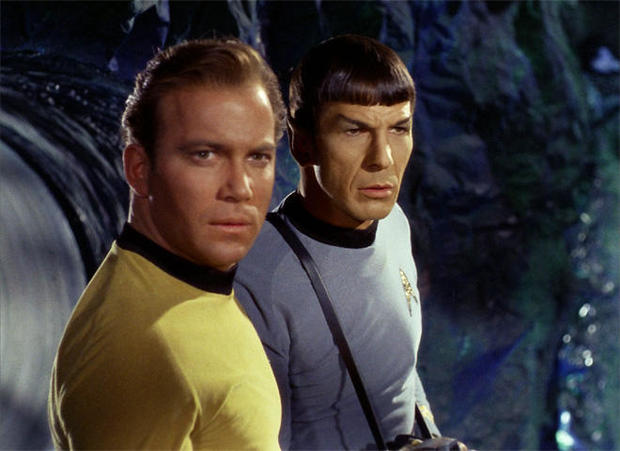
Premiering on September 8, 1966, "Star Trek" was on the air for just three years on NBC, but the series about the crew of the Starship Enterprise, starring William Shatner and Leonard Nimoy, lived long and prospered in syndication, before making the jump to the big screen.
Only 79 episodes were created for the original series, with many gems of sci-fi entertainment (and some, not-so-much).
Click though our gallery to check out - in chronological order - the 20 best "Star Trek" episodes (and the 10 worst).
By CBSNews.com senior producer David Morgan
Watch original "Star Trek" episodes on CBS All Access
New series, "Star Trek" Discovery," debuts on CBS All Access in September 2017

“The Naked Time”
First aired: September 29, 1966
The camaraderie of the Enterprise crew was one of the show’s greatest selling points, and was evident fairly early in its run. But this episode showed when the starship crew was falling apart - blighted by a virus that provokes irrational and highly emotional behavior among those infected, putting the entire ship in jeopardy. Most memorable was Sulu’s turn as a swashbuckling fencer, foiled by a Vulcan nerve pinch.
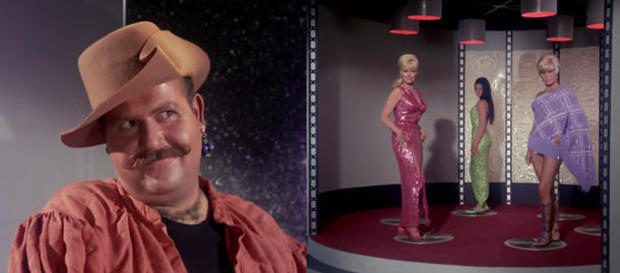
“Mudd’s Women”
First aired: October 13, 1966
A con man, Harcourt Fenton Mudd (Roger C. Carmel), is brought on board the Enterprise along with his human cargo: three voluptuous women who, it turns out, are made staggeringly beautiful thanks to an illegal “Venus drug.” So why are they opting for lives as mail-order brides to settlers on a distant planet? While the plot is not all that great, Mudd, as played by Carmel, is a delight - so much so that he returned in a later episode, on a planet filled with beautiful female robots.
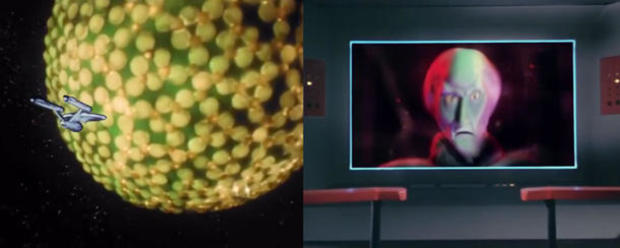
“The Corbomite Maneuver”
First aired: November 10, 1966
In the uncharted regions of space, a good and resourceful ship’s caption must also be good at poker - calling the bluff of your adversary. That is especially important when confronted by a gigantic (and I mean GIGANTIC) spaceship whose captain threatens you with annihilation.
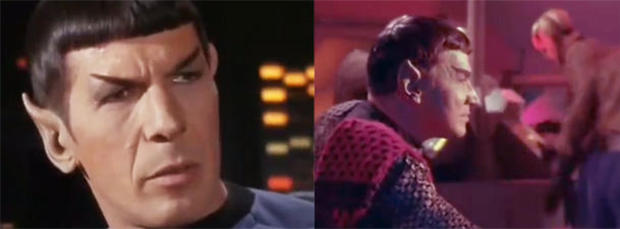
“Balance of Terror”
First aired: December 15, 1966
It was in this episode (inspired by a World War II submarine thriller, “The Enemy Below”) that we learn a bit of Vulcan history, with the Enterprise encountering a Romulan warship. The Romulans have attacked several Federation outposts near the Neutral Zone, but have never been seen, before a transmission is intercepted, revealing that Romulans look just like Vulcans! As crewmembers question the loyalty of First Officer Spock (whose ancestors have blood ties to Romulans), Kirk must play cat-and-mouse with the alien ship (which is hidden by a cloaking device) before it can retreat back into Romulan territory.

“Shore Leave”
First aired: December 29, 1966
Sci-fi author Theodore Sturgeon penned this memorable tale of a planet where people’s thoughts and memories suddenly appear in the flesh. Alice and the White Rabbit? A samurai? A knight on horseback? A World War II fighter plane? When crewmembers on shore leave start dying, Kirk has to get to the bottom of it. The answer? As Spock would say, “fascinating.”

“Tomorrow Is Yesterday”
In “The Naked Time” an experiment involving anti-matter threw the Enterprise back in time, by a matter of days. In this episode, an encounter with a black hole plunges the Enterprise back to 20th century Earth, where it is seen by an Air Force pilot scrambled to track the UFO. Beamed aboard the Enterprise, Captain John Christopher (Roger Perry) is distraught that he can’t be returned (he’s already seen too much). But then the effects of potentially changing future history by his absence have to be weighed - and Kirk finds there is no easy solution.

“The Return of the Archons”
First aired: February 9, 1967
A community on planet Beta III exhibits the characteristics of a hive mind, when the townspeople en masse attack Kirk and crew. They are in thrall to their omniscient leader, Landru, and seek to absorb anyone who is “not of the body.” The climactic reveal became something of a tired fixture in “Star Trek” (in which an all-powerful being is shown to actually be a robot, a computer, or a testy little kid). But a shot of the townspeople collectively stooping to pick up rocks - the better to “greet” their visitors - is chilling.

“Space Seed”
First aired: February 16, 1967
The Enterprise comes across a derelict ship, the SS Botany Bay, which carries the hibernating bodies of dozens of humans from late 20th century Earth. Turns out they are genetically-modified beings responsible for Earth’s Eugenics War. Their leader, Khan Noonien Singh (Ricardo Montalban), is awakened from hibernation, which is a bad idea - he frees his followers and tries to take over the Enterprise.
What was a nifty one-off episode would inspire the best of the “Star Trek” movies, 1982’s “Star Trek II: The Wrath of Khan,” when Khan and his people, living in exile on a desert planet, commandeer a passing ship and hunt down the man responsible for their plight: James T. Kirk!
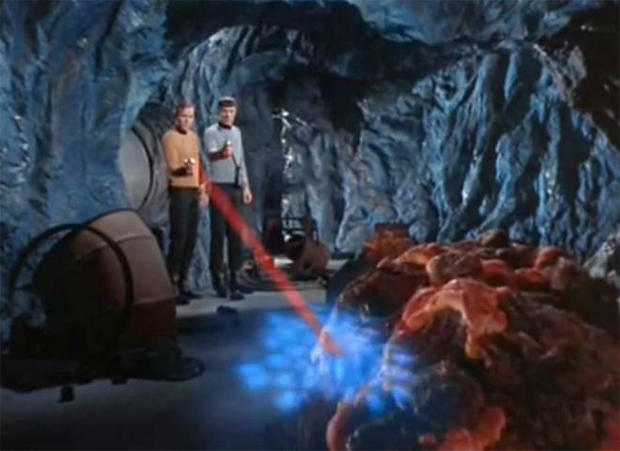
“The Devil in the Dark”
First aired: March 9, 1967
“Star Trek” did not go in much for horror, and used the ugly-alien-monster-that-must-be-killed trope less than other sci-fi series. But this tale of a mining colony where workers are attacked and killed by a mysterious creature was both an engrossing encounter with an unknown threat, and a story of learning to co-exist with other creatures, even those whose appearance may be repellent (and that’s how the alien Horta views humans).

“The City on the Edge of Forever”
First aired: April 6, 1967
The hands-down best episode of “Star Trek” is a riveting tale of time travel and altered history. When McCoy steps through a time portal back to Depression-era Earth, he saves the life of a peace activist in a traffic accident. That good deed unfortunately allows the Nazis to triumph during World War II, altering the course of history, and threatening the very existence of the Enterprise crew. Following McCoy, Kirk realizes that to set things right, the very woman he has fallen for back in the 1930s must die.
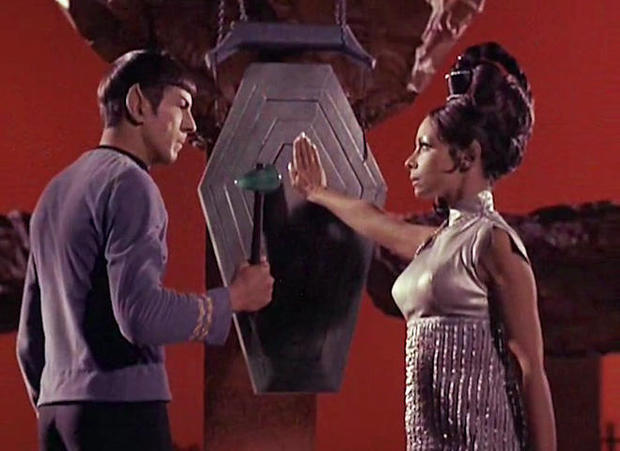
“Amok Time”
First aired: September 15, 1967
Vulcan biology - as in the need to mate every seven years, or die - makes it imperative for Kirk to risk his professional career to get Spock back to his home planet, and to the young bride to whom his first officer had been betrothed. But Vulcan traditions about marriage and procreation are much more complicated, especially when the bride is allowed to choose a champion to fight her intended to the death - a contest that pits Spock against Kirk!
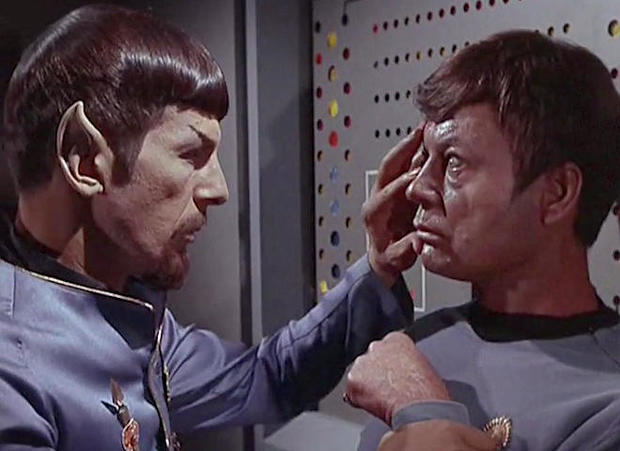
“Mirror, Mirror”
First aired: October 6, 1967
“Evil twins” became a mainstay of TV pop culture, allowing actors to play “bad” versions of their characters. Here, a transporter malfunction sends Kirk, McCoy, Uhuru and Scotty into a parallel universe, but one in which the Federation is an evil empire, with starship crews employing assassination as a form of career advancement. Will Kirk, etc. survive, or will “evil Spock” have the last laugh?

“The Doomsday Machine”
First aired: October 20, 1967
Guest star William Windom gives a terrific performance as Commodore Matt Decker, commander of the USS Constellation, who witnessed his entire crew destroyed by a giant, planet-eating machine. Like Ahab hunting the white whale, Decker commandeers the Enterprise and engages in a suicidal mission to destroy the machine once and for all.
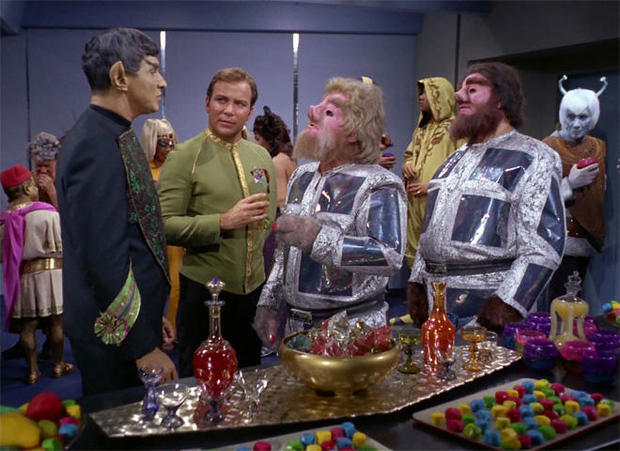
“Journey to Babel”
First aired: November 17, 1967
The difficult family dynamics of Spock - whose father was Vulcan and mother human - are explored in this story featuring Mark Lenard as Sarek, a Vulcan ambassador en route to a diplomatic conference. When an assassin murders one of the traveling dignitaries, the investigation opens the wounds of a father-son relationship, leading to a kind of reconciliation.
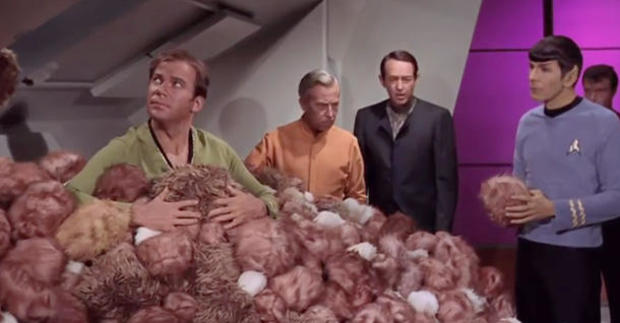
“The Trouble With Tribbles”
First aired: December 29, 1967
A fan favorite, this was the first “Trek” episode played for laughs. An interstellar salesman’s pet tribbles - purring balls of fur that love to multiply - become a real pain for Kirk, who also has to deal with Klingon saboteurs, obnoxious space diplomats, and crew members who brawl in bars.
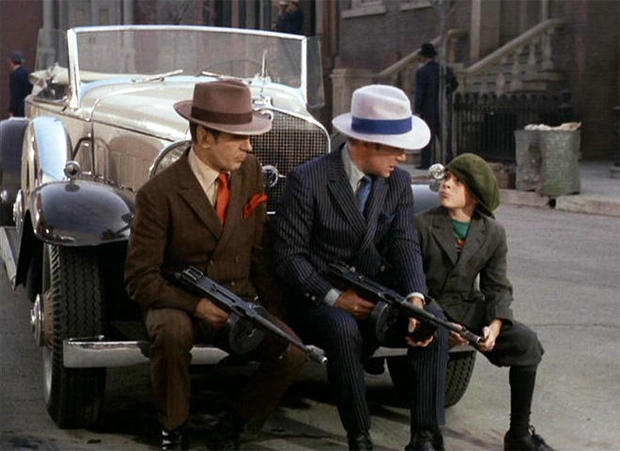
“A Piece of the Action”
First aired: January 12, 1968
Another humorous episode - and it is heartening to know that old gangster movies would be familiar to 23rd century space travelers like Kirk, who spouts the patois of James Cagney. Unlike other developing alien worlds which must be protected from knowledge about the Federation via the Prime Directive (so as not to taint them), the “gangsters” on Sigma Iotia II are fully aware of outside civilizations - they’ve designed their entire culture on a book, “Chicago Mobs of the Twenties,” brought there by an Earth ship 100 years earlier. When Kirk, Spock and McCoy beam down to the planet, they find a mob boss who wants to trade up from Tommy guns to phasers, leaving Kirk to sell the Federation’s protection racket. After all, Sigma Iotia II is a nice planet - you wouldn’t want something to happen to it.
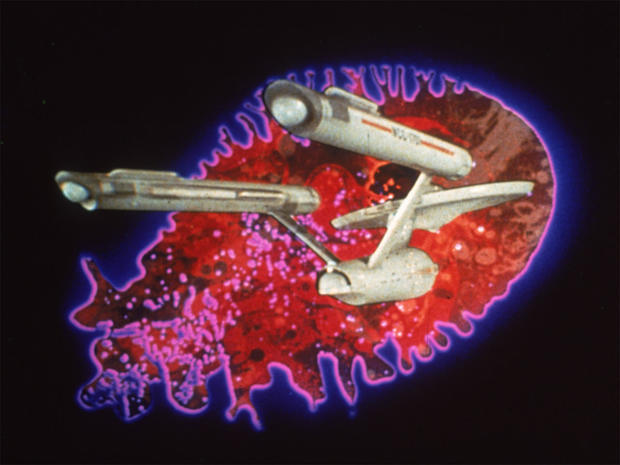
“The Immunity Syndrome”
An entire ship manned by Vulcans is destroyed, creating a psychic blow that hits Spock hard. But he recovers enough to then investigate the cause of that destruction: a giant, single-cell organism that is eating away at space, destroying worlds and threatening the entire galaxy. It was one threat that didn’t have to be reasoned with, tricked, negotiated with, seduced or tackled in a fistfight - just destroyed (if possible).
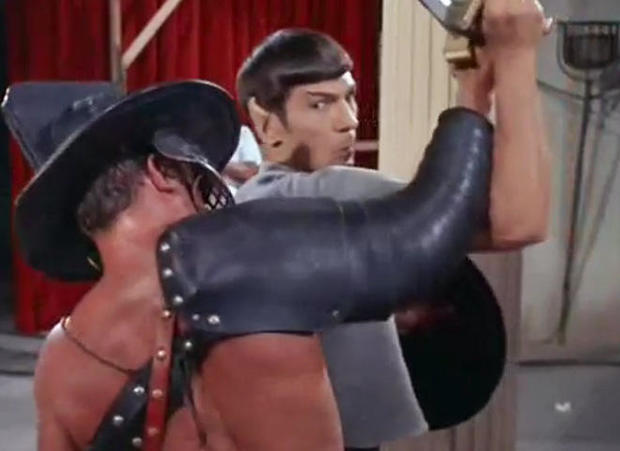
“Bread and Circuses”
First aired: March 15, 1968
What is that member of the crew of the SS Beagle doing in a mysterious TV broadcast, engaged in a deadly gladiatorial fight in a Rome that never fell? Kirk, Spock and McCoy investigate, and find the society on the planet Magna Roma mirroring the glories of ancient Rome, but with the technological advances of 20th century Earth, such as color television. Some clever satire on the fickleness of TV programming, as the Enterprise officers are forced to fight before the cameras, but also a “Twilight Zone”-like twist, when the rebellious Children of the Sun are revealed to worship something other than that star in the sky.
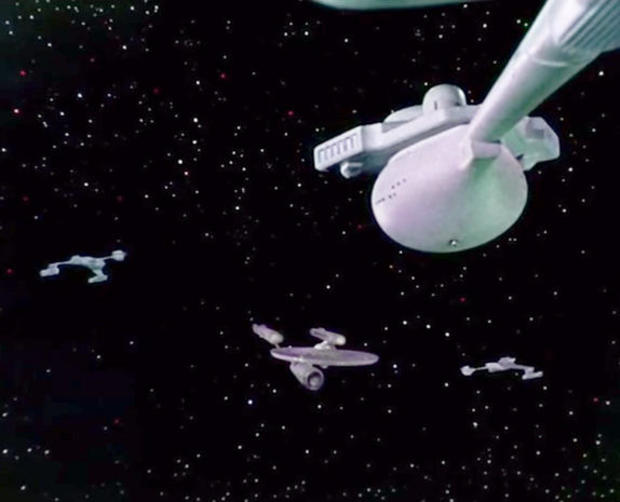
“The Enterprise Incident”
First aired: September 27, 1968
In a deft bit of intergalactic espionage and military brinkmanship, the Enterprise enters the Neutral Zone, only to be surrounded by three Romulan ships. Kirk and Spock are brought before the Romulan commander, whereupon Spock outs Kirk as having intentionally intruded on Romulan space. Or did he?
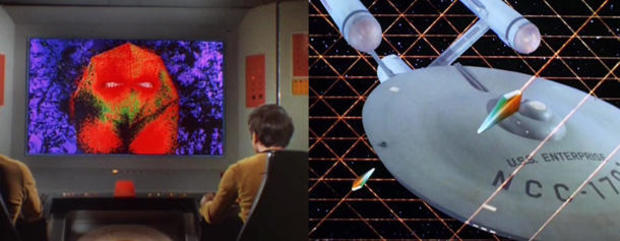
“The Tholian Web”
First aired: November 15, 1968
Engaged in a rescue mission when Captain Kirk is stranded in a space-time rift, Spock must also contend with the Tholians, whose entrance has further distorted the inter-dimensional rift, jeopardizing Kirk and putting the entire crew at risk. The alien not only looks cool; their ships’ energy field - a criss-cross web entrapping the Enterprise - is one of the most memorable visuals in the series.

“Arena”
First aired: January 19, 1967
Fond memories of Kirk’s one-on-one battle with a Gorn, adapted from Fredric Brown’s classic short story, collide with the realization that this episode doesn’t make much sense. Never mind the monotony of their faceoff as the Enterprise crew watches, helpless, to see whether Kirk will be victorious, sparing their lives from the alien referee forcing the two ships’ captains to duke it out, ‘cause he can. Kirk ultimately downs the slow-moving Gorn by mixing mineral deposits he comes across to make gunpowder, conveniently recalling the chemical composition of something which had been out of use for at least 200 years. And when Kirk refuses to kill the Gorn, everyone’s lives are spared, proving humans are more compassionate than the higher life forms that toy with us for their own amusement.
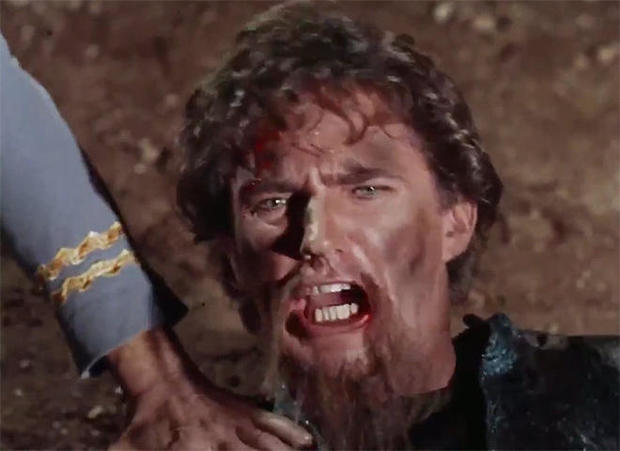
“The Alternative Factor”
First aired: March 30, 1967
The Enterprise picks up a man, named Lazarus, who claims to have pursued his enemy across centuries and into a parallel universe. The “anti-Lazarus,” possibly a form of anti-matter, spells disaster for both universes should the two ever come into contact. A plethora of plot holes and ridiculous dialogue (“He’ll kill us all if you don’t kill him first! Kill! Kill! Kill! Kill! Kill!”) bring this one under.
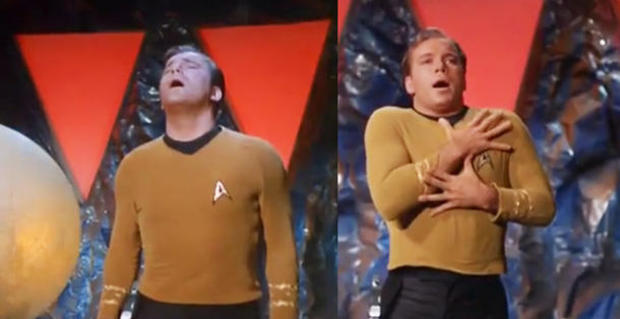
“Return to Tomorrow”
First aired: February 9, 1968
A disembodied consciousness that lives in a sphere within a long-dead planet enters the body of Captain Kirk, and then conscripts the Enterprise’s crew to construct humanoid robots that his fellow intangible beings can inhabit, ‘cause who doesn’t prefer a flesh-and-blood body to a glowing orb?

“Patterns of Force”
First aired: February 16, 1968
One of the lesser “Trek” episodes in which Kirk and Spock explore an alien world that resembles Earth’s past. On the planet Ekos, a Starfleet academic named John Gill has replicated a society mimicking Nazi Germany, on the rich assumption that the nastier elements of Hitler’s Third Reich - genocide, oppression, war-mongering - can be avoided. Tell that to the people of neighboring planet Zeon, whose population is threatened with a “final solution” brought by Gill’s adherents. Oh, and that Prime Directive? Once it’s been broken, apparently Federation crew members are free to up and join a local resistance, interfering just enough to bring down the regime and save Zeon.

“The Omega Glory”
First aired: March 1, 1968
Yes, this aired during the Cold War. And a similar conflict was also taking place light-years away, on the planet Omega IV, where a long-ago parallel Cold War led to the near-annihilation of “Yangs” and “Kohms.” (Yankees and Communists, get it?) Kirk and crew discover remnants of the Yang society carrying Old Glory and honoring faded documents that read exactly like the United States’ Constitution. Because in a universe with potentially millions of habitable planets, why wouldn’t one of them also develop a system of representative democracy that mirrors ours, word for word, right down to the Preamble?

“Assignment: Earth”
First aired: March 29, 1968
Gene Roddenberry’s pilot for a proposed series about an alien secret agent on 1960s Earth wasn’t helped by shoehorning it into the “Star Trek” universe, forcing Kirk and Spock to travel back in time to the ‘60s. There they basically watched helplessly as Gary Seven (Robert Lansing), his ditsy secretary (Teri Garr), and a cat engage in some subterfuge that would - Seven claims - prevent World War III. One rocket explosion later, all is fine, and Seven’s cat is revealed to be a voluptuous woman, making Garr appropriately jealous.
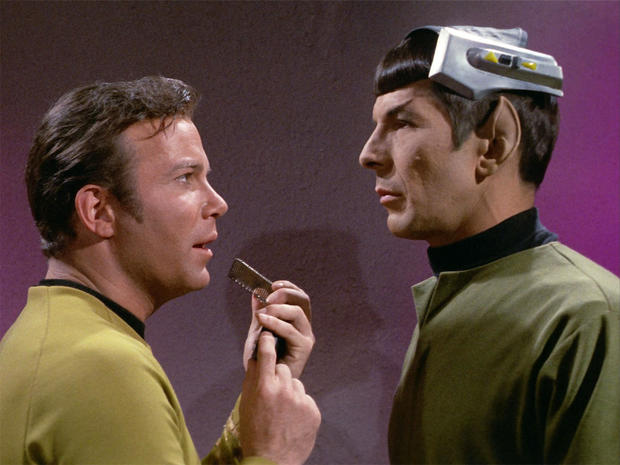
“Spock’s Brain”
First aired: September 20, 1968
“Star Trek” was cancelled after two seasons, but a letter-writing campaign by passionate fans helped persuade NBC to bring it back. The gratification of the cast at having their jobs again must have been met with downcast expressions once they read the script for this third season episode, in which a pretty female alien beams aboard the Enterprise and steals the brain out of Spock’s head. Why? To run her planet’s infrastructure, naturally. After retrieving the errant organ, and with the body of Spock offering guidance, Dr. McCoy performs a “reverse brain transplant,” and all is well. The worst “Trek” episode of all time.

“The Paradise Syndrome”
First aired: October 4, 1968
Yet another “alien planet mimics Earth’s past” episode, this time featuring a civilization which resembles Native American tribes, except for that strange metallic obelisk. Kirk is “kidnapped” by the obelisk, suffering amnesia and waking up as “Kirok,” whose strange space-man ways lead him to be accepted as the tribe’s medicine man. And while he may have forgotten who he is, Kirok is still Kirk, getting a comely native girl pregnant. Meanwhile, an asteroid is about to destroy the entire planet. Will Kirk get his memory back in time to save everyone?
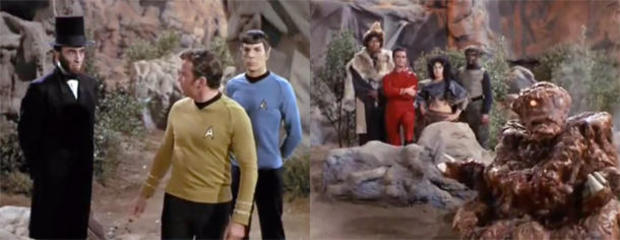
“The Savage Curtain”
First aired: March 7, 1969
“Star Trek” would often tie figures from Earth’s past to characters of the future (one list of history’s failed despots included Alexander, Caesar, Napoleon, Hitler and “Krotus”). “The Savage Curtain” takes this one step further, by bringing to life our greatest president, Abraham Lincoln, and Surak, “the father of Vulcan civilization,” to join Kirk and Spock in a cage match to the death against exemplars of evil: Genghis Khan, 21st century Earth warlord Colonel Green, the Klingon Kahless, and Zora, a woman not to be trusted. The talking rock that officiates the experiment in good vs. evil figures the better philosophy will vanquish their rivals, but ultimately the bad guys just quit and run away. Boooo!
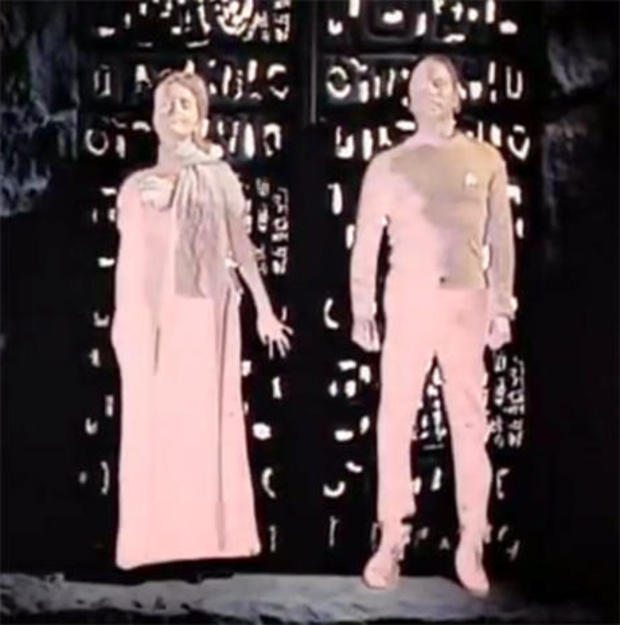
“Turnabout Intruder”
First aired: June 3, 1969
The last new episode of the Original Series, alas, saw the show off on a down note, and a surprisingly anti-feminist one at that. An old flame of Kirk’s, Dr. Janice Lester (Sandra Smith), believing that being a woman has kept her from breaking the glass ceiling of starship command, goes bonkers and decides to steal Kirk’s body and take over the Enterprise. As her mind is transferred to Kirk’s body, his mind enters hers. Fortunately a Vulcan mind meld contradicts the old saw that men can never understand what’s on a woman’s mind, when Spock discovers his captain inside Lester’s head.
The Crew of the Enterprise
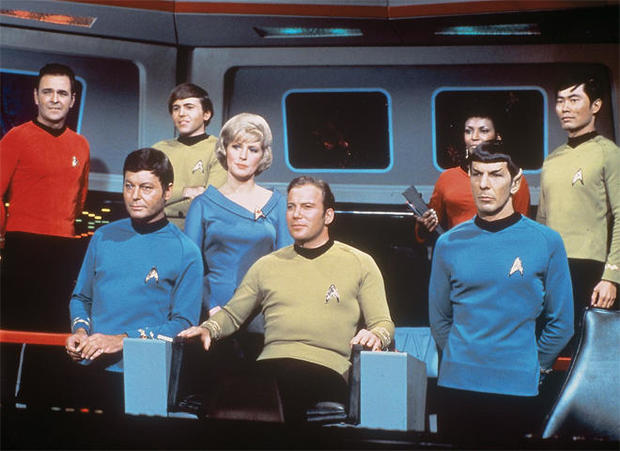
"May the wind be at our backs."
The "Star Trek" franchise marks its 50th anniversary with a new feature film ("Star Trek Beyond") and, in May 2017, a new TV series on CBS All Access, "Star Trek: Discovery."
By CBSNews.com senior producer David Morgan
GALLERY: Evolution of the Starship Enterprise
For more info:
startrek.com
Exhibit: "Starfleet Academy Experience" at New York's Intrepid Sea, Air & Space Museum (through October 31)
Exhibit: "Star Trek: Exploring New Worlds" at the EMP Museum at Seattle Center (through January 31, 2017)
"Star Trek Beyond" (Paramount Pictures)
"Star Trek: Discovery" (CBS)
Watch "Star Trek" original episodes on cbs.com /CBS All Access
Follow @StarTrek on Twitter , Facebook , Instagram and YouTube
David Morgan is a senior editor at CBSNews.com and cbssundaymorning.com.
Den of Geek
The Star Trek: The Original Series Episodes That Best Define the Franchise
Nobody is ever going to be happy with a list of the best The Original Series episode of all time. It’s unfair and illogical to rank Star Trek episodes like this. Sounds like fun!

- Share on Facebook (opens in a new tab)
- Share on Twitter (opens in a new tab)
- Share on Linkedin (opens in a new tab)
- Share on email (opens in a new tab)
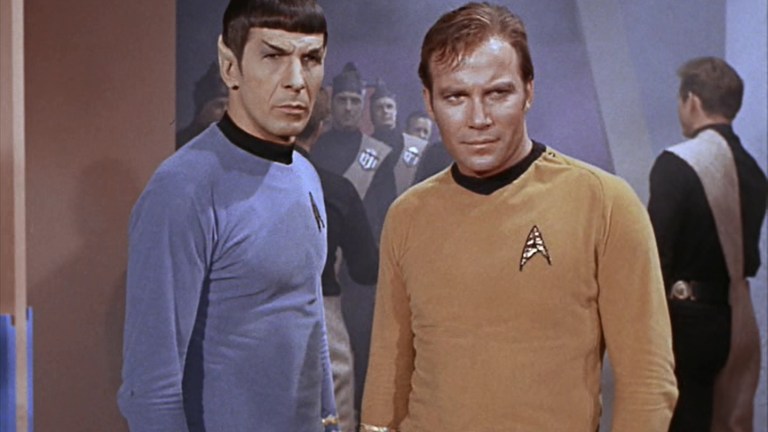
By the time my generation got to watch Star Trek: The Original Series , the episodes often were being presented in top-ten marathons. When I was ten-years-old, for the 25th Anniversary of Star Trek , I tape-recorded a marathon of ten episodes that had all been voted by fans as the best-ever installments of The Original Series . Later, I got lucky and found Trek stickers at the grocery store and was able to label my VHS tapes correctly. But do I think all the episodes that were in that marathon back in 1991 were really the best episodes of all of the classic Star Trek ? The short answer: no. Although I love nearly every episode of the first 79 installments of Star Trek , I do think that certain lists have been created by what we think should be on the list rather than what episodes really best represent the classic show.
This is a long-winded way of saying, no, I didn’t include “Amok Time” or “The Menagerie” on this list because, as great as they are, I don’t think they really represent the greatest hits of the series. Also, if you’ve never watched TOS , I think those two episodes will throw you off cause you’ll assume Spock is always losing his mind or trying to steal the ship. If you’ve never watched TOS , or you feel like rewatching it with fresh eyes, I feel pretty strong that these 10 episodes are not only wonderful, but that they best represent what the entire series is really about. Given this metric, my choice for the best episode of TOS may surprise you…
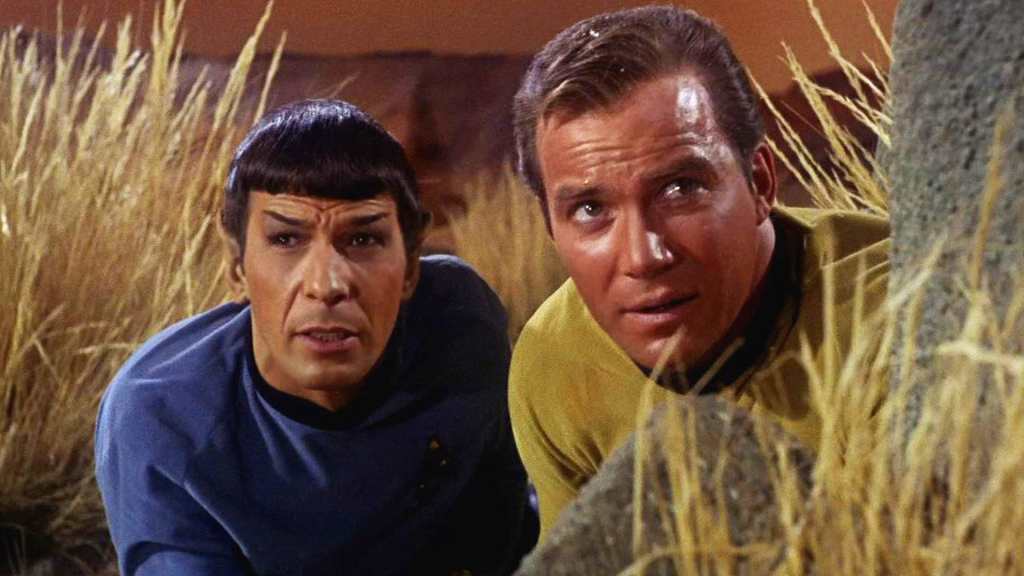
10. “The Man Trap”
The first Star Trek ever episode aired should not be the first episode you watch. And yet, you should watch it at some point. The goofy premise concerns an alien with shaggy dog fur, suckers on its hand, and a face like a terrifying deep-sea fish. This alien is also a salt vampire that uses telepathy that effectively also makes it a shapeshifter. It’s all so specifically bonkers that trying to rip-off this trope would be nuts. Written by science fiction legend George Clayton Johnson (one half of Logan’s Run authorship) “The Man Trap” still slaps, and not because Spock (Leonard Nimoy) tries to slap the alien. Back in the early Season 1 episodes of Star Trek , the “supporting” players like Uhura and Sulu are actually doing stuff in the episode. We all talk about Kirk crying out in pain when the M-113 creature puts those suckers on his face, but the real scene to watch is when Uhura starts speaking Swahili. The casual way Uhura and Sulu are just their lovable selves in this episode is part of why we just can’t quit the classic Star Trek to this day. Plus, the fact that the story is technically centered on Bones gives the episode some gravitas and oomph. You will believe an old country doctor thinks that salt vampire is Nancy! (Spoiler alert: It’s not Nancy.)
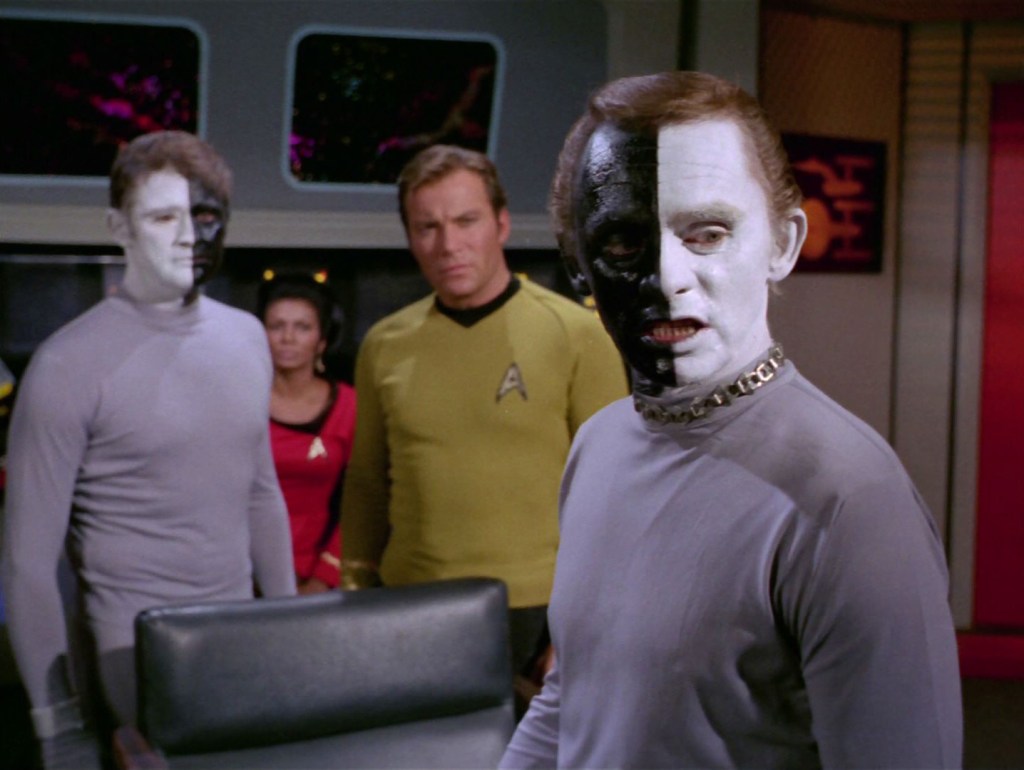
9. “Let that Be Your Last Battlefield”
There are two episodes everyone always likes to bring up when discussing the ways in which Star Trek changed the game for the better in pop culture’s discourse on racism: “Plato’s Stepchildren” and this episode, “Let that Be Your Last Battlefield.” The former episode is famous because Kirk and Uhura kiss, which is sometimes considered the first interracial kiss on an American TV show. (British TV shows had a few of those before Star Trek , though.) But “Plato’s Stepchildren” is not a great episode, and Kirk and Uhura were also manipulated to kiss by telepaths. So, no, I’m not crazy about “Plato’s Stepchildren.” Uhura being forced to kiss a white dude isn’t great.
Ad – content continues below
But “Let that Be Your Last Battlefield,” oddly holds up. Yep. This is the one about space racism where the Riddler from the ‘60s Batman (Frank Gorshin) looks like a black-and-white cookie. Is this episode cheesy? Is it hard to take most of it seriously? Is it weird that Bele (Frank Gorshin) didn’t have a spaceship because the budget was so low at that time? Yes. Is the entire episode dated, and sometimes borderline offensive even though its heart is in the right place? Yes. Does the ending of the episode still work? You bet it does. If you’re going to watch OG Star Trek and skip this episode, you’re kind of missing out on just how charmingly heavy-handed the series could get. “Let that Be Your Last Battlefield” is like a ‘60s after-school special about racism, but they were high while they were writing it.
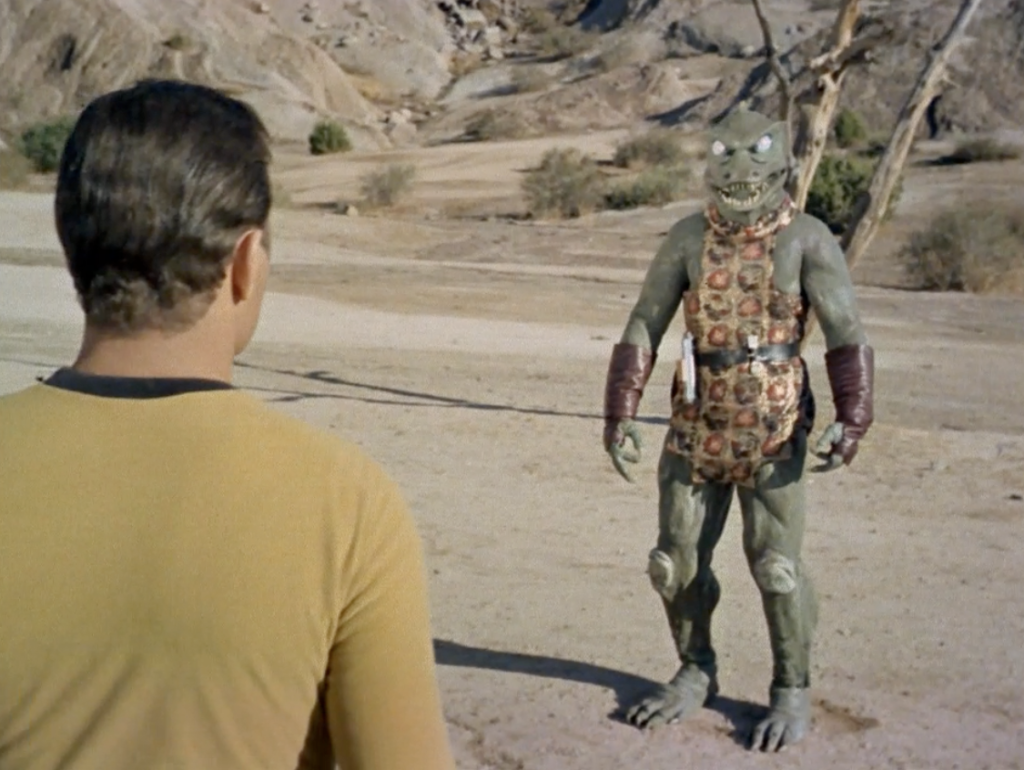
You’re gonna try to list the best episodes of Star Trek: The Original Series and not list the episode where Kirk fights a lizard wearing gold dress-tunic? The most amazing thing about “Arena” is that it’s a Season 1 episode of The Original Series and somehow everyone involved in making TOS had enough restraint not to ever try to use this Gorn costume again. They didn’t throw it away either! This famous rubber lizard was built by Wah Chang and is currently owned by none other than Ben Stiller.
So, here’s the thing about “Arena” that makes it a great episode of Star Trek , or any TV series with a lizard person. Kirk refuses to kill the Gorn even though he could have, and Star Trek refused to put a lizard costume in a bunch of episodes later, even though they totally could have. Gold stars all around.
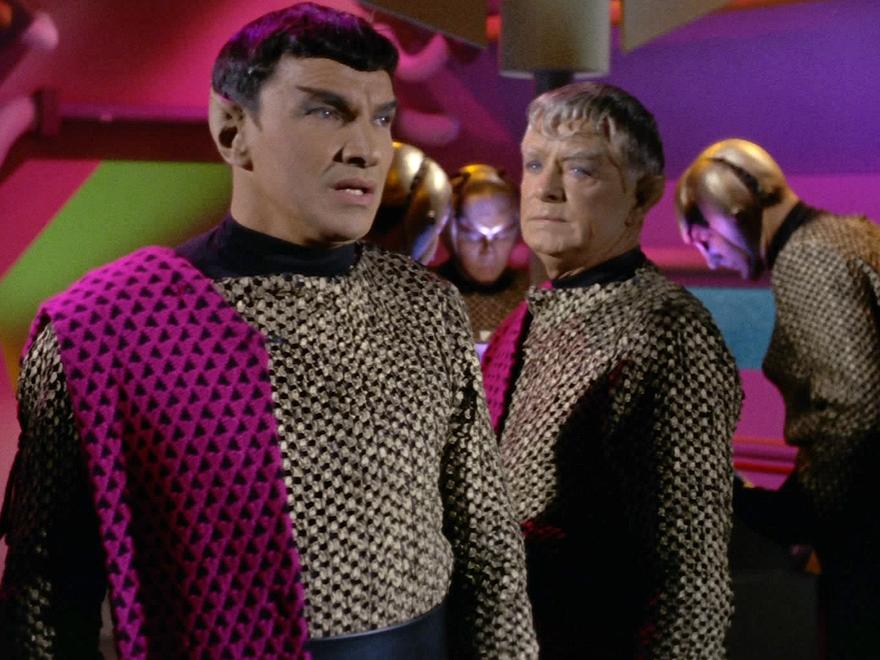
7. “Balance of Terror”
The fact that Star Trek managed to introduce a race of aliens that looked exactly like Spock, and not confuse its viewership is amazing. On top of that, the fact that this detail isn’t exactly the entire focus of the episode is equally impressive. The notion that the Romulans look like Vulcans is a great twist in The Original Series , and decades upon decades of seeing Romulans has probably dulled the novelty ever so slightly. But, the idea that there was a brutally cold and efficient version of the Vulcans flying around in invisible ships blowing shit up is not only cool, but smart.
“Balance of Terror” made the Romulans the best villains of Star Trek because their villainy felt personal. Most Romulan stories in TNG , DS9 , and Picard are pretty damn good and they all start right here.
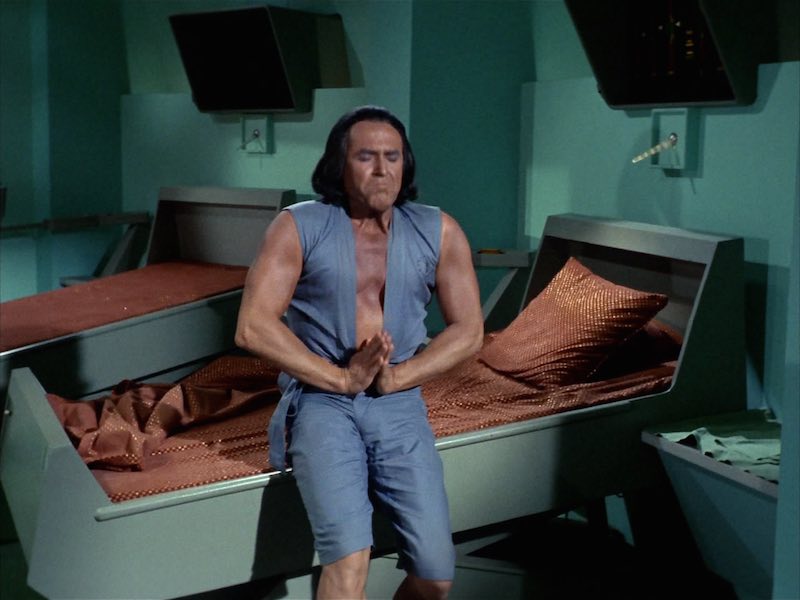
6. “Space Seed”
Khaaaan!!!! Although The Wrath of Khan is infinitely more famous than the episode from which it came, “Space Seed” is one of the best episodes of The Original Series even if it hadn’t been the progenitor of that famous film. In this episode, the worst human villain the Enterprise can encounter doesn’t come from the present, but instead, the past. Even though “Space Seed” isn’t considered a very thoughtful episode and Khan is a straight-up gaslighter, the larger point here is that Khan’s evilness is connected to the fact that he lived on a version of Earth closer to our own.
The episode’s coda is also amazing and speaks of just how interesting Captain Kirk really is. After Khan beat the shit out of him and tried to suffocate the entire Enterprise crew, Kirk’s like “Yeah, this guy just needs a long camping trip.”
Get the best of Den of Geek delivered right to your inbox!
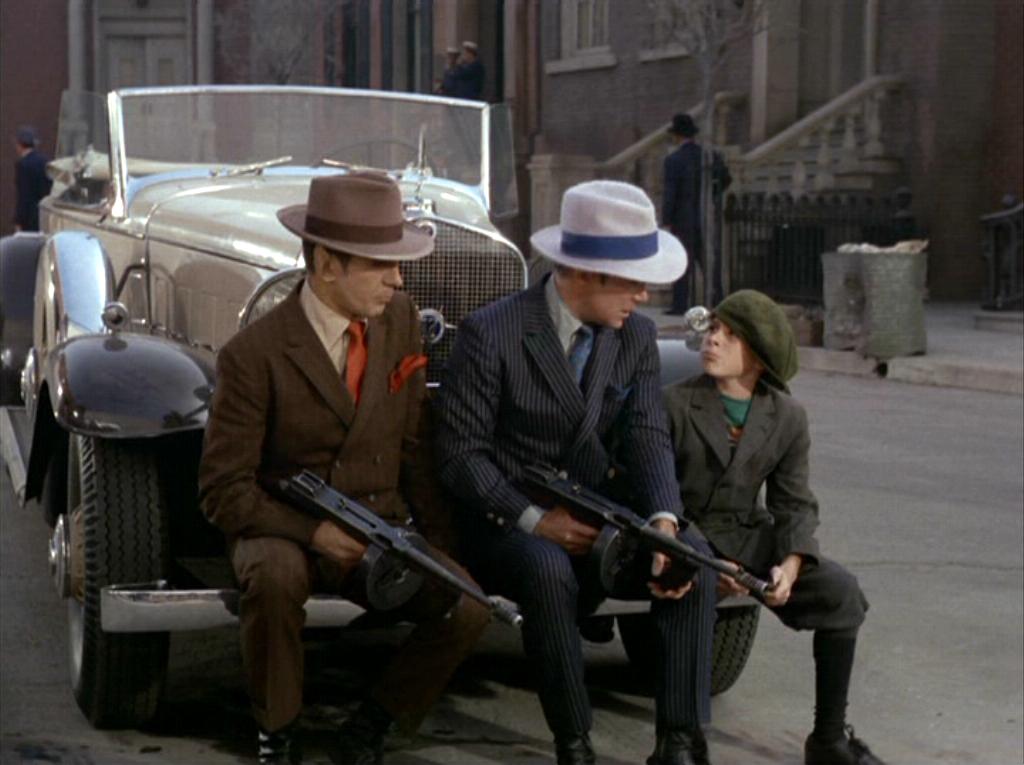
5. “A Piece of the Action”
A few years back, Saturday Night Live did a Star Trek sketch in which it was revealed that Spock had a relative named “Spocko.” This sketch was tragically unfunny because TOS had already made the “Spocko” joke a million times better in “A Piece of the Action.” When you describe the premise of this episode to someone who has never seen it or even heard of it, it sounds like you’re making it up. Kirk, Spock, and Bones are tasked with cleaning-up a planet full of old-timey mobsters who use phrases like “put the bag on you.” Not only is the episode hilarious, but it also demonstrates the range of what Star Trek can do as an emerging type of pop-art. In “A Piece of the Action,” Star Trek begins asking questions about genres that nobody ever dreamed of before. Such as, “what if we did an old-timey gangster movie, but there’s a spaceship involved?”
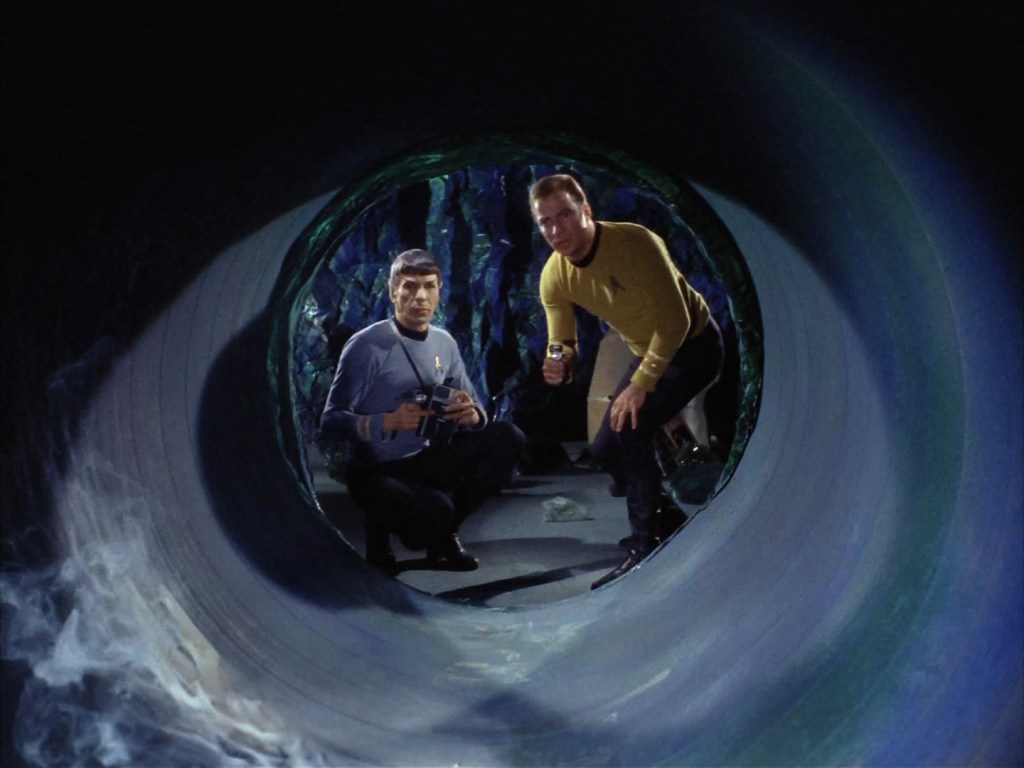
4. “Devil in the Dark”
When I was a kid, my sister and I called this episode, “the one with giant pizza.” Today, it’s one of those episodes of Star Trek that people tell you defines the entire franchise. They’re not wrong, particularly because we’re just talking about The Original Series . The legacy of this episode is beyond brilliant and set-up a wonderful tradition within the rest of the franchise; a monster story is almost never a monster story
The ending of this episode is so good, and Leonard Nimoy and Shatner play the final scenes so well that I’m actually not sure it’s cool to reveal what the big twist is. If you somehow don’t know, I’ll just say this. You can’t imagine Chris Pratt’s friendly Velicrapotrs, or Ripper on Discovery without the Horta getting their first.
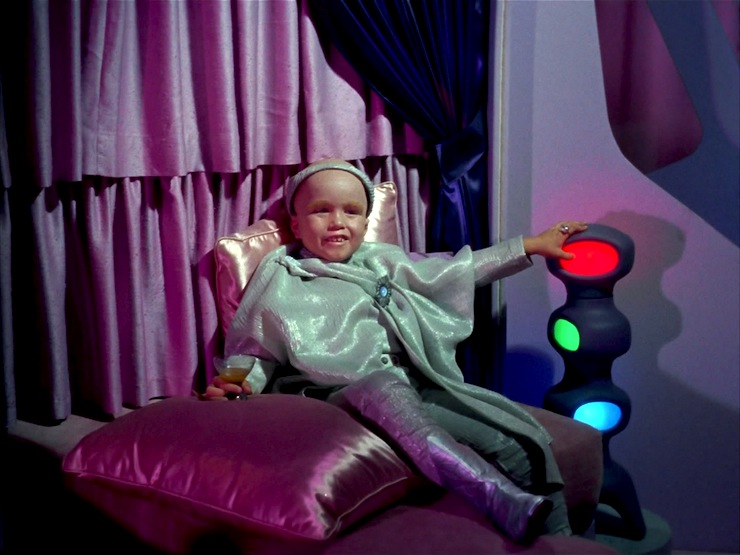
3. “The Corbomite Maneuver”
If there’s one episode on this list that truly represents what Star Trek is usually all about on a plot level, it’s this one. After the first two pilot episodes —“Where No Man Has Gone Before” and “The Cage”—this was the first regular episode filmed. It’s the first episode with Uhura and, in almost every single way, a great way to actually explain who all these characters are and what the hell they’re doing. The episode begins with Spock saying something is “fascinating” and then, after the opening credits, calling Kirk, who is down in sickbay with his shirt off. Bones gives Kirk shit about not having done his physical in a while, and Kirk wanders through the halls of the episode without his shirt, just kind of holding his boots.
That’s just the first like 5 minutes. It just gets better and better from there. Like a good bottle of tranya, this episode only improves with time. And if you think it’s cheesy and the big reveal bizarre, then I’m going to say, you’re not going to like the rest of Star Trek .
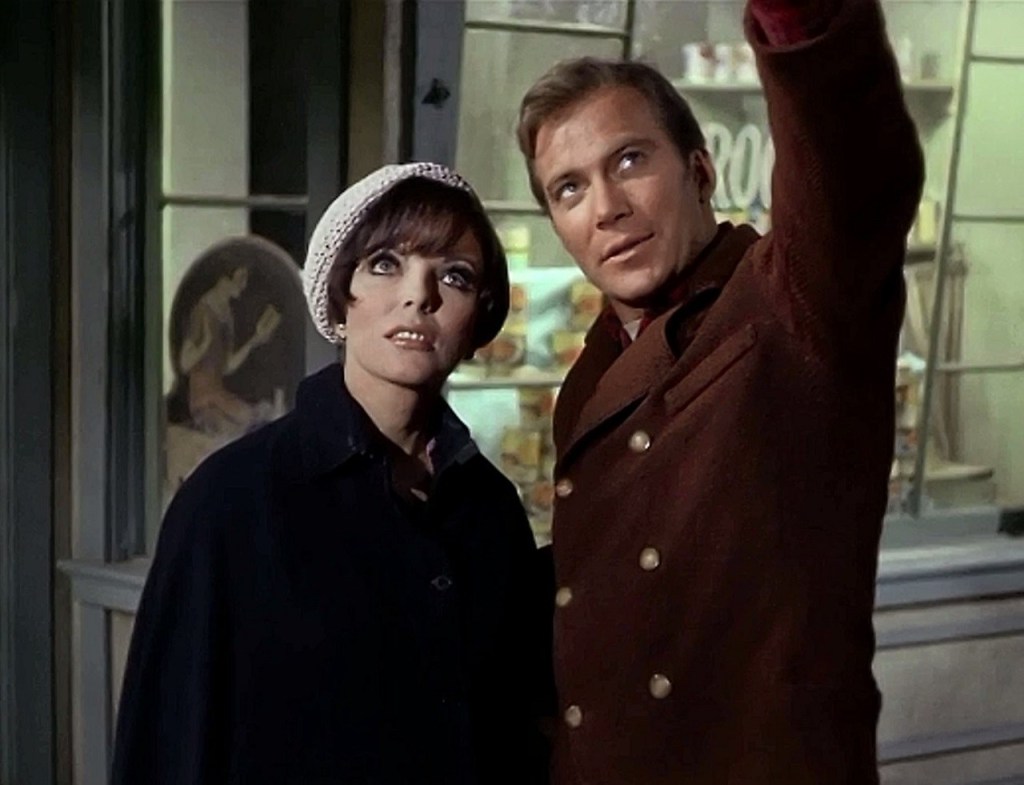
2. “The City on the Edge of Forever”
No more blah blah blah! Sorry, wrong episode. Still, you’ve heard about “The City on the Edge of Forever.” You’ve heard it’s a great time travel episode. You’ve heard Harlan Ellison was pissed about how the script turned out. You heard that Ron Moore really wanted to bring back Edith Keeler for Star Trek Generations . (Okay, maybe you haven’t heard that, but he did.)
Everything you’ve heard about this episode is correct. There’s some stuff that will make any sensible person roll their eyes today, but the overall feeling of this episode is unparalleled. Time travel stories are always popular, but Star Trek has never really done a time travel story this good ever again. The edge of forever will always be just out of reach.
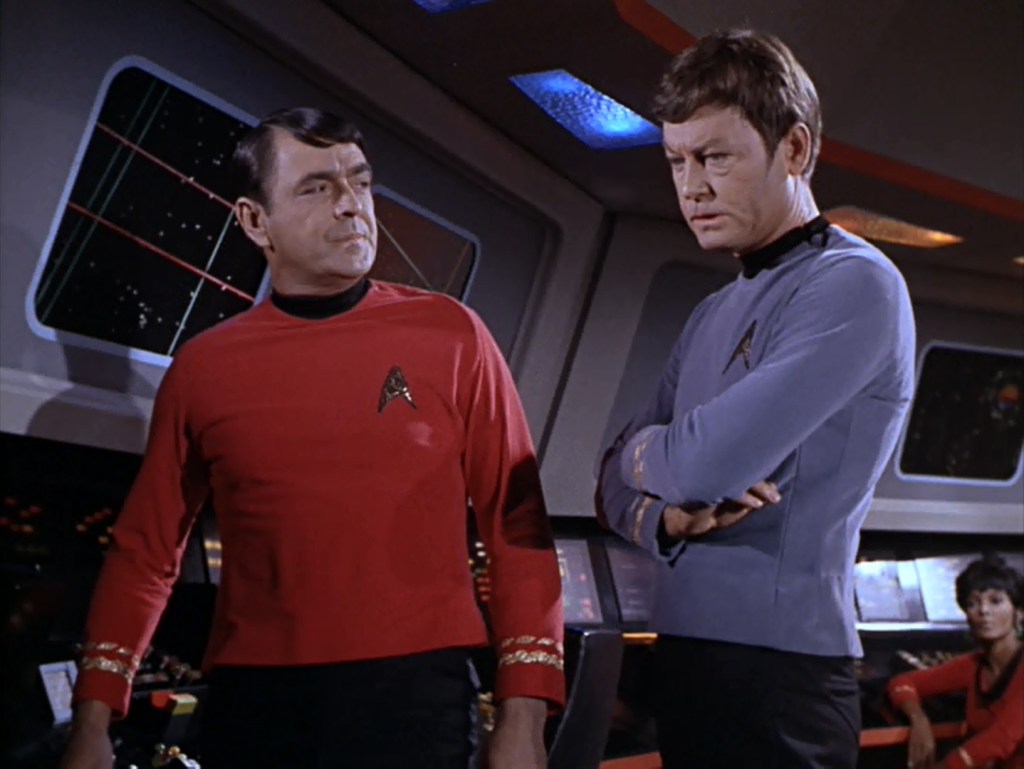
1. “A Taste of Armageddon”
Plot twist! This excellent episode of TOS almost never makes it on top ten lists. Until now! If you blink, “A Taste of Armageddon” could resemble at least a dozen other episodes of TOS . Kirk and Spock are trapped without their communicators. The crew has to overpower some guards to get to some central computer hub and blow it up. Scotty is in command with Kirk on the surface and is just kind of scowling the whole time. Kirk is giving big speeches about how humanity is great because it’s so deeply flawed.
What makes this episode fantastic is that all of these elements come together thanks to a simplistic science fiction premise: What if a society eliminated violence but retained murder? What if hatred was still encouraged, but war was automated? Star Trek’s best moments were often direct allegories about things that were actually happening, but what makes “A Taste of Armageddon” so great is that this metaphor reached for something that could happen. Kirk’s solution to this problem is a non-solution, which makes the episode even better. At its best classic Star Trek wasn’t just presenting a social problem and then telling us how to fix it. Sometimes it was saying something more interesting — what if the problem gets even harder? What do we do then?
The humor and bombast of “A Taste of Armageddon” is part of the answer to that unspoken question, but there’s also a clever lesson about making smaller philosophical decisions. In Star Wars , people are always trying to rid themselves of the dark side of the Force. In Star Trek , Kirk just teaches us to say, “Hey I won’t be a terrible person, today ” and then just see how many days we can go in a row being like that.
What do you think are the most franchise-defining episodes of Star Trek: The Original Series? Let us know in the comments below.

Ryan Britt is a longtime contributor to Den of Geek! He is also the author of three non-fiction books: the Star Trek pop history book PHASERS…
The Best Episodes Of Star Trek: The Original Series
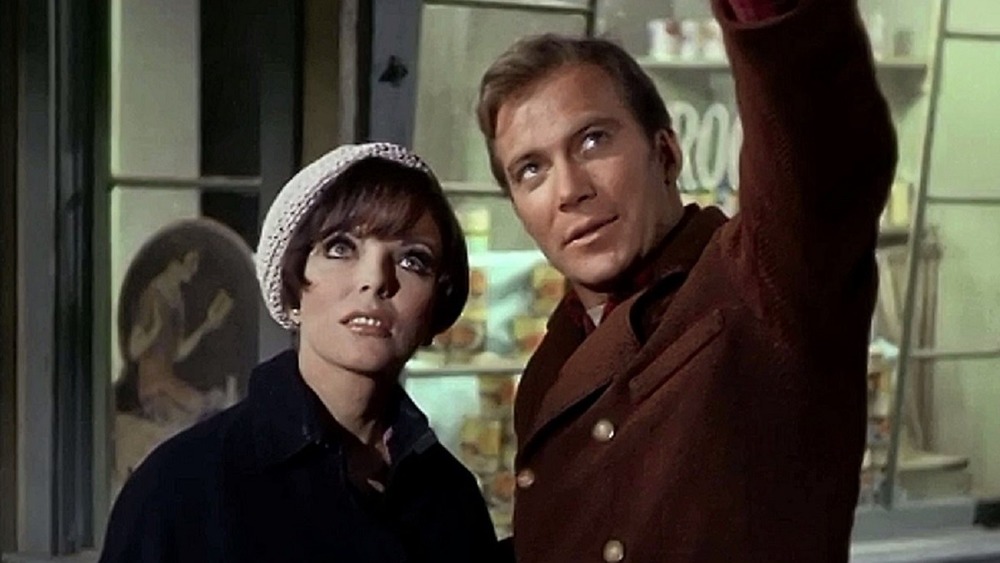
In 1966, an entire new pop culture universe was born, as Star Trek (known nowadays as Star Trek: The Original Series ) debuted on NBC and began its three-season run. While the show's initial life was relatively brief, it found new generations of fans in syndication after being canceled, and over the ensuing decades, it spawned nine (and counting) additional series, 13 theatrical movies , and countless books, comics, magazines, toys, and video games.
At the time it first aired, Star Trek: The Original Series ( TOS ) was an anomaly on American television — an intelligent science fiction series with regular characters that explored scientific concepts and political or social issues. Captain Kirk (William Shatner), Mr. Spock (Leonard Nimoy), Dr. McCoy (DeForest Kelley), and the crew of the Enterprise encountered, as the show's opening narration put it, "new life and new civilizations" every week. When creator Gene Roddenberry's show was at its best, the aliens or situations our heroes came across challenged their own morals or ethics — and by extension, our own — and gave Star Trek a thematic richness that's still relevant today.
But Star Trek: TOS was also an entertaining series full of action, suspense, and humor, complete with a terrific cast. The best episodes of the show combined all that and more, and while everyone may have their own personal favorites, here's our list of some of the greatest episodes the show had to offer.
The Tholian Web is a bright spot in Star Trek's third season
Star Trek 's third and final season was marked by intensive creative upheavals behind the scenes — not to mention drastic budget cuts from NBC — that dramatically impacted the production of the series and contributed to the third season easily being the show's worst .
But season 3 did yield up some exceptional segments, such as "The Tholian Web." In this episode, the Enterprise investigates why the entire crew of the sister ship Defiant has seemingly gone mad and killed each other while the vessel itself appears to be literally dissolving. Kirk is trapped aboard the Defiant as it vanishes into an interdimensional tear in space, with the anomaly beginning to affect the minds of the Enterprise crew, as well. Add some very hostile aliens, and it's a packed episode.
This one works because of the truly alien nature of the Tholians (they're not just the usual human actors with some extra hair or prosthetics on their heads), as well as the tension between Spock and McCoy as they deal with the seeming loss of Kirk and saving the ship. The third season had few bright spots, but this was one of them, and it's an outstanding entry overall.
Charlie X has a truly tragic ending
Just the second Star Trek episode ever aired, "Charlie X" is essentially a character study. Charlie Evans (Robert Walker Jr. in one of the show's standout guest shots) is a 17-year-old orphan who's been stranded, alone, on the planet Thasus since his parents' ship crashed there when he was three years old. After he's rescued and transported to the Enterprise , it quickly becomes apparent that Charlie has incredible powers to manipulate matter. It turns out that the inhabitants of Thasus gave him the powers to survive, but his own immaturity makes it impossible for him to return to his own kind. His ultimate fate is both terrible and moving.
Star Trek would return often to the concept of a child or a childlike entity wielding god-like powers (see "The Squire of Gothos" or "And the Children Shall Lead"). But "Charlie X," scripted by story editor Dorothy "D.C." Fontana — who went on to write several of the show's finest episodes — did it first and did it best. The difference is that unlike Trelane from "The Squire of Gothos," who relishes his powers and sees other creatures as playthings, Charlie just wants to live among his own people and find love and friendship like anyone else. The fact that he can't — and must be condemned to a lonely existence — makes for one of the original series' more poignant and bleak endings.
Shore Leave is a weirdly wonderful Star Trek episode
One of Roddenberry's most inspired ideas on Star Trek was bringing in established sci-fi writers to pen scripts for the show, with the legendary Theodore Sturgeon writing two of its very best episodes. "Shore Leave" was the first, in which the crew of the Enterprise comes upon an idyllic, seemingly empty planet and decides to stop there for a little rest and recreation. But they soon discover that the planet seems to generate whatever each person is thinking about at the moment, whether it be amusing, dangerous ... or even fatal.
The 15th episode aired during the first season, Shore Leave benefited from its location shooting (that first year, it took a while to get the crew off the ship due to budget constraints), its wildly surreal premise, and its plentiful character moments. We get to see Dr. McCoy turn on the Southern charm with a comely female crew member, and Kirk gets to be both a lover and a fighter with figures out of his past — although it's tough to determine which he enjoys more. A bracing mix of humor, suspense and sci-fi weirdness , "Shore Leave" flies by like a breezy vacation getaway.
The Corbomite Maneuver is an awe-inspiring sci-fi showdown
The first episode of TOS filmed in regular production and the tenth aired, "The Corbomite Maneuver" follows the Enterprise into a confrontation with an immensely powerful alien vessel commanded by a species previously unknown to humankind. The ensuing duel of wits between Captains Kirk and the antagonistic Balok becomes a test of Kirk's nerves and personality — one that ultimately leads to enlightenment and understanding.
Like many early, shipbound episodes, " The Corbomite Maneuver " (scripted by sci-fi writer Jerry Sohl) relies heavily on the interactions between members of the crew. The most fascinating of these is Kirk's relationship with the hot-headed young navigator, Bailey (guest star Anthony Call), whom Kirk perhaps sees as a less-seasoned version of himself and is tougher on him for it. That aside, the show's unusual alien (played by Clint Howard, younger brother of Ron Howard ) and its awe-inspiring sci-fi elements make this one of the series' best illustrations of its mission statement, "to boldly go where no man has gone before."
The Devil in the Dark teaches a lesson in tolerance
A stone-cold classic written by producer Gene L. Coon (probably the most important behind-the-scenes figure in TOS history after Roddenberry), "The Devil in the Dark" takes place at a mining colony where the workers are getting slaughtered relentlessly by a mysterious creature lurking in the planet's miles of labyrinthine tunnels and caves. Kirk and the Enterprise are called in to investigate, but the captain and Mr. Spock soon learn that the rampaging monster is not at all what it appears to be.
While somewhat infamous for its monster costume (stuntman and creature maker Janos Prohaska in what looks like a giant rubber scab), "The Devil in the Dark" not only manages to sell the creature through Prohaska's movements and well-executed sound effects, but it tells a profoundly meaningful story about fear of the unknown, compassion, and the need for tolerance. In other words, it's a model Star Trek episode in many ways. Spock's mind-meld with the alien Horta is one of Leonard Nimoy's best moments, Shatner is restrained and sensitive, and McCoy gets to roll out his signature "I'm a doctor, not a (fill in the blank)" line for the first time.
The Menagerie is an award-winning two-parter
The only two-part episode of The Original Series , "The Menagerie," has an interesting history. When Gene Roddenberry first pitched Star Trek to NBC, the network commissioned a pilot. That pilot was "The Cage," which featured an almost entirely different cast (except for Leonard Nimoy as Spock and Majel Barrett — later to play Nurse Chapel — as the ship's executive officer). The story involved the ship's captain, Christopher Pike (Jeffrey Hunter), being captured by an alien race with immense telepathic powers but little physical mobility, who wanted to mate Pike with a captured woman and create a race of slaves.
NBC passed on "The Cage," but the network was interested enough in Star Trek to request a second pilot with some cast changes (that show was "Where No Man Has Gone Before," which introduced William Shatner as Captain Kirk). Meanwhile, to help resolve a production logjam , Roddenberry wrote a shell story around the unused "The Cage," in which Spock hijacks the Enterprise to return a now-crippled and disfigured Pike back to the aliens, for reasons known only to him. Most of the footage from "The Cage" was used as flashbacks to show what happened to Pike on his first trip to the aliens' home of Talos IV.
The result was a clever, frequently brilliant melding of Star Trek 's "present" and early history, all in service of a story about mercy, loyalty, and the power of perception. Roddenberry won a Hugo Award — science fiction's highest honor — for his script, and deservedly so.
Arena is a thrilling Star Trek episode, even with that cheesy Gorn suit
In "Arena," the Enterprise gets into a deadly chase with a spacecraft belonging to the Gorn, a savage, reptilian race who've apparently destroyed a Federation outpost and its occupants with no provocation. But as the two ships enter unexplored space, both are captured by an even more powerful race calling themselves the Metrons. They transport Kirk and the Gorn captain to a planetoid where they must fight out their differences to the death — with the survival of their ships hanging in the balance.
"Arena" was written by Gene L. Coon but was so similar to a short story of the same name by science fiction writer Fredric Brown that the show — to be on the safe side — called Brown and offered him both a fee and story credit on the episode. Whatever its source, "Arena" is a thrilling, action-packed episode from start to finish, with plenty to say about how simple misunderstandings can lead to deadly conflict and unforeseen consequences. Sure, the Gorn costume looks kind of cheesy these days , but the episode was good enough to get past that.
Amok Time is one of Spock's best episodes
"How do Vulcans choose their mates? Haven't you wondered?" a traumatized Spock asks Captain Kirk in the season 2 premiere of TOS . Written by Theodore Sturgeon, "Amok Time" answers that question. With their devotion to logic suppressing all emotions, the Vulcans must nevertheless undergo the "pon farr" every seven years and return home to take a mate. If they don't, the "blood fever" will drive them to madness and even death.
Such is the dilemma facing Kirk, who must decide whether to disobey a direct order from Starfleet to attend a diplomatic event or possibly let his friend and first officer perish due to extreme horniness. That may sound a little flippant, but the stakes are real, and they get even graver when Kirk beams down as best man, only to find out that his role in Spock's wedding isn't exactly what he planned for.
"Amok Time" is a fascinating (to use Spock's favorite word) exploration of Spock and his culture. Plus, it has Kirk and Spock locked in hand-to-hand combat during its final act, and it also features the first use of the Vulcan hand salute and the greeting "live long and prosper." Some of Star Trek 's greatest stories focused on the Enterprise 's resident science nerd, and the combination of its intriguing storyline and Leonard Nimoy's fantastic performance make this a must-see.
Mirror, Mirror introduced a wickedly fun universe to Star Trek
The concept of a parallel or "mirror" universe is a well-worn sci-fi staple, but Star Trek brought it to network television in 1967 with this classic second 2 yarn. Penned by Jerome Bixby (who wrote several more Trek entries, plus the story that inspired the movie Fantastic Voyage ), "Mirror, Mirror" uses an ion storm to beam Kirk, McCoy, Scotty (James Doohan), and Uhura (Nichelle Nichols) into an alternate dimension where there's a Terran Empire instead of a Federation, and the Enterprise is part of a militaristic fleet that ruthlessly conquers and dominates entire planets.
In other words, it's the exact opposite of the ideals they espouse in "our" universe, and while our quartet's main objective is to get home, Kirk at least tries to convince the bearded and dangerous but still logical "mirror" Spock that the Empire is doomed to failure. In addition to its anti-imperial warning, "Mirror, Mirror" gives a lot of the cast the chance to act deliciously evil, and the mirror universe later reared its brutal head again in Star Trek: Deep Space Nine , Star Trek: Enterprise , and most recently, Star Trek: Discovery .
Journey to Babel brings in the family drama
Star Trek story editor and top-shelf writer D.C. Fontana knocked it out of the park with this heart-wrenching, gripping story that introduced Mr. Spock's parents — his Vulcan father, Sarek (Mark Lenard), and his human mother, Amanda (Jane Wyatt).
Sarek is one of many ambassadors being ferried by the Enterprise to a conference deciding the status of the planet Babel. But soon, murder and terror stalk the Enterprise corridors. An unknown vessel shadows the starship, and an attempt is even made to kill Kirk, forcing Spock to take command while his father lies dying from a heart attack ... with Spock being the only one who can provide the blood necessary for Dr. McCoy to save his dad's life.
Despite all the political intrigue, the heart of the episode is the relationship between Spock and his parents. Estranged from Sarek and emotionally cut off from Amanda, Spock's loneliness never feels more acute, and the episode features some of Nimoy's all-time best work as Spock. This is a complex, thrilling entry and another intriguing look into the character and back story of everyone's favorite Vulcan.
Balance of Terror is a tense game of cat and mouse
Before he was Spock's father in season 2's "Journey to Babel," actor Mark Lenard portrayed another important role in season 1 — the commander of a Romulan warship who plays a deadly game of cat and mouse with the Enterprise in "Balance of Terror." The episode marked the first appearance of the belligerent, tyrannical Romulans , and it's a suspense-laden adventure where one wrong move by either commander could mean the destruction of his ship or all-out war.
What adds to the excellence of the episode are the multiple subplots simmering under the main story. The episode opens with Kirk presiding over the marriage of two crew members, a scene echoed at the end with a much more tragic scenario. There's also the bigotry of the angry navigator Stiles (Paul Comi), who suspects Spock is a spy after it's revealed that the Romulans and Vulcans may be distant relatives. And then there's the growing respect and even admiration between Kirk and the Romulan commander, even if they only meet briefly at the show's conclusion.
This is Trek at its spectacular best, and it's worth noting that in addition to playing a Vulcan and a Romulan, Mark Lenard also played a Klingon in Star Trek: The Motion Picture .
If you like suspense, check out The Doomsday Machine
Filled with tension from start to finish and bolstered by a tremendous score from composer Sol Kaplan (one of the few times that a complete score was written for a specific episode), "The Doomsday Machine" works as both a sci-fi retelling of Moby Dick and a warning against the dangers of weapons of mass destruction.
The Enterprise investigates the fate of sister ship Constellation and learns that it was attacked by a giant robot from a distant galaxy that smashes planets to pieces and consumes the debris for fuel. Its only survivor is its captain, Commodore Matt Decker (William Windom), who beams aboard the Enterprise but soon takes command — despite his shocked mental state — as the planet killer reappears and Kirk is stranded aboard the Constellation .
Sci-fi writer Norman Spinrad's script effectively drives up the stakes — the massive machine is headed for the most densely populated part of our galaxy — even as the conflict between Kirk, Spock and the obsessed Decker threatens to send them all down the berserker 's throat. The desperate finale is as suspenseful as they come, capping off one of the most intense Star Trek episodes ever made.
The City on the Edge of Forever is Star Trek: The Original Series' finest episode
This award-winning episode, written by legendary sci-fi author Harlan Ellison (with an assist from several show staffers ), is still largely and deservedly considered the gold standard of Star Trek episodes. After Dr. McCoy, driven mad by an accidental overdose of medication, jumps through a time portal and somehow changes history, Kirk and Spock travel through the same gateway to find him and repair the damage. They end up in Depression-era New York City, where Kirk falls deeply in love with a saintly woman named Edith Keeler (Joan Collins), only to learn the event that McCoy prevented, changing all of history, is Edith's death.
Ellison's story spans all of time and space and is suffused with a haunting, melancholy quality that few other Trek episodes have ever quite matched. Shatner gives one of his best performances as the Enterprise captain, effectively delivering both Kirk's dawning horror at the decision he must make and his shattering grief at the show's bleak conclusion. This is both top-notch science fiction and a heart-rending meditation on love, loss, and destiny, as well as the theme — later repeated in Star Trek II: The Wrath of Khan — that the "needs of the many outweigh the needs of the few." It's a poignant message given an absorbing, unforgettable presentation in what remains Star Trek 's finest hour.

The 10 Best ‘Star Trek’ Original Series Episodes
Star Trek Beyond is the first of the new Trek films that embodies the classic series ‘ adventurous spirit and hopeful tone. Seeing as how 2016 is the 50th anniversary of the USS Enterprise and its faithful crew, it seems fitting to take a look back at the series that started it all. Here are the ten best episodes of Star Trek , as chosen by a Trek nerd who will endanger his own life by saying that Star Trek is better than Star Wars .
“The Enemy Within” (season 1, episode 6)
Though the premise of this episode is a little goofy – a transporter accident splits Captain Kirk into two different beings – it’s in service of a strong character study about the man who runs the Federation ‘s flagship. One Kirk is rash and impulsive while the other is so docile that he lacks the ability to lead. What starts as a simplistic Good Kirk vs Bad Kirk story ends up being much more complex than simple morality. It’s a jaunty and surprisingly poignant way to introduce yourself to James T. Kirk.
“The Corbomite Maneuver” (season 1, episode 11)
Sure, this episode is infamous for Clint Howard ‘s offer of Tranya , but it’s also a great showcase for Kirk’s tactical mind. The titular maneuver is a sly bit of cunning on Kirk’s part that shows he’s not someone you’d want to play poker with. The episode is also a great example of how such a limited show could craft tension out of a few hokey sets and a fantastic cast.
“Balance of Terror” (season 1, episode 15)
Possibly the greatest episode in the entire history of the franchise, this introduction to the Romulans serves as a submarine battle in space. Not only is the suspense masterfully executed, but the real punch comes from humanizing the enemy at every turn. The Romulan commander ‘s final line to Kirk (“In another reality, I could have called you friend.”) is a sharp reminder that warriors are neither good nor evil. They are just men on a mission, fighting for whatever they believe is the right thing to do.
“The Devil in the Dark” (season 1, episode 26)
This one is notable for its silly creature – a prop that was actually carried over from an episode of The Outer Limits – but also for another tale about understanding something we fear. Spock ‘s mind meld with the monstrous Horta reveals that its murderous actions are not based in malice but protection. A rare dip into something resembling horror for the series, but one that ends on a note of acceptance.
“The City on the Edge of Forever” (season 1, episode 29)
Easily the most beloved of the original series episodes, this classic tale of time travel asks one of the most painful of science fiction questions: should a good person die so that history may remain intact? “The City on the Edge of Forever” strikes at the core of Star Trek ‘s ethical quandaries while providing one of the most emotional episodes for William Shatner , proving that he isn’t always the scenery-chewing ham people make him out to be.
“Amok Time” (season 2, episode 1)
The best examination of Spock and Vulcan life in the entire series. “Amok Time” is also a fantastic exploration of the friendship between Kirk and Spock. Not even battling together to the death can separate these two compatriots. Plus, we get to see Spock in the emotional throes of pon farr . Any time Spock breaks from his cooly logical demeanor is a treat.
“Mirror, Mirror” (season 2, episode 4)
Maybe the most enjoyable episode for fans, “Mirror, Mirror” depicts an alternate evil reality where the crew of the Enterprise are all diabolical conquerors. It’s delightful to see all the actors play extremely arch – especially a scar-faced George Takei – and even reaffirms Spock’s position as the most reasonable of the crew. This one is worth it simply for the gleeful malice of the cast.
“The Doomsday Machine” (season 2, episode 6)
Cold War paranoia and the threat of “the bomb” permeate this chilling episode about a destructive machine that’s out of control. This one is a blast thanks to the seemingly unstoppable doomsday machine and the obsessed Commodore Matt Decker . Star Trek always pushed a noble agenda of peace in a time of terrifying conflict, and “The Doomsday Machine” is the best example of this. Plus, the monster is pretty iconic!
“Journey to Babel” (season 2, episode 10)
Meet Spock’s parents! Not only do we get to explore Spock’s relationship with his Vulcan father and human mother , but there’s also murder afoot! The Murder on the Orient Express setup is really a backdrop for a great familial bit of character development, and it doesn’t hurt that Leonard Nimoy is at the top of his game in this episode.
“The Trouble with Tribbles” (season 2, episode 15)
One of the things people often forget about Star Trek is how consistently funny it is. The show’s humor – mostly thanks to interactions between Kirk, Spock, and Bones – is part of its enduring charm, and “The Trouble with Tribbles” could very well be the funniest episode in the series’ run. But it’s not all yuks; there’s an insidious mystery afoot that Kirk has to solve. No other episode serves as a better introduction to how much joy Star Trek is capable of producing.
Other classic episodes:
- “The Naked Time”
- “The Galileo Seven”
- “Arena”
- “Space Seed”
- “A Taste of Armageddon”
- “Errand of Mercy”
- “The Changeling”
- “The Apple”
- “The Immunity Syndrome”
- “The Tholian Web”

10 best Star Trek episodes, according to the fans
Convention-going Star Trek fans sort through the highlights from across the entire television franchise to seek out the single greatest Trek episode ever aired.

Dax and Sisko rock original-series uniforms in "Trials and Tribble-ations."
On Friday, the Star Trek 50th anniversary convention in Las Vegas came alive with passionate debate as Star Trek fans bantered their way through a discussion of the worst episodes Trek ever committed to film . There's another side to that equation. Star Trek is also full of episodes that stand among the best in television. As tight as the race was for worst episode, the competition for the finest is even tougher.
I have my personal favorites. "City on the Edge of Forever" from the original series has stayed with me since I first saw it as a child. I can feel the heart-rending moment when Kirk stops McCoy from saving Edith Keeler. "Yesterday's Enterprise" from "The Next Generation" showcases Whoopi Goldberg as Guinan and also offers a much more satisfying wrap-up for Tasha Yar's story than she got from her untimely and pointless death in season 1.
Stellar cosplay warps into Star Trek anniversary convention (pictures)
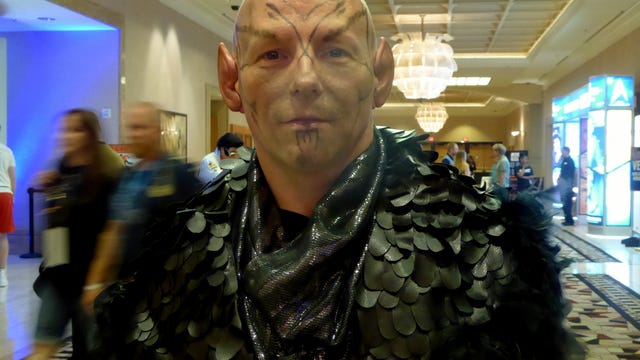
Related stories
- 10 worst Star Trek episodes, according to the fans
- Whoopi Goldberg shares 'Next Gen' secrets at her first Star Trek convention
- Behind the seams of my Star Trek captain's costume
- Full coverage of Star Trek at 50
My dark-horse candidate for a Top 10 episode is the thoroughly entertaining "Trials and Tribble-ations" from "Deep Space Nine." It combines footage from the original "The Trouble with Tribbles" with an adventure featuring the "DS9" cast going back in time. It's got old-school uniforms, fun crossover action and plenty of cooing tribbles.
Jordan Hoffman, a writer for StarTrek.com and host of Engage: The Official Star Trek Podcast , led the discussion, organized the nominations and directed the passionate conversation as we whittled down the candidates. Spirited arguments led to this final consensus. Every episode on the list is fantastic, but the ultimate champion is deserving of its spot:
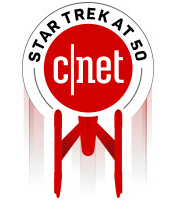
Click for full coverage.
10. The Magnificent Ferengi (Deep Space Nine) 9. In a Mirror, Darkly (Enterprise) 8. Balance of Terror (Original Series) 7. Chain of Command (Next Generation) 6. The Visitor (Deep Space Nine) 5. Yesterday's Enterprise (Next Generation) 4. Amok Time (Original Series) 3. The Inner Light (Next Generation) 2. In the Pale Moonlight (Deep Space Nine) 1. City on the Edge of Forever (Original Series)
It's interesting to note that "The Trouble with Tribbles" clung onto the No. 10 spot until the very end, when fans voted it out and replaced it with "The Magnificent Ferengi" from "Deep Space Nine." It was close.
"City on the Edge of Forever" makes for a nice counterpoint to the fans' choice of the series-ending stinker "These are the Voyages" from "Enterprise" as the worst episode. As bad as "Voyages" was, "City" represents one of Trek's finest moments. It's a love story. It has time travel. It has a great sacrifice. And it's a shining example of the chemistry and camaraderie between Trek's lead trio of Kirk, Spock and McCoy.
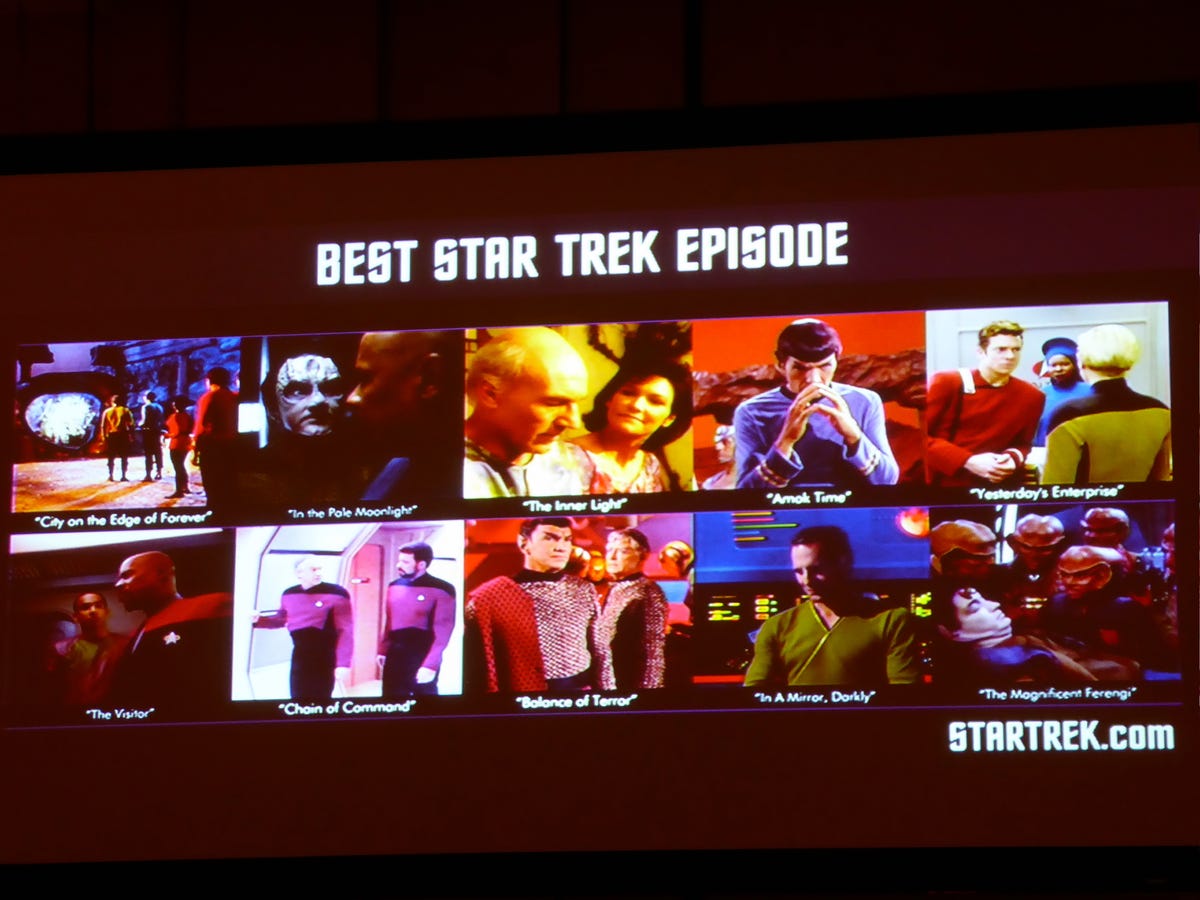
Fans' choice for the Top 10 Trek episodes.
Based on 2259 reviews
FREE U.S. Shipping
Free Shipping
We’re bringing the goods to you at no extra cost. Enjoy free U.S. shipping on every order, every day at Toynk.com. Valid for orders delivered within the contiguous United States only. Not applicable to Hawaii, Alaska, Puerto Rico, or U.S. Virgin Islands.
Earn Rewards While You Shop

- Action Figures
- Building Sets & Blocks
- Costumes & Accessories
- DIY & Model Kits
- STEM & Science Toys
- Vehicles & R/C Toys
- Arts & Crafts
- Board Games
- Brain Teaser Puzzles
- 100-Piece Puzzles
- 300-Piece Puzzles
- 500-Piece Puzzles
- 750-Piece Puzzles
- 1000-Piece Puzzles
- Adventure Puzzles
- Fantasy Puzzles
- Holiday Puzzles
- Retro Puzzles
- Travel Puzzles
- TV & Movie Puzzles

Buy 3, Get 1 Free

- Squishmallows
- Coffee Mugs
- Kitchen Tools
- Ramen Bowls
- Shot Glasses
- Travel Mugs
- Wine & Pint Glasses
- Advent Calendars
- Bathroom Extras
- Blankets & Throws
- Ceramic Planters
- Halloween Decor
- Snow Globes
- Storage Boxes
- Wall Art & Prints
- Books & Comics
- Notebooks & Journals
- Office Supplies
- Outdoor Goods
- Pool Toys & Games

- Hoodies & Sweaters
- Jackets & Outerwear
- Kitchen Aprons
- Leggings & Yoga Pants
- Robes & Pajamas
- Socks & Underwear
- T-Shirts & Polos
- Ugly Christmas Sweaters
- Belts & Suspenders
- Hats & Caps
- Keychains & Bag Clips
- Makeup & Prosthetics
- Ties & Cufflinks
- Wallets & Coin Purses
- Wigs & Beards
- Wrist Watches
- Backpacks & Bags
- Luggage Tags
- Lunch Boxes
- Adult Costumes
- Baby Costumes
- Child Costumes
- Costume Accessories
- Men's Costumes
- Teen Costumes
- Toddler Costumes
- Women's Costumes
- St. Patrick's Day
- Collectible Dolls
- Collectible Pins
- Geeki Tikis
- Prop Replicas
- Statues & Busts
- Vinyl Figures
- Baseball Cards
- Trading Cards
- Trading Sets

Garbage Pail Kids

- Adventure Time
- Back To The Future
- Black Panther
- Bob's Burgers
- Captain America
- Corpse Bride
- Game Of Thrones
- Golden Girls
- Harry Potter
- Hello Kitty
- Indiana Jones
- Jurassic Park
- Nickelodeon
- Nightmare Before Christmas
- Princess Bride
- Rick and Morty
- Sherlock Holmes
- Steven Universe
- Stranger Things
- Suicide Squad
- Angry Birds
- Assassin's Creed
- Call of Duty
- Five Nights At Freddy's
- Mass Effect
- Super Mario
- World of Warcraft
- Anime & Manga
- Coloring Books
- Disney Princess
- Heinz & Kraft
- Gifts for Him
- Gifts for Her
- Gifts for Kids
- Gifts for Dads
- Gifts for Moms
- Gifts for Students
- Gifts for Techies
- Gifts Under $10
- Gifts Under $20
- Gifts Under $40
- Gifts Under $50
- Gifts Under $75
- Gifts Under $100

- FANDOM FORCE REWARDS

10 Best Star Trek Episodes Ever: Our Top Picks (2024)
Star Trek, a sci-fi phenomenon that has boldly gone where no one has gone before, boasts a vast universe of great episodes across its various series.
If you want to watch the best Star Trek episodes, here's the list of the best episodes and why they're essential viewing for both longtime fans and newcomers alike.
Top 10 Standout Episodes From Star Trek Series
1. star trek: strange new worlds - "strange new worlds" (season 1, episode 1).

Original Airdate : May 5, 2022
Synopsis : Captain Pike ends his self-imposed isolation to save a missing officer from a covert mission.
Why We Like It : In the pilot episode of "Strange New Worlds," we're whisked away to uncharted territories alongside Capt. Pike and his Enterprise crew.
It really embodies the essence of the Star Trek franchise.
The first episode expertly balances character development with thrilling exploration, setting the stage for a respective series filled with adventure and discovery.
2. "Where No Man Has Gone Before" (Season 1, Episode 3)
Original Airdate : September 22, 1966
Synopsis : The 200-year-old USS Valiant's flight recorder tells a terrifying story of a magnetic storm at the galaxy's edge.
Why We Like It : As one of the earliest chapters of the "Star Trek: The Original Series," "Where No Man Has Gone Before" epitomizes the spirit of Star Trek.
This episode showcases the USS Enterprise crew facing a god-like entity, challenging the very limits of human understanding.
It's a classic example of the original series' exploration of philosophical themes and moral dilemmas.
3. "The Measure Of A Man" (Season 2, Episode 9)
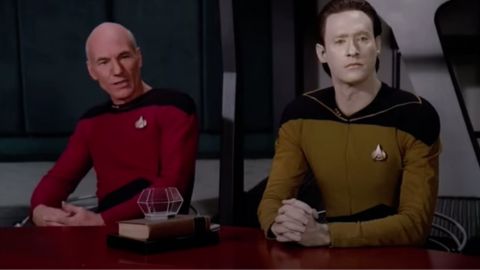
Original Airdate : February 13, 1989
Synopsis : When Data quits his job instead of being taken apart by an unskilled scientist, a hearing is held to decide if Data is property or a thinking being with rights.
Why We Like It : "The Measure Of A Man" from "Star Trek: The Next Generation" is widely regarded as one of the best episodes in the series.
The whole episode features thought-provoking dramas delving into the nature of sentience and artificial intelligence.
Captain Picard and Commander Riker, played by Patrick Stewart and Jonathan Frakes, must debate Data's own right. This one episode sets the Star Trek principle of respecting all life, no matter its form.
4. "The City on the Edge of Forever" (Season 1, Episode 28)
Original Airdate : April 6, 1967
Synopsis : When Dr. McCoy goes temporarily insane and alters history, Kirk and Spock pursue him to prevent disaster, but the cost is significant.
Why We Like It : In this iconic episode from the "Star Trek: The Original Series," Kirk and Spock travel back in time to 1930s Earth, confronting moral dilemmas and the consequences of altering history.
The episode restores history but remains heartbreaking. A good person must stop another good person from performing a heroic act to prevent the best villain from winning in history.
We can say that "The City on the Edge of Forever" is a masterclass in storytelling, blending sci-fi elements with the poignant human drama of our favorite characters.
5. "Amok Time" (Season 2, Episode 1)

Original Airdate : September 15, 1967
Synopsis : During the Pon Farr mating period, Spock must go back to Vulcan to meet his future wife, whom he was promised to since childhood.
Why We Like It : "Amok Time" explores the complex culture of Vulcan [ 1 ] as Spock grapples with intense emotions.
The entire episode profoundly delves into Spock's character, offering insight into his inner struggles and the depth of his friendship with Kirk (William Shatner).
6. "Far Beyond the Stars" (Season 6, Episode 13)
Original Airdate : February 9, 1998
Synopsis : Captain Sisko experiences a vivid vision of himself as a little-known science fiction writer in 1950s America.
Why We Like It : "Star Trek: Deep Space Nine" delivers a powerful and poignant episode with "Far Beyond the Stars."
This is where Captain Sisko experiences vivid hallucinations of life as a 1950s science fiction writer.
We like how this episode tackles issues of racism and inequality, transcending the sci-fi genre to deliver a message of hope and perseverance.
7. "Mirror, Mirror" (Season 2, Episode 4)
Original Airdate : October 6, 1967
Synopsis : A transporter mishap lands Captain Kirk's team in a different universe, where the Enterprise serves a barbaric empire.
Why We Like It : "Mirror, Mirror" introduced the infamous Mirror Universe, where familiar characters take on sinister personas, which is captivating to watch.
The episode features a transporter mishap that switches Captain Kirk and his crew with their evil counterparts from a parallel universe known as the "Mirror Universe" [ 2 ].
In this universe, the Star Trek's Enterprise serves the Terran Empire, a ruthless organization where officers are promoted through assassination.
"Mirror, Mirror" is a highly acclaimed episode of the original Star Trek series, and the Mirror Universe is revisited in later Star Trek parts.
8. "The Doomsday Machine" (Season 2, Episode 6)
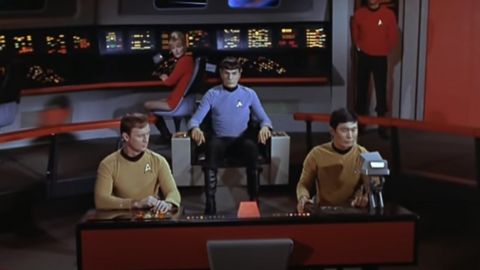
Original Airdate : October 20, 1967
Synopsis : The USS Enterprise finds the damaged USS Constellation and its distressed commodore, who is resolved to halt the enormous planet-destroying robot ship that destroyed his crew.
Why We Like It : "The Doomsday Machine" is a thrilling installment from the original series, featuring the crew of the Enterprise facing off against a planet-destroying weapon of mass destruction.
Many viewers hailed "Doomsday Machine" as the best episode for its tense atmosphere and compelling narrative. This is a must-watch for fans looking for drama and action in one episode.
9. "Blink Of An Eye" (Season 6, Episode 12)
Original Airdate : January 19, 2000
Synopsis : Voyager gets stuck orbiting a planet where time moves fast, with days passing in seconds, and becomes part of the local mythology.
Why We Like It : In "Blink Of An Eye," Voyager encounters a planet where time moves at an accelerated rate, leading to fascinating consequences for both the crew and the inhabitants.
The entire Voyager crew demonstrates their individual skills and teamwork to resolve the issue, reflecting how Star Trek influences real-world technology.
We like how this episode explores the concept of time dilation in a captivating and thought-provoking manner.
10. "The Next Generation" (Season 3, Episode 1)

Original Airdate : September 25, 1989
Synopsis : Wesley's experiment might be causing a computer problem that puts a scientist's important mission at risk.
Why We Like It : The pilot episode of "Star Trek: The Next Generation" introduced us to a new era of exploration with Captain Jean-Luc Picard at the helm of the USS Enterprise-D.
Like the "Star Trek: Picard," this sets the stage for the adventures to come, with the Borg collective [ 3 ] showcasing the diverse and dynamic crew of the flagship.
We can say that it's the top among three seasons, and if you're potential Star Trek fan who enjoys it, you'll likely be familiar with "The Next Generation" characters and may want to learn more about them.
Honorable Mentions
- "Q&A" - Short Treks Fifth Episode
- "Duet" - Star Trek: Deep Space Nine (Season 1, Episode 19)
- "Such Sweet Sorrow, Part 2" - Strange New Worlds (Discovery Season 2, Episode 14)
- "Second Contact" - Star Trek: Lower Decks Animated Series (Season 1, Episode 1)
- "No Small Parts" - Star Trek: Lower Decks Animated Series (Season 1, Episode 10)
- "I Have No Bones, Yet I Must Flee" - Star Trek: Lower Decks (Season 4, Episode 2)
What is the best Star Trek episode from the original series?
The best episode from the original franchise is often considered to be "The City on the Edge of Forever" (Season 1, Episode 28), praised for its compelling storyline and emotional depth.
If we were to pick just one episode, this one is a must-watch as it blends fan service, cool characters, drama, and thrilling moments.
What is the most controversial Star Trek episode?
One of the most controversial Star Trek chapters is "The Measure Of A Man" (Season 2, Episode 9) from "Star Trek: The Next Generation," due to its exploration of artificial intelligence and ethics.
But other controversial episodes include:
- "Code of Honor" (Season 1, Episode 3) for misogyny, racism, and sexism
- "Conspiracy" (Season 1, Episode 24) for gore contents
- "Harbinger" (Season 3, Episode 15) for nude scenes
- "These Are the Voyages..." (Season 4, Episode 22) for unnecessary death and disappointing series finale
What is the saddest Star Trek episode?
One of the saddest Star Trek chapters is "The Visitor" (Season 4, Episode 3) from "Star Trek: Deep Space Nine," which explores the profound emotional impact of loss and sacrifice.
Also considered one of the saddest Star Trek chapters is "Course Oblivion" [ 4 ] from the fifth season of "Star Trek: Voyager," which depicts the demise of the entire USS Voyager crew.
It begins with the joyous wedding of Lt. B'Elanna Torres and Lt. Tom Paris, but their bliss is swiftly shattered.
What is the scariest Star Trek episode?
One of the scariest Star Trek chapters is "The Tholian Web" (Season 3, Episode 9), featuring a tense and claustrophobic atmosphere as the crew faces a mysterious threat from the Tholian species.
Final Thoughts
These episodes represent the best of Star Trek, each offering a unique and memorable experience that resonates with franchise fans. Star Trek offers a galaxy of standout episodes across its various series, each showcasing the franchise's enduring appeal.
From iconic moments like "The City on the Edge of Forever" to thought-provoking dramas like "The Measure Of A Man," these episodes exemplify the best of Star Trek's exploration of humanity, morality, and adventure.
Whether you're a seasoned fan or new to the final frontier, these episodes are essential viewing. Dive into the rich history of Star Trek's universe and explore its vast potential.
For all your Star Trek needs, visit Toynk today and explore our Star Trek collection to start your own interstellar journey. Free shipping within the contiguous USA, so order now!
References :
- https://exoplanets.nasa.gov/news/1374/vulcan-may-not-be-real-but-spocks-home-system-is/
- https://www.popularmechanics.com/science/a60178516/dark-mirror-universe/
- https://ew.com/article/1997/05/16/borg-collective/
- https://memory-alpha.fandom.com/wiki/Course:_Oblivion_(episode)
Continue reading

30 Best Star Trek Quotes: Inspirational Sayings (2023)

10 Best Kirby Games of All Time (2024 Updated)
Leave a comment
All comments are moderated before being published.
This site is protected by reCAPTCHA and the Google Privacy Policy and Terms of Service apply.
Free U.S. Shipping
Free shipping for every order, every day for the contiguous U.S.
Help Center
We are available Monday - Friday to answer your questions at [email protected]
Secure Payment
Your payment information is processed securely
Need to contact us? Just send us an e-mail at [email protected]

Star Trek's 10 Best Monster Episodes
- Star Trek embraces peace but also explores monster movie elements for some thrilling episodes.
- Shows like Voyager & Next Generation weave classic monster movie themes with sci-fi twists.
- Even as monsters take center stage, empathy remains a core theme in the Star Trek universe.
Star Trek has a message of peace and tolerance and seeing beyond the surface, but it's not above doing an all-out monster movie from time to time. From its inception in 1966, Star Trek has taught audiences not to judge alien species by appearances . For example, Star Trek: Voyager villains Species 8472 were terrifying, Alien -inspired creatures, who turned out to be benevolent aliens that had been driven to violence by the actions of the Borg Collective. Earlier episodes like Star Trek: The Original Series ' "Devil in the Dark" revealed hidden emotional depths to a creature that was ostensibly a disgusting rock monster.
Despite Star Trek 's message of empathy, sometimes the writers can't resist creating scary monsters and super creeps. Star Trek has always drawn on the history of science fiction, and the big monster movies popularized by studios like RKO are no exception . Over nearly six decades, Star Trek TV shows have drawn on classic monster movies like The Thing From Another World and King Kong , giving them a Gene Roddenberry-style twist.
10 Times Star Trek Went Full-On Horror And Gave Us Nightmares
Star trek: voyager, season 2, episode 15, "threshold", story by michael de luca, teleplay by brannon braga.
Star Trek: Voyager 's notorious salamander episode , "Threshold" begins as an exploration of theoretical transwarp barriers and becomes something more akin to The Phantom of the Opera or King Kong . When Lt. Tom Paris (Robert Duncan McNeill) breaks the transwarp barrier, he begins experiencing some bizarre side effects. Breaking the transwarp barrier has triggered a strange evolution in Paris' body, which turns him into a salamander, who decides they need a mate in the form of Captain Kathryn Janeway (Kate Mulgrew).
...the monster movie elements ensure that "Threshold" is never boring.
There are some obvious monster movie parallels in "Threshold", from the way that the reptilian Paris carries an unconscious Janeway like the Phantom of the Opera to the body horror of the Voyager helmsman's transformation. The climax of the notorious Star Trek: Voyager episode, in which the "monster" that is now Paris fights off the crew to take Janeway as his mate, is pure King Kong . It's a Voyager episode that is rightly panned for its lack of narrative cohesion, but the monster movie elements ensure that "Threshold" is never boring.
Star Trek: The Next Generation, Season 7, Episode 19, "Genesis"
Written by brannon braga.
Star Trek: The Next Generation season 7, episode 19, "Genesis" is essentially The Island of Dr. Moreau set aboard the USS Enterprise-D. Captain Jean-Luc Picard (Patrick Stewart) and Lt. Commander Data (Brent Spiner) return to the Enterprise to discover that the crew has devolved into various terrifying monsters. For example, Lt. Reginald Barclay (Dwight Schultz) is de-evolved into a spider-like creature, while Lt. Worf (Michael Dorn) devolves into a savage proto-Klingon that tries to kill Picard. The cause of these transformations is a mistake made by Dr. Beverly Crusher (Gates McFadden) while reactivating a cell that would have given Barclay immunity to the flu.
Gates McFadden injects what could have been a very silly story with genuine tension.
Although the science is just as dubious as Star Trek: Voyager 's "Threshold", Star Trek: The Next Generation season 7, episode 19, "Genesis" has the benefit of being much more atmospheric. Interestingly, "Genesis" was directed by Dr. Beverly Crusher actor Gates McFadden , who injects what could have been a very silly story with genuine tension. The climax, where Picard tries to fend off an attack from a prehistoric Worf, while Data tries to concoct a cure using the DNA of Nurse Ogawa's unborn baby, is well directed by McFadden, giving this daft TNG outing an exciting monster movie vibe.
"Genesis" was the only episode of Star Trek: The Next Generation to be directed by Gates McFadden.
Star Trek: Every Actor Who Also Directed Episodes Or Movies
Star trek: the original series, season 1, episode 26, "the devil in the dark", written by gene l. coon.
"The Devil in the Dark" is a classic Star Trek monster episode , because it hinges on Captain James T. Kirk (William Shatner), Lt. Commander Spock (Leonard Nimoy), and Dr. "Bones" McCoy (DeForest Kelley) learning to understand a creature beyond their understanding. Investigating a supposed monster that is attacking a mining operation on Janus IV, they soon discover that the titular " devil in the dark " is no monster, but a mother protecting their young. It's thanks to Kirk and Spock's open-mindedness that the miners manage to avert the destruction of the entire Horta race .
The scene in which Kirk has to reason with the baying mob invokes images of the villagers with torches and pitchforks in the climax of Universal's classic monster movie, Frankenstein .
From a visual effects perspective, the actual Horta in Star Trek: The Original Series may look hokey by today's standards , but it tells a story about the need for empathy. TOS' cave monster isn't able to communicate with the miners, and so has to resort to violence. Similarly, the miners want violent recriminations from the "monster" that killed their colleagues. The scene in which Kirk has to reason with the baying mob invokes images of the villagers with torches and pitchforks in the climax of Universal's classic monster movie, Frankenstein . Thanks to Kirk, however, the Horta has a happier ending than Frankenstein's monster.
Star Trek: Deep Space Nine, Season 2, Episode 12, "The Alternate"
Teleplay by bill dial, story by jim trombetti and bill dial.
In one of Constable Odo's best Star Trek: Deep Space Nine episodes , a mysterious monster stalks the corridors of DS9 late at night. It's believed to be the mysterious sample that Odo (Rene Auberjonois) and scientist Dr. Mora Pol (James Sloyan) brought back from the Gamma Quadrant. However, in reality, it's Odo, who is under the influence of mysterious alien toxins, and the stress of seeing his "father" again. "The Alternate" is a fun Star Trek spin on Robert Louis Stevenson's The Strange Case of Dr. Jekyll & Mr. Hyde , that has some genuinely unnerving moments of horror.
Odo's monstrous alter-ego is less Mr. Hyde, and more like the titular Blob from the classic 1958 sci-fi monster movie.
Odo's transition into the monster toward the end of the episode is horrifying to watch as he rants and raves while struggling to remain in a solid state. Odo's monstrous alter-ego is less Mr. Hyde, and more like the titular Blob from the classic 1958 sci-fi monster movie. Interestingly, Dr. Julian Bashir (Alexander Siddig) doesn't categorically confirm it's the alien toxins that caused the transformation, suggesting another cause. As the gelatinous monster bears down on Dr. Mora Pol, it becomes clear that the real cause of the transformation is Odo's father issues.
All 4 Star Trek Characters Played By James Sloyan
Star trek: voyager, season 3, episode 12, "macrocosm".
Star Trek: Voyager has many creepy episodes , but "Macrocosm" is the most overt monster episode. Like Star Trek: The Next Generation 's "Genesis", also written by Brannon Braga, "Macrocosm" has a silly concept that is realized like a survival horror movie. The monsters faced by Captain Janeway and the Doctor (Robert Picardo) are effectively giant viruses that become airborne, infecting those they come into contact with. To repel the viral infection of the USS Voyager, the Doctor created an antigen which Janeway eventually detonated inside the holodeck, killing the assembled macroviruses.
"Macrocosm" finally gave Captain Janeway her Ellen Ripley moment.
"Macrocosm" got a wryly funny sequel in Star Trek: Lower Decks ' season 4 premiere, "Twovixed", but the episode itself is a decent homage to the Alien franchise. As the Star Trek franchise's first female captain, it's great to see Janeway getting to be an action hero like Captain Kirk in Star Trek: The Original Series , or Picard in Star Trek: First Contact . While the monsters themselves weren't anywhere near as terrifying as Alien 's Xenomorph, "Macrosm" finally gave Captain Janeway her Ellen Ripley moment.
Star Trek: Discovery, Season 1, Episode 3, "Context is for Kings"
Teleplay by gretchen j. berg, aaron harberts, and craig sweeny.
The disgraced Michael Burnham (Sonequa Martin-Green) is given a second chance after her mutiny aboard the USS Shenzhou in a Star Trek: Discovery monster episode. "Context is for Kings" explores what happened to the USS Glenn, the second of Discovery 's crossfield-class starships . Following a catastrophic accident while experimenting with spore drive technology, the ship's entire crew were killed, save for the tartigrade creature they had captured and wired to the spore drive. Freed from its shackles by the accident, the creature rampaged through the Glenn, killing a Klingon boarding party and turning its attention to Burnham and her away team .
The true monster in Star Trek: Discovery season 1, episode 3, "Context is for Kings" is Starfleet themselves.
The true monster in Star Trek: Discovery season 1, episode 3, "Context is for Kings" is Starfleet themselves. The cruelty that the crew of the USS Glenn had shown to the tartigrade was unbecoming of Starfleet, and showed how far they were willing to diverge from their principles to defeat the Klingon Empire . Captain Gabriel Lorca (Jason Isaacs) hammers this point home by having the tartigrade brought aboard the USS Discovery, taunting it as it tries to break free from the forcefield.
Jason Isaacs 10 Best Acting Roles (Including Star Trek: Discoverys Lorca)
Star trek: lower decks, season 4, episode 2, "i have no bones yet i must flee", written by aaron burdette.
Star Trek: Lower Decks introduced Moopsy into the canon in the season 4 episode, "I Have No Bones Yet I Must Flee". Visiting an alien menagerie, newly promoted Lt. junior grade Beckett Mariner (Tawny Newsome) and Commander Jack Ransom (Jerry O'Connell) had to conted with Moopsy, a soft fluffy creature that also happened to drink bones . Mariner and Ransom came up with a suitably irreverent Lower Decks solution to their problem, by punching out Ransom's teeth and using them as treats to lure the Moopsy back into its cage.
Moopsy is basically a monstrous Tribble, unable to control its base urges.
Moopsy was the sort of creation that could only feature in the irreverent world of Star Trek: Lower Decks , and yet it plays on existing creatures in the canon. Moopsy is basically a monstrous Tribble, unable to control its base urges. However, Mariner and Ransom don't kill the creature to save themselves, they find a humane - if slightly painful - solution to their situation. Not only that, but Mariner also unmasks the truly dangerous monsters - greedy humans seeking to bulk up their business portfolios , in this case by staging a hostile takeover of an alien menagerie.
Star Trek: Strange New Worlds, Season 1, Episode 9, "All Those Who Wander"
Written by davy perez.
"All Those Who Wander" combines the classic Star Trek: The Original Series episode "Arena" with Alien to provide a terrifying episode of Star Trek: Strange New Worlds . The vicious Gorn babies that are encountered by the Enterprise away team are relentless, rampaging through the ship and killing everything in their path. It's through the noble sacrifice of Lt. Hemmer (Bruce Horak) that the away team is able to get back to the safety of the USS Enterprise. However, the scars of the terrifying encounter between the Enterprise and the Gorn carry over into Strange New Worlds season 2 .
The Gorn infants move like raptors, drawing comparisons with the climax of Steven Spielberg's Jurassic Park
Because there's genuine dramatic stakes and a cost to life, Star Trek: Strange New World 's Gorn survival horror movie is the best version of the subgenre after the classic movie, Star Trek: First Contact . As an hour of television, it wears its genre influences on its sleeve, particularly the similarities between the icy crash site with the colony in Aliens . However, it's not just the Alien franchise that Star Trek: Strange New Worlds riffs on in "All Those Who Wander". The Gorn infants move like raptors, drawing comparisons with the climax of Steven Spielberg's Jurassic Park .
Complete History Of The Gorn In Star Trek
Star trek: the next generation, season 1, episode 23, "skin of evil", teleplay by joseph stefano & hannah louise shearer.
Armus (Ron Gans) in Star Trek: The Next Generation , is a truly monstrous creation, and even refers to himself as " evil " . Unlike the Horta in Star Trek: The Original Series , Armus isn't attacking the Enterprise away team to protect its children, he's doing it because he's a monster. A black, oily mass of everything impure and evil rejected by a " race of Titans ", Armus was abandoned on the planet Vagra II . There, he fantasized about torturing any visitors to the planet, but he quickly got bored after killing Lt. Tasha Yar (Denise Crosby).
Tasha Yar was no red shirt, and her death at the hands of the monster of the week makes "Skin of Evil" an impactful entry in the TNG canon.
"Skin of Evil" is one of Star Trek 's best monster episodes because, like "All Those Who Wander", it takes a toll on the characters. Star Trek: The Next Generation loses Tasha Yar to this monster, which proved that it would be a very different show to Star Trek: The Original Series . A TOS version of "Skin of Evil" would have played out in a similar fashion, but with the deaths of some disposable red shirts thrown in . Tasha Yar was no red shirt, and her death at the hands of the monster of the week makes "Skin of Evil" an impactful entry in the TNG canon.
Star Trek: The Original Series, Season 1, Episode 5, "The Man Trap"
Written by george clayton johnson.
Star Trek 's best monster episode is also its very first, setting the tone for those that would follow . Star Trek: The Original Series , season 1, episode 5, "The Man Trap", features a Salt Vampire that feeds on salt, which can also shapeshift to take the form of anyone that can help it achieve its goals. In essence, "The Man Trap" is Star Trek 's take on the 1951 movie The Thing From Another World , later remade by John Carpenter as The Thing . Both the Star Trek episode and the Thing movies center on a shapeshifting creature that feeds on the human characters.
"The Man Trap" was chosen by the network as the first episode of Star Trek: The Original Series to air due, in part, to its strong monster-of-the-week.
Both iterations of The Thing and Star Trek: TOS season 1, episode 5, "The Man Trap" also play on paranoia and being unable to trust your own eyes . In "The Man Trap", the Salt Vampire has the ability to take the form of the woman most desirable to each of the male characters. For example, Dr. McCoy believes it to be his former lover, Nancy, driving a wedge between him, Kirk and Spock. "The Man Trap" was chosen as the first episode of Star Trek: TOS to air in 1966, and its influence can be felt in Star Trek 's monster episodes nearly 60 years later.
All these episodes of Star Trek are available to stream on Paramount+.
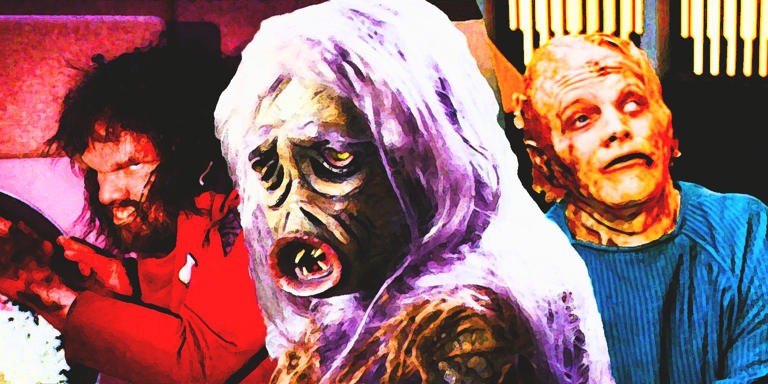
10 Best The Originals Episodes, Ranked
The Originals was only ever meant to be a spinoff to The Vampire Diaries. Yet the series delivered some truly unforgettable episodes.
Despite being a spinoff, The Originals is largely considered superior to The Vampire Diaries due to its well-crafted plotlines, incredible twists, and compelling episodes in its five-season run. Klaus and his siblings captivated fans in the original series, but their lives in The Originals had higher stakes and an overall better focus on the family, and some episodes in the show truly shined bright on their own.
The Originals thrived on messy family dynamics and drama, which was plentiful throughout the show but especially clear in these episodes. Seeing the raw power of the Original vampires, which was totally missing in The Vampire Diaries , was also one of the most thrilling elements of the spinoff. These episodes stood out when the show was airing and continue to hold a special place in fans' hearts.
10 "The River In Reverse" Showed Klaus' Might
The Originals is full of amazing moments , and fans were treated to some of them in Season 1 itself. Klaus had detested Marcel's rule over the French Quarter from the beginning, and this episode sees that rivalry come to a head. While Marcel sets his entire force on Klaus, it is not nearly enough for the mighty Orginal hybrid.
In an epic fight scene, Klaus singlehandedly takes on dozens of vampires, proving that a great fight scene can enhance any episode. The complex family dynamic of the Mikaelsons is also in play, as Elijah is earlier bitten by Klaus and struggling slowly with the pain, and Rebekah chooses to be on Marcel's side this time. This episode depicted Klaus at his most dangerous.
9 "No More Heartbreaks" Leaned Into the Tragedy of Klaus and Cami
One of the defining qualities of The Originals was that the show did not shy away from tragedy. Triumphant moments were always juxtaposed by incredibly sad ones, and "No More Heartbreaks" depicted this in a beautiful manner. Cami may have been Klaus' love interest, but she had become like family to Hayley and the other Mikaelsons.
An awful encounter with Lucien left her with a bite on her arm, one that was steadily draining her life force with its venom. Usually ready with Plan A, B, and C, Klaus chooses to console a sick Cami in the compound, while Freya looks for magical cures, Vincent and Marcel look for clues in Cami's apartment, and Elijah and Hayley go to the Bayou to get a wolf antidote. It was an episode where the collective efforts of every supernatural being couldn't save Cami's precious life.
8 "Savior" Depicts a Mikaelson Christmas
10 most twisted scenes in the vampire diaries.
Nothing with the Mikaelson family is ever ordinary, and Christmas becomes eventful in "Savior." A cursed Rebekah sets her sights on her own family, ready to attack them, while Freya works double time to look for a cure. Unfortunately, the Original family's witch becomes the Strix's target herself. Hayley's plan for a quiet Christmas with Hope and Jackson becomes a distant dream.
However, the Mikaelsons and the wolves manage a sort of celebration, and Klaus is urged by a cursed Rebekah to follow on his feelings for Cami. While the two share an impassioned night, Klaus (and the audience) is shocked to find her body bloodied and seemingly dead the next morning. This episode delivered twists on twists, making it a memorable holiday episode.
7 "The Map of Moments" Was All About Family With Some Startling Revelations
In what could easily be one of the most emotional but also shocking episodes of the beloved CW show , Klaus and Hayley finally get to meet their daughter, whom they had sent away to Rebekah to protect. The moment is tender and sweet, and Rebekah revives old family traditions to mark her entire family coming together after a long time.
On the other hand, family secrets come pouring out, as Esther reveals that they were cursed to give away their firstborn to Dahlia. Not only did this mean that Hope was in danger, but also that they had an eldest sibling somewhere out there. Kol's tragic equation with his family is revealed in his conversations with Davina, and Esther begins to transition into the thing she hates the most.
6 "The Bloody Crown" Saw The Originals Fold
The Originals always won until "The Bloody Crown." A wronged Marcel, now an Upgraded Original, returns to the Mikaelsons for revenge, even as Elijah and Klaus grieve their betrayal. Even though Elijah killed him, he put Klaus up for trial for all of his sins, some of which were truly abhorrent. Still, every member of the family is bitten fatally, while Freya is poisoned and Rebekah suffers from her curse.
The appeal of this episode lay in the genius of saving the Mikaelsons, even when they were all on the brink of death. Freya put them in a Chamber de Chasse to preserve their life forces as Hayley looked for cures, but all of it depends on Klaus finding a way to stay alive through his trial. He succeeds but undergoes months of torture to keep his family alive.
5 "Farewell to Storyville" Skips Action For Emotion
Who does matt end up with in the vampire diaries.
Putting three angry Originals in one room is a bad (but interesting) idea, and that's a large part of "Farewell to Storyville." Klaus learns that Rebekah was the one who called Mikael to New Orleans to kill Klaus, which understandably enrages the hybrid. When they are locked in the City of the Dead cemetery by a witch's boundary spell, Rebekah, Elijah, and Klaus have no choice but to face what their family has become.
Centuries of tensions and emotions come to the surface as Klaus nearly stakes Rebekah with the White Oak for her betrayal. In a twist, he sets her free to live her life far from the mess that was their family. This was what Rebekah longed for for centuries, and it shows some amount of growth in Klaus that he let her go. "Always and Forever" was the very foundation of the Mikaelson clan, but this episode showed clearly that individual growth for each Original was more important, sometimes.
4 "Ashes to Ashes" Is a Bittersweet Triumph for Klaus
In an episode where Klaus goes just a bit too far , "Ashes to Ashes" is full of thrills at every turn as the Mikaelsons race to save Hope and vanquish Dahlia. Klaus works hard to gain Dahlia's trust, and when he does, he sets the wheels turning on his plan to save his family. Sure, it involves betraying the mother of his child and his brothers, but that's how all of Klaus' plans go.
Rebekah tricks Davina into bringing Esther back, the only witch who can defeat Dahlia. Ultimately, it is Dahlia's love for Esther that puts both sisters to rest, reaffirming the Mikaelson bond and how it goes back many generations before them. However, Klaus' betrayals leave Hayley and many others in a tough spot.
3 "A Streetcar Named Desire" Was a Thrilling Crossover
There is nothing quite as exciting as a crossover episode for fans of both shows, and The Vampire Diaries collided with The Originals in the best way possible when Stefan came to New Orleans. The younger vampire is on the run from Rayna Cruz, and Klaus introduces him to Freya. However, Stefan finds a greater purpose: saving Klaus' Original sireline , which is in danger from The Strix.
This episode saw an explosive end to many plotlines, from The Strix to Aurora and Tristan. Davina also severs Klaus' sireline from him, which is one of the most notable developments. Overall, the clash of two worlds in the same universe was absolutely gripping.
2 "From a Cradle to a Grave" Was Heartbreaking
10 strongest werewolves in the vampire diaries universe, ranked.
The whole of Season 1 was spent protecting Hayley and her unborn child, who finally came into the world in "From a Cradle to a Grave." For a show so situated in violence, The Originals focussed on the complexities of Hope's birth and how the entire family almost broke in trying to keep her safe. Hayley dies after childbirth; Hope is taken away but comes back to life as a hybrid because she had Hope's blood in her. It is the upgrade she truly deserved.
Klaus and Hayley have to make the heartbreaking decision of telling the world that Hope died, giving her instead to Rebekah so that she may stay alive and away from the witches who wanted her. "Always and Forever" was the foundation of this episode.
1 "Give 'Em Hell Kid" Showed the Complex Relationship Between Marcel and The Originals
Season 3 was spent in trying to thwart the prophecy that Freya kept seeing: the one that showed the Originals meeting their final, irreversible deaths. As the "Beast" was revealed to be Marcel, events unfolded in a furious rush, tumbling into each other as Elijah raced to prevent the prophecy from becoming the truth. When Klaus goes to meet Marcel on the bridge, he has no intention of killing him.
Elijah rushes in on the scene, tearing out Marcel's heart to save his brother, but triggers the prophecy himself as Marcel had taken Lucien's serum already. Betraying Marcel was like hurting a son and a brother, which leads to an extreme reaction from the newly Upgraded Marcel. This action-packed episode was perhaps the most well-crafted one in The Originals.
The Originals
*Availability in US
Not available
Screen Rant
I'm glad star trek: tng never did a mirror universe episode.
The Mirror Universe worked great on Star Trek: The Original Series, but it would have felt out of place on Star Trek: The Next Generation.
- TNG's moral crew would clash with a dark Mirror Universe, making an episode feel out of place.
- Mirror Universe concept worked for TOS but wouldn't fit TNG's serious and optimistic tone.
- TNG found other ways to explore alternate realities without resorting to Mirror Universe episodes.
Star Trek: The Next Generation never did a Mirror Universe episode, and that ultimately worked in the show's favor. Star Trek's Mirror Universe first debuted in the classic Star Trek: The Original Series episode, "Mirror, Mirror," in which Captain James T. Kirk (William Shatner) and some of his crew find themselves in a dark alternate universe that mirrors their own. In the Mirror Universe, the ISS Enterprise serves the Terran Empire instead of the USS Enterprise as part of the United Federation of Planets' Starfleet. Crew members are tortured when they make a mistake and the chain of command is often determined by officers murdering their superiors.
Despite the divergence of events in Star Trek' s Prime Universe and the Mirror Universe, many people ended up in the same place in both realities. For example, the entire crew of the USS Enterprise was the same in both universes, but their personalities were drastically different. Simply put, t he Mirror Universe is a world of opposites , although Spock (Leonard Nimoy) is logical in every universe. While the Mirror concept worked well for a one-off story with Captain Kirk and his Enterprise crew , the Mirror Universe would have felt out of place on Star Trek: The Next Generation for a number of reasons.
In Star Trek: Picard season 2, Q (John de Lancie) altered the past of the Prime Universe, which resulted in the
Confederation of Earth, a "xenophobic authoritarian regime" much like the Mirror Universe.
Star Trek 10’s Best Mirror Universe Variants
Why a star trek: tng mirror universe episode wouldn't have worked, the mirror universe clashes with the tone of tng and its characters..
Captain Jean-Luc Picard (Patrick Stewart) and the cast of Star Trek: The Next Generation represent the most moral Star Trek crew, and "evil" versions of those characters would have felt cartoonish. The Mirror Universe worked with the campy tone of Star Trek: The Original Series and Kirk was already an emotional Captain, so it wasn't that hard to imagine an evil version of him. TNG , on the other hand, had a more serious and optimistic tone, and an evil Captain Picard would have likely been either too dark or too over-the-top. TNG did tell alternate universe stories, such as "Yesterday's Enterprise" and "Parallels," but they did it in a way that was new and unique rather than rehashing TOS ' Mirror Universe concept.
Although Star Trek: The Next Generation had some callbacks to Star Trek: The Original Series in its early seasons, Star Trek creator Gene Roddenberry wanted to distance TNG from TOS . "Mirror, Mirror" is generally regarded as one of classic Star Trek's best episodes, and it would have been difficult for any TNG episode to live up to that. Despite not doing a Mirror Universe episode, TNG found other ways to allow its actors to play different, and even evil, versions of their characters. Lt. Commander Data (Brent Spiner), for example, faced off against his evil twin brother Lore more than once, and multiple characters were possessed by alien entities.
Various non-canon tie-in novels and comic books have told Mirror Universe stories with Star Trek: The Next Generation's characters, beginning with Diane Duane's novel Dark Mirror in 1993.
Some Star Trek Shows Overused The Mirror Universe
The mirror universe began as a good concept but offers diminishing returns..
Star Trek: Deep Space Nine had five Mirror Universe episodes, beginning with DS9 season 2, episode 23, "Crossover." This episode revealed that Mirror Universe Spock had reformed the Terran Empire after Captain Kirk and his crew visited there in "Mirror, Mirror." Although his reforms initially proved successful, they led to the occupation of the Empire by the Klingon-Cardassian Alliance, which then became the dominant power. In the Mirror Universe, Terok Nor (space station Deep Space Nine) was commanded by Intendant Kira Nerys (Nana Visitor) , and Nana Visitor clearly had fun playing an evil version of Kira. However, with its overly sexualized characters and general campiness, the Mirror Universe storyline offered diminishing returns after the novelty wore off.
Star Trek: Enterprise's two-part "In a Mirror, Darkly" faired a bit better than DS9's Mirror Universe adventures, as it presented a self-contained story that took place entirely in the Mirror Universe and connected with TOS.
The Mirror Universe made more sense combined with the darker tone of Star Trek: Discovery , but it sometimes felt like too much for a Star Trek show. Still, the Mirror Universe of Discovery did provide the characters of Captain Gabriel Lorca (Jason Isaacs) and Emperor Philippa Georgiou (Michelle Yeoh), two of Star Trek's best new villains. After its appearance in multiple Star Trek shows, the Mirror Universe began to feel too much like a gimmick. It's a concept that works better when used sparingly, and it would have felt tonally out of place on Star Trek: The Next Generation.
Star Trek: The Next Generation, Star Trek: Deep Space Nine, Star Trek: Enterprise, & Star Trek: Discovery are available to stream on Paramount+.
Star Trek: The Next Generation
Star Wars: Who Is Nala Se?
This cloning expert contributes her genius intellect to the Empire's evil initiatives until her morals catch up with her.
The Star Wars franchise works overtime to ensure that the Empire remains one of the most evil organizations in fictional history. The antagonists leave no back unstabbed in their quest to dominate or destroy the galaxy. As the Republic shifts into the Empire, countless intelligent beings hitch their metaphorical wagon to the new power structure. They almost always pay for their mistakes. Kaminoan scientist Nala Se worked to aid the Republic's cloning efforts but experienced a change of heart in her later life.
Star Wars: The Bad Batch is the latest in a long line of solid animated Star Wars projects. While the live-action shows and movies struggle, Disney+ brings out fun new cartoons with impressive regularity. The franchise's animated sector houses its most creative ideas and compelling stories. Though many fans ignore the hours of streaming entertainment, they'll find countless enjoyable stories in a visually engaging package.
Star Wars: The Bad Batch - 12 Best Episodes, Ranked
How did nala se contribute to the clone wars.
Doctor Nala Se is the Chief Medical Scientist on the planet Kamino . Kamino is a remote aquatic world notable for its advances in technological and biological studies. The Kaminoans are isolationist geniuses who mastered genetic engineering over countless quiet generations. Divorced from the comings and goings of the Galactic Republic, Kaminoans dedicated themselves to perfecting the cloning process. Kamino and its exports remained obscure to most, but Jedi Master Sifo-Dyas discovered them. Sifo-Dyas experienced a premonition of nightmarish galactic conflict, prompting him to seek an army that could save the Republic. He approached Kamino in secret and requested their aid in growing clone troopers. This mistake allowed Count Dooku , Sifo-Dyas' old friend who recently fell to the Sith, to assassinate Sifo-Dyas and take over as benefactor. Nala Se oversaw the construction of the clone army under the recently redubbed Darth Tyranus.
Nala Se and Order 66
As the Chief Medical Scientist, Nala Se personally oversaw the installation of an inhibitor chip in every clone soldier. Tyranus pitched the biochip as a contingency plan and ordered it to be highly classified. Nala Se was one of very few people who knew about Order 66 before its activation. Se believed that the project protected her troopers against the potential threat of renegade Jedi . Nala Se could reasonably feign ignorance at this stage, but her actions only became more villainous as she continued her work with Darth Tyranus. During the Battle of Ringo Vinda, a clone trooper nicknamed Tup inexplicably and brutally murdered a Jedi. The soldier's actions threatened to reveal the hidden scheme, presenting Nala Se with a difficult choice. Se put Tup through several intense physical tests, silently certain that his behavior demonstrated a premature activation of his Order 66 chip. Darth Tyranus ordered Se to execute Tup to bury the secret. Before she could move, a fellow trooper nicknamed Fives conducted his own investigation and discovered the chip in Tup's brain.
Fives uncovered the biochip in every clone's skull, prompting Nala Se to start making excuses. She assured him that the chips balanced Jango Fett's difficult personality to create more predictable soldiers. Jedi Shaak Ti arranged an audience with Chancellor Palpatine to discuss Fives' discovery. Nala Se secretly drugged Fives, causing him to behave erratically and provide unreliable testimony. She added another lie, suggesting a viral infection pushed Tup into madness. Lucky for her, Fives lost all credibility after Palpatine framed him as a would-be assassin. Nala Se successfully hid her crimes by defaming, drugging, and eventually executing a dutiful soldier. Her actions remain nightmarish, but the Star Wars franchise provided an unexpected heroic turn for the character.
How did Nala Se slow down Project Necromancer?
Nala Se's change of heart came after she started working with a clone named Omega. The newly-established Empire decided to replace their clone armies with conscripted soldiers. This alerted Nala Se, who knew her people wouldn't be safe in a system that no longer needed them. She was correct, as the Empire quickly destroyed every Kaminoan settlement they could find. Nala Se became a slave under the Empire, forced to work on a new project. Project Necromancer was a secret Imperial initiative intended to perfect midi-chlorian transfer during the cloning process. The long-term goal would involve cloning Darth Sidious to allow him to live forever. Nala Se's discovered a perfect binder in Omega's blood, which may have allowed the project to continue. However, she worked tirelessly to defend Omega, sabotaging attempts to capture or test her former assistant. Finally, after the Empire discovered her subterfuge, Nala Se sacrificed her life by detonating a hand grenade in her laboratory. She died to bury the data, forcing the Empire to abandon Necromancer in favor of their Death Star idea .
Nala Se is a complicated figure in Star Wars history. Oddly enough, her evil actions and her heroic deeds involve making massive sacrifices to hide her own work. Though Nala Se is an inarguable villain during the Clone Wars , her change of heart is admirable. Without her sacrifice, Sidious may have reached his dream of immortality long before he inexplicably returned in Rise of Skywalker . Nala Se demonstrates the fascinating personal narratives that can emerge in a massive galaxy like Star Wars .
How Star Wars: The Bad Batch Embraces The Star Wars Jedi Games

IMAGES
VIDEO
COMMENTS
10. Mirror, Mirror (season 2, episode 4) 9. A Taste of Armageddon (season 1, episode 24) 8. The Menagerie, Parts I and II (season 1, episodes 12 and 13) 7. The Doomsday Machine (season 2, episode ...
14) A Private Little War. Image via CBS. Star Trek was offering a direct allegorical take on the Vietnam War in 1968 with a story that finds Captain Kirk in a moral dilemma. A planet of immense ...
9. Amok Time (Season 2) Season 2 of Star Trek kicked off with our first look at Spock's home planet, Vulcan. Leonard Nimoy's character had been the breakout character of the show the previous ...
1 The City On The Edge Of Forever: 9.3. The most celebrated episode of Star Trek not only by fans but by the world, "The City On The Edge Of Forever" sees Kirk, Spock, and Doctor McCoy trapped in New York City in 1930, right at the height of the Great Depression. As Kirk and Spock search for a crazed McCoy who had accidentally injected himself ...
On Netflix: Season 1, Episode 11. Netflix wants you to start watching TOS with "The Cage.". Resist! This is not a great way to start the series. "The Cage" was an unaired pilot for Star ...
The Enemy Within. "The Original Series" — Season 1, Episode 5. The transporter — the cause of, and solution to, so many "Star Trek" problems — accidentally splits Capt. Kirk (William ...
Ricardo Montaban's single appearance on the original series as the 1990s warlord Khan Noonien Singh set the stage for the undisputed greatest Star Trek film ever, The Wrath of Khan, set 15 years ...
1. Star Trek (1966-1969) TV-PG | 50 min | Action, Adventure, Sci-Fi. The Enterprise must decide on its response when a Romulan ship makes a destructively hostile armed probe of Federation territory. Director: Vincent McEveety | Stars: William Shatner, Leonard Nimoy, Mark Lenard, Paul Comi. Votes: 5,701.
With that in mind, here's a perhaps controversial list of the 21 greatest "Star Trek: The Original Series" episodes. 21. A Piece of the Action (Season 2, Episode 17) NBC. Although humorous moments ...
Introducing a planet-ending energy weapon 10 years before Star Wars, this episode features a real nail-biter of an ending. Fun fact for the continuity-conscious: Decker's son, Willard Decker ...
10. The Tholian Web. (Image credit: Paramount) Season 3, Episode 9. Original airdate: November 15, 1968. The heart of TOS was always the unlikely trio of Kirk, Spock, and McCoy, whose relationship ...
10 Best Star Trek (The Original Series) Episodes. Kirk and Spock must save their ship's crew when they are all declared killed in action in a bizarre computer simulated war where the actual deaths must nevertheless occur.
I t's hard to think of any other 1960s TV series with as much staying-power as Star Trek. 47 years after its launch it's spun-off four live-action series, one animated series, dozens of ...
As fans are rejoicing about currently having 5 Star Trek series in production at the same time, they might consider returning to the impetus of Gene Roddenberry's vision of the future in Star Trek: The Original Series. So much of the material that makes up the foundation of Star Trek lore, foundation, and canon comes from the '60s sci-fi classic, with plot points and storylines strongly felt ...
15 "The Menagerie". Paramount. Star Trek made the best out of its failed first pilot when it framed the entire episode, "The Cage", inside a new episode. "The Menagerie" focused on a court-martial ...
Best: Paramount Television. "The City on the Edge of Forever". First aired: April 6, 1967. The hands-down best episode of "Star Trek" is a riveting tale of time travel and altered history ...
By the time my generation got to watch Star Trek: The Original Series, the episodes often were being presented in top-ten marathons.When I was ten-years-old, for the 25th Anniversary of Star Trek ...
The City on the Edge of Forever is Star Trek: The Original Series' finest episode. This award-winning episode, written by legendary sci-fi author Harlan Ellison (with an assist from several show ...
Star Trek Beyond is the first of the new Trek films that embodies the classic series' adventurous spirit and hopeful tone. Seeing as how 2016 is the 50th anniversary of the USS Enterprise and its faithful crew, it seems fitting to take a look back at the series that started it all. Here are the ten best episodes of Star Trek, as chosen by a Trek nerd who will endanger his own life by saying ...
Subscribe to TrekCulture! http://whatculture.com/trekAnd follow us here: https://twitter.com/TrekCultureRead the original article here: https://whatculture.c...
4. Amok Time (Original Series) 3. The Inner Light (Next Generation) 2. In the Pale Moonlight (Deep Space Nine) 1. City on the Edge of Forever (Original Series) It's interesting to note that "The ...
The series originally aired from September 1966 through June 1969 on NBC. [1] This is the first television series in the Star Trek franchise, and comprises 79 regular episodes over the series' three seasons, along with the series' original pilot episode, "The Cage". The episodes are listed in order by original air date, [2] which match the ...
Instead, check out the 10 episodes listed below. Each is a classic that complements and crosses over with Strange New Worlds perfectly. The Menagerie (S1E11 and 12) Credit: Paramount/YouTube. In ...
Original Airdate: February 13, 1989. Synopsis: When Data quits his job instead of being taken apart by an unskilled scientist, a hearing is held to decide if Data is property or a thinking being with rights.. Why We Like It: "The Measure Of A Man" from "Star Trek: The Next Generation" is widely regarded as one of the best episodes in the series.. The whole episode features thought-provoking ...
Star Trek embraces peace but also explores monster movie elements for some thrilling episodes. Shows like Voyager & Next Generation weave classic monster movie themes with sci-fi twists. Even as ...
Despite being a spinoff, The Originals is largely considered superior to The Vampire Diaries due to its well-crafted plotlines, incredible twists, and compelling episodes in its five-season run. Klaus and his siblings captivated fans in the original series, but their lives in The Originals had higher stakes and an overall better focus on the family, and some episodes in the show truly shined ...
Star Trek: The Next Generation never did a Mirror Universe episode, and that ultimately worked in the show's favor.Star Trek's Mirror Universe first debuted in the classic Star Trek: The Original Series episode, "Mirror, Mirror," in which Captain James T. Kirk (William Shatner) and some of his crew find themselves in a dark alternate universe that mirrors their own.
Related Star Wars: The Bad Batch - 12 Best Episodes, Ranked As fans await the third season of The Bad Batch, these episodes from the first two seasons represent the very best moments from the series.